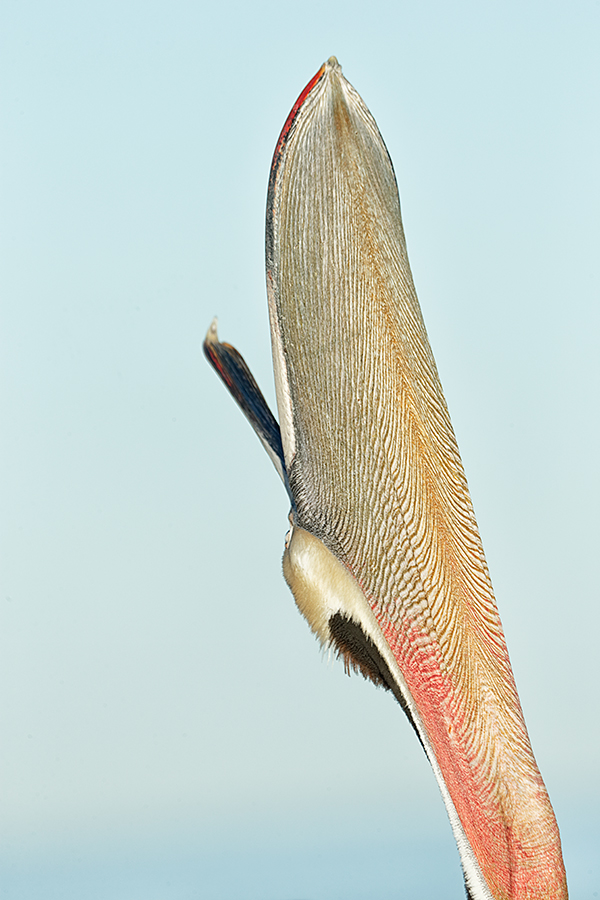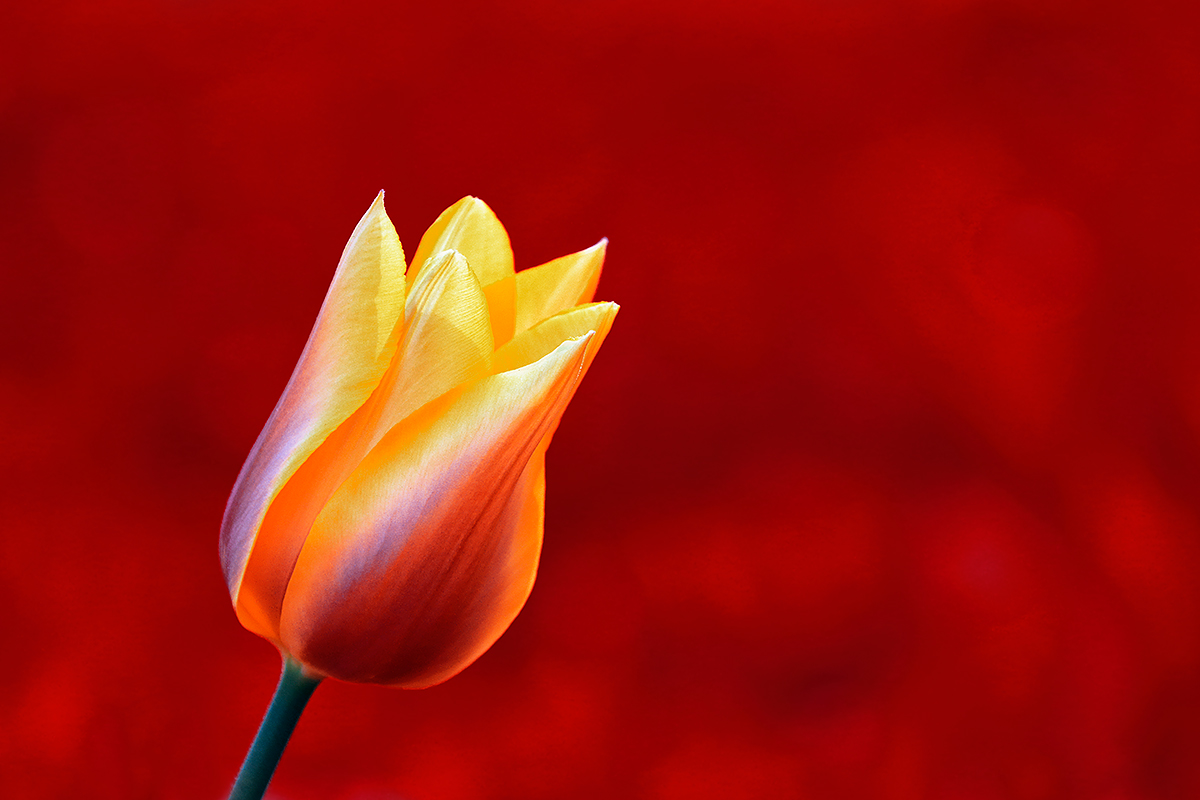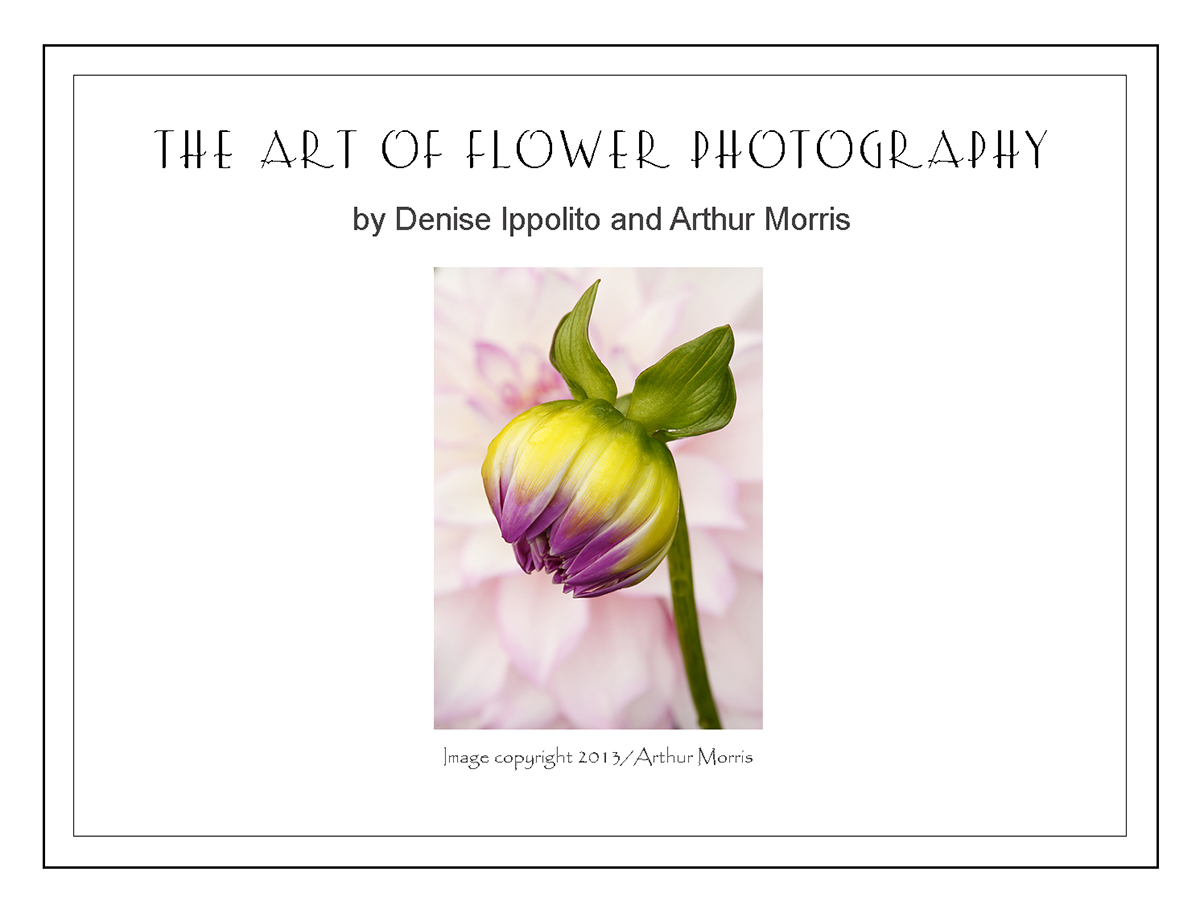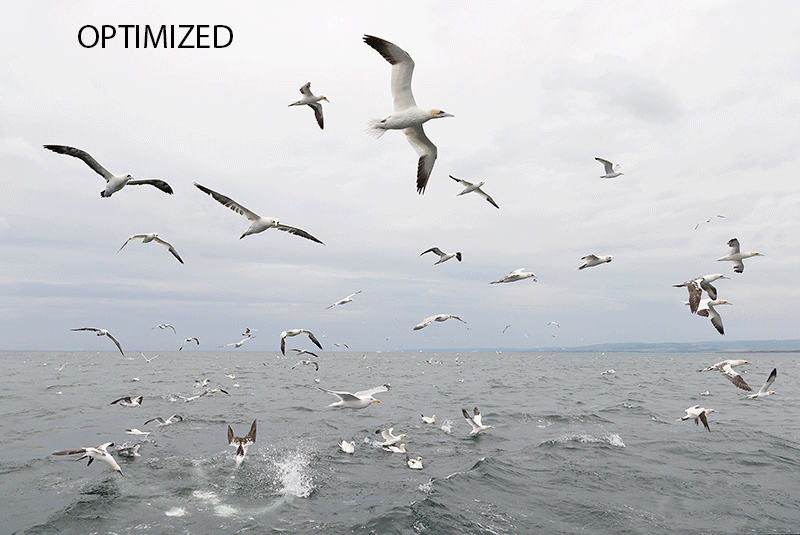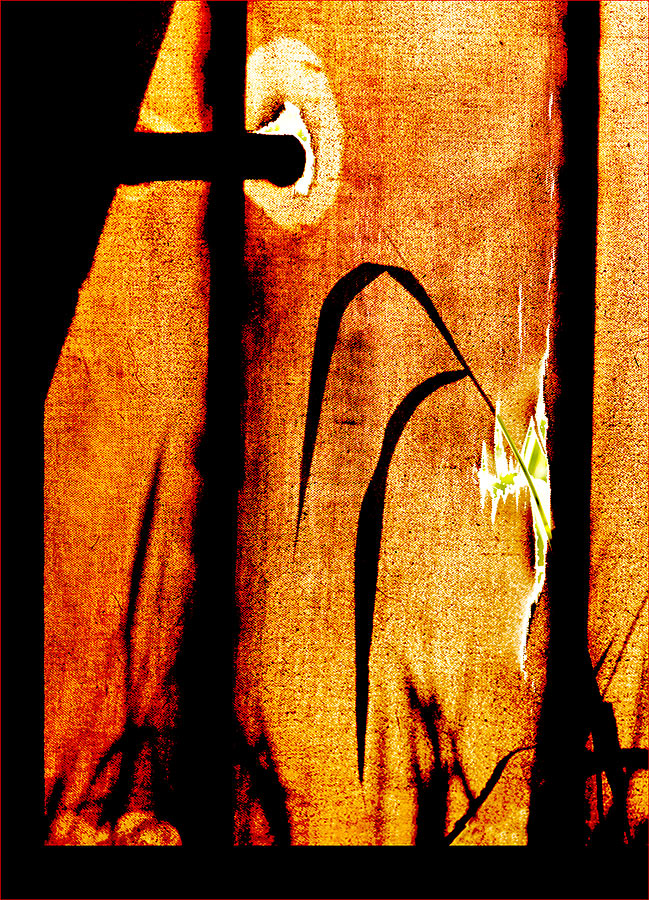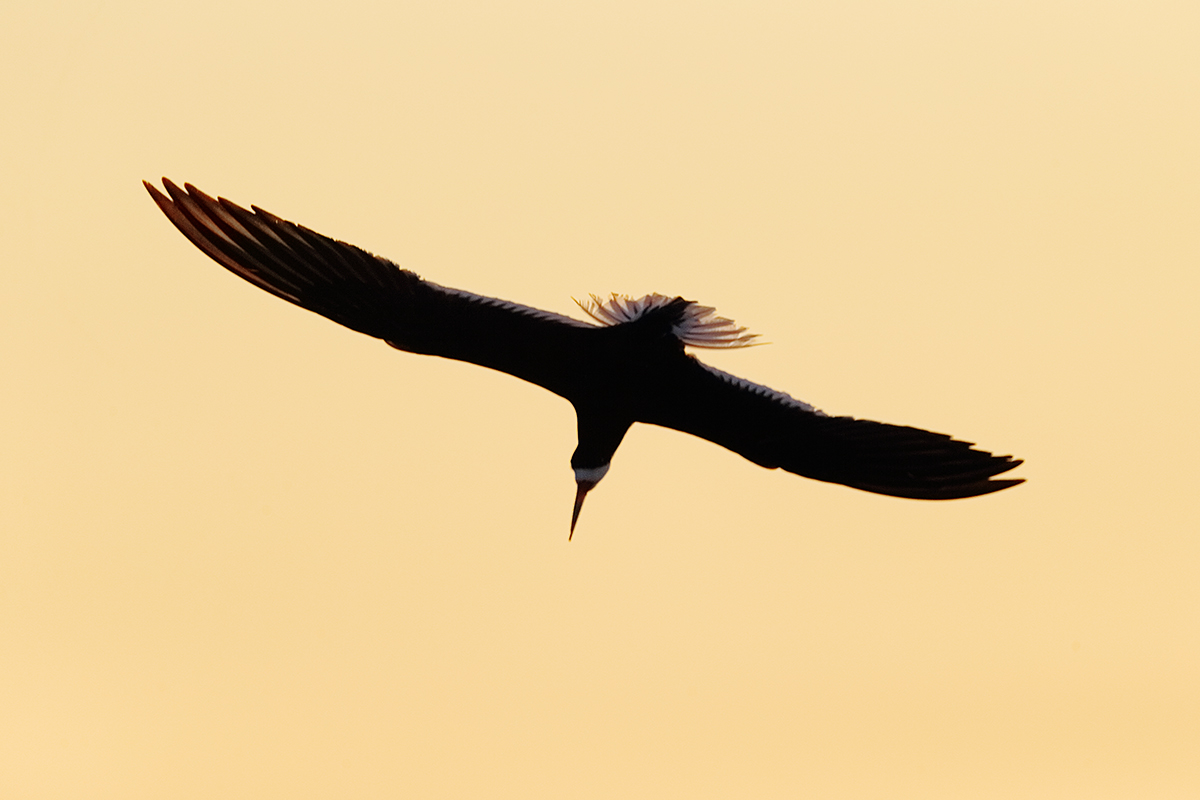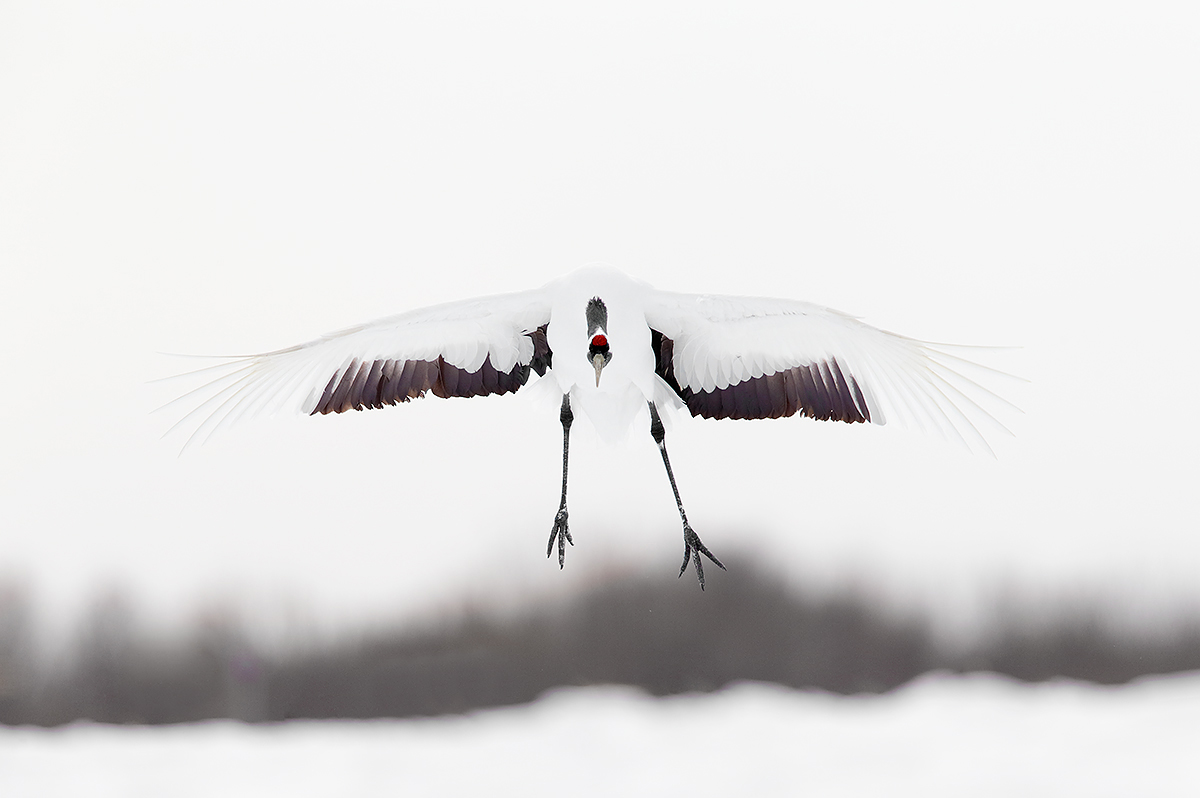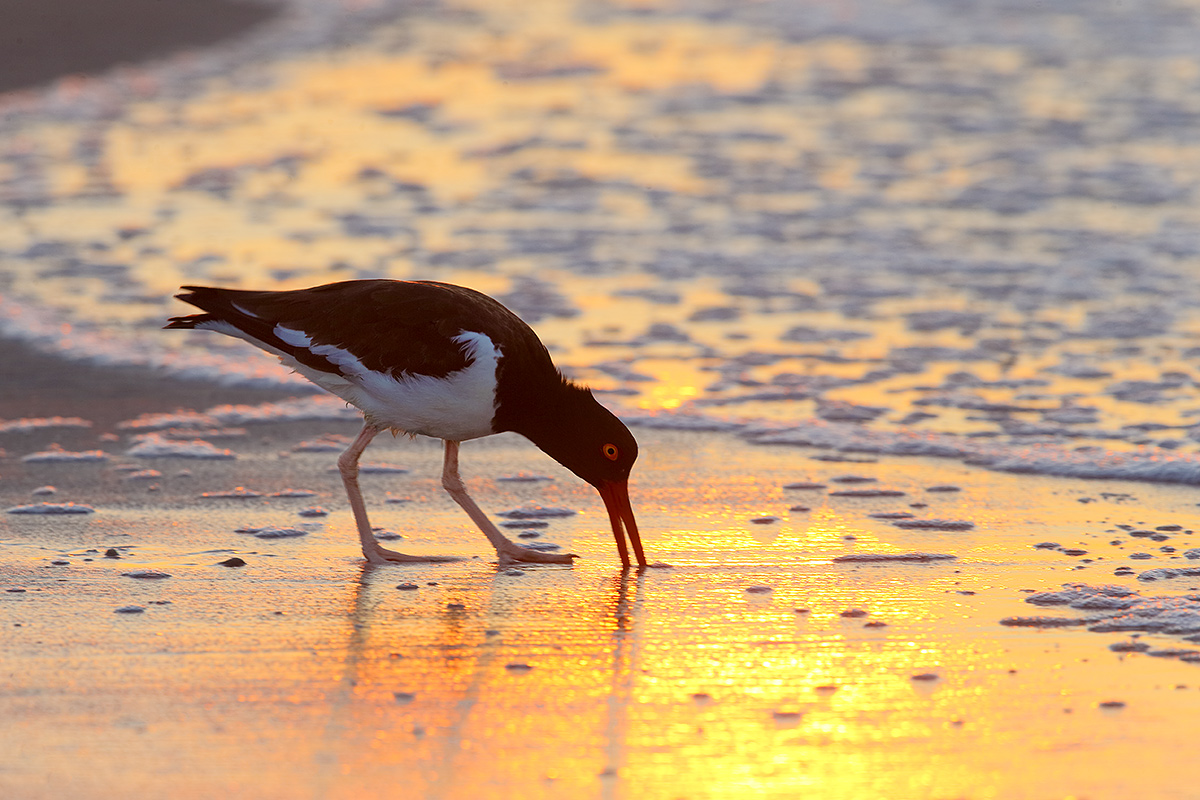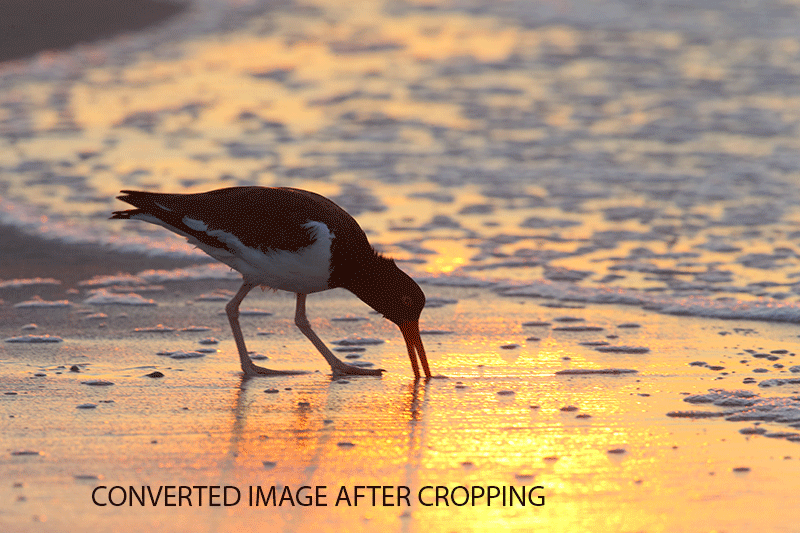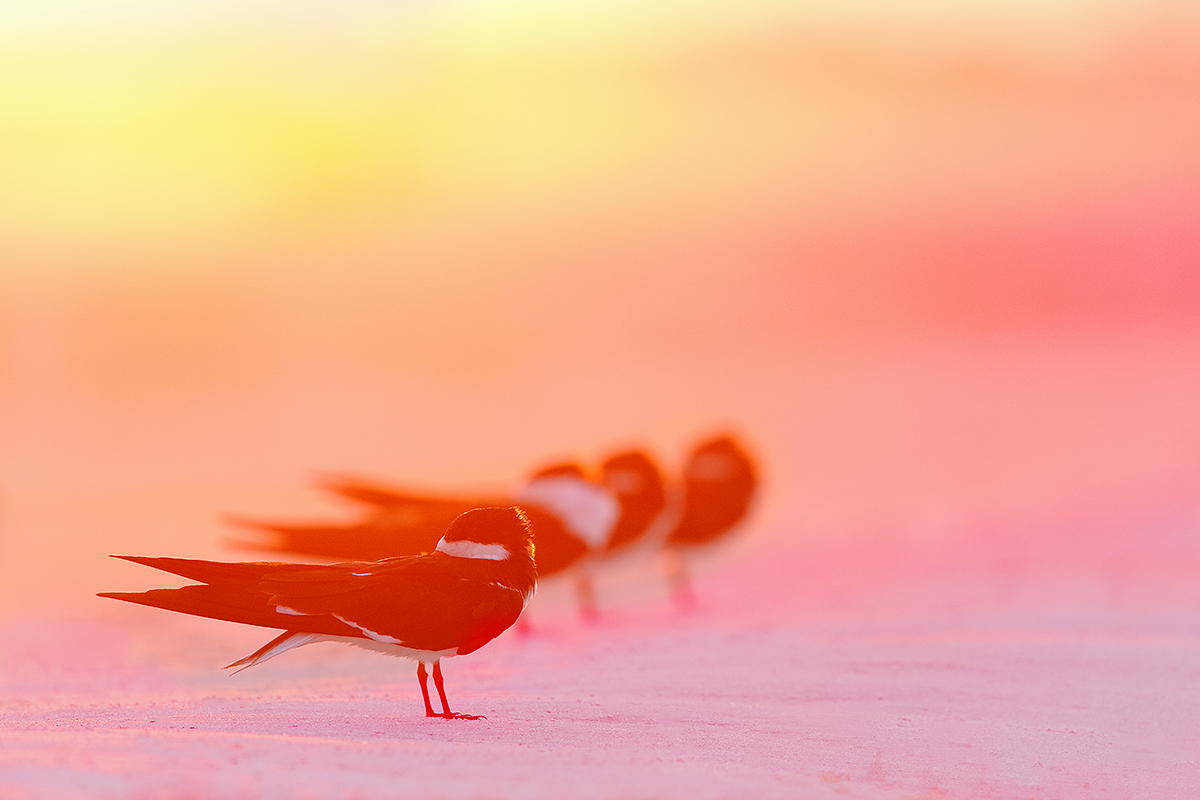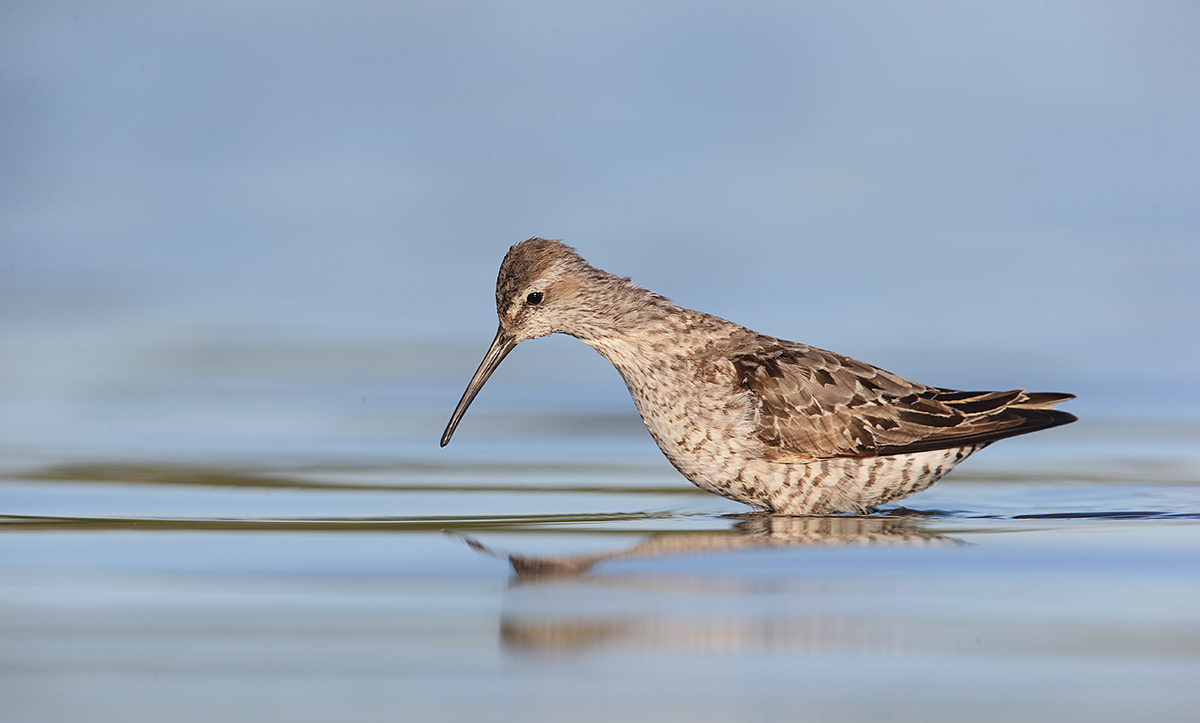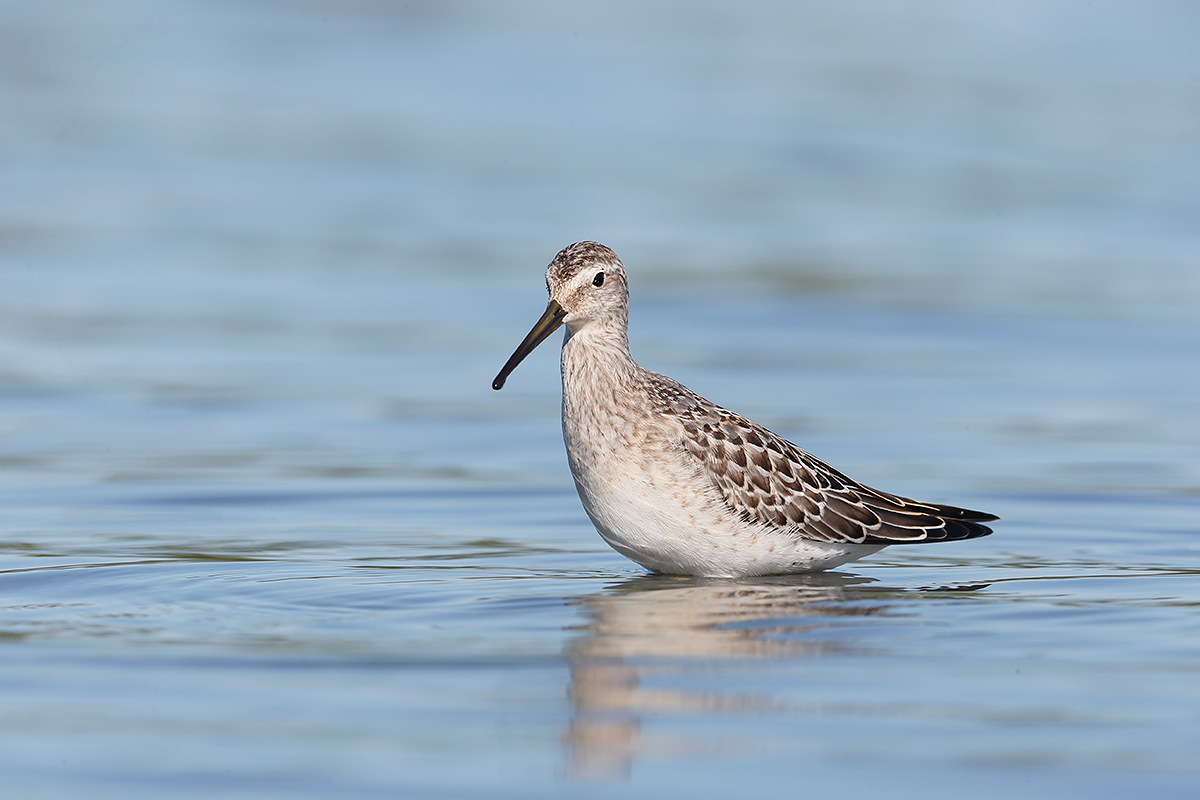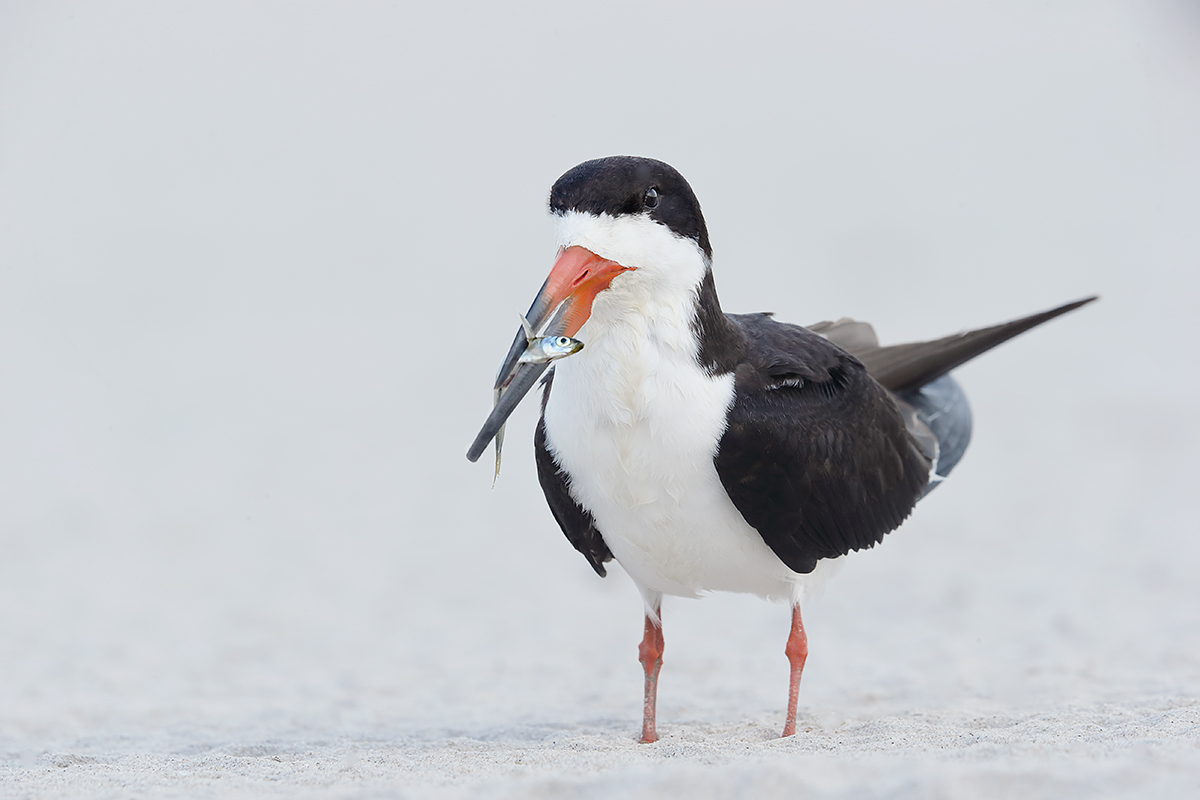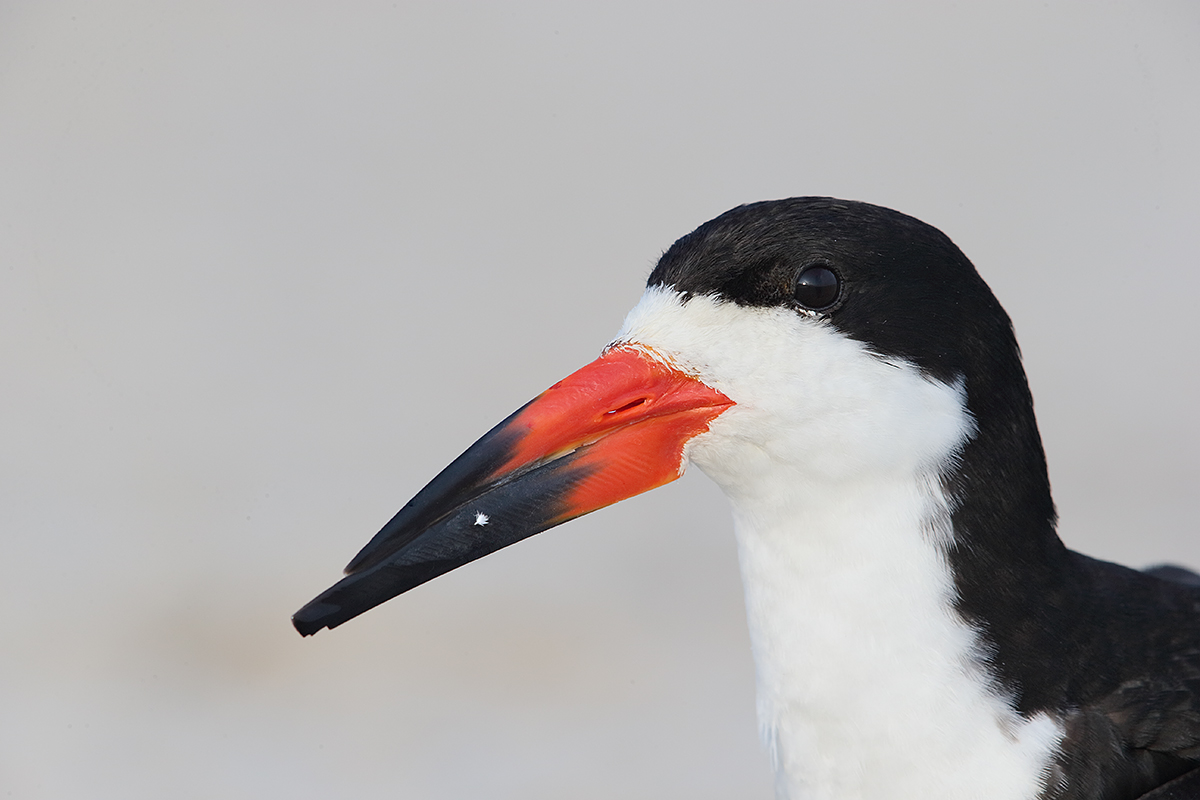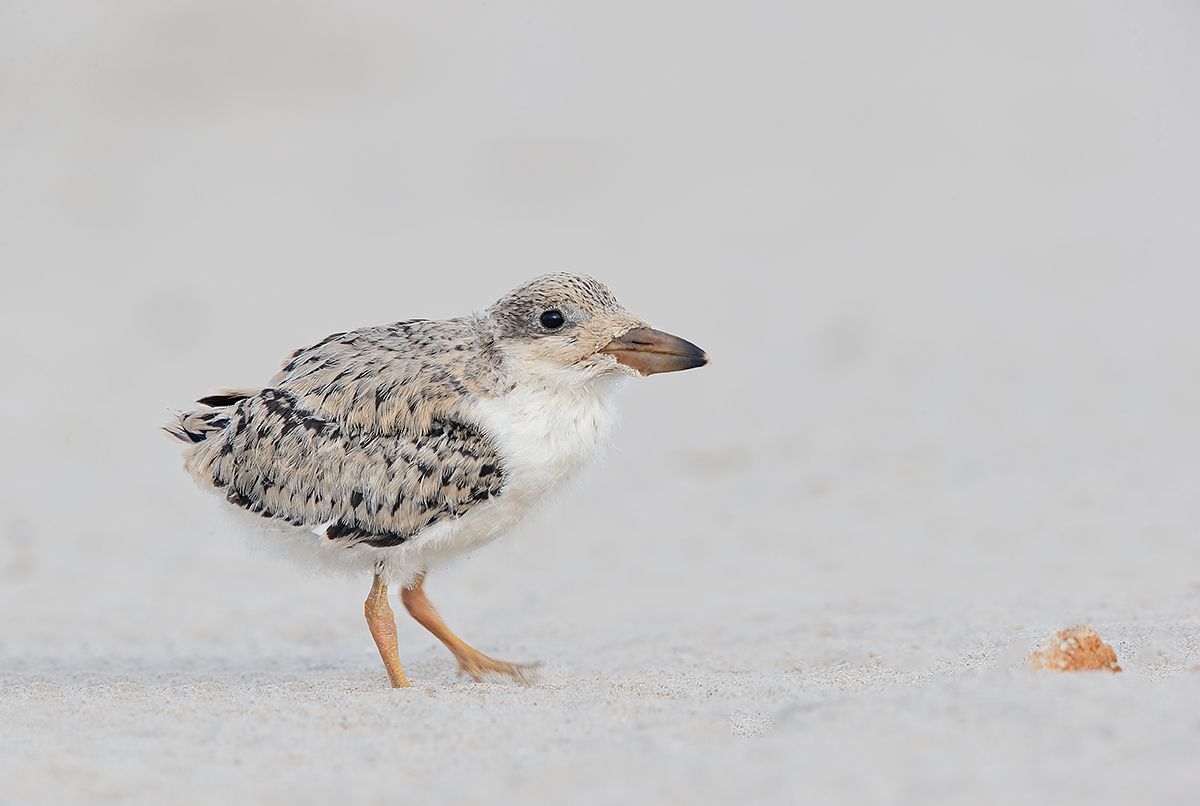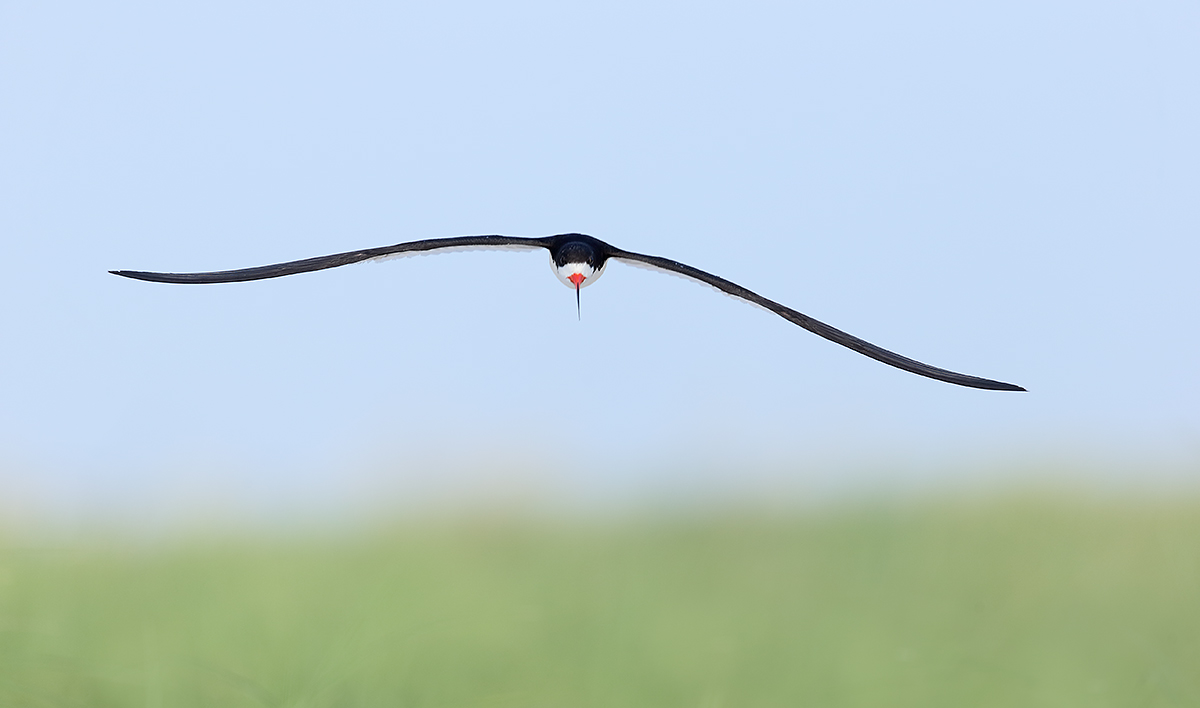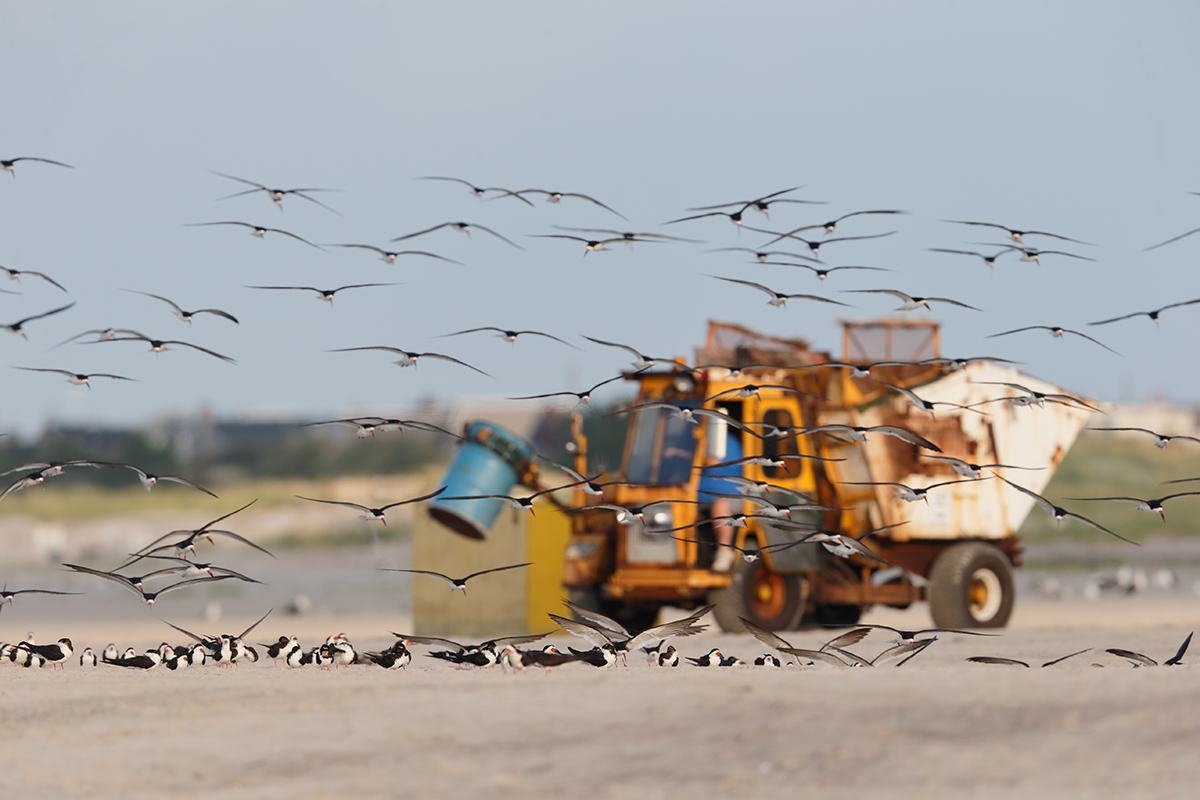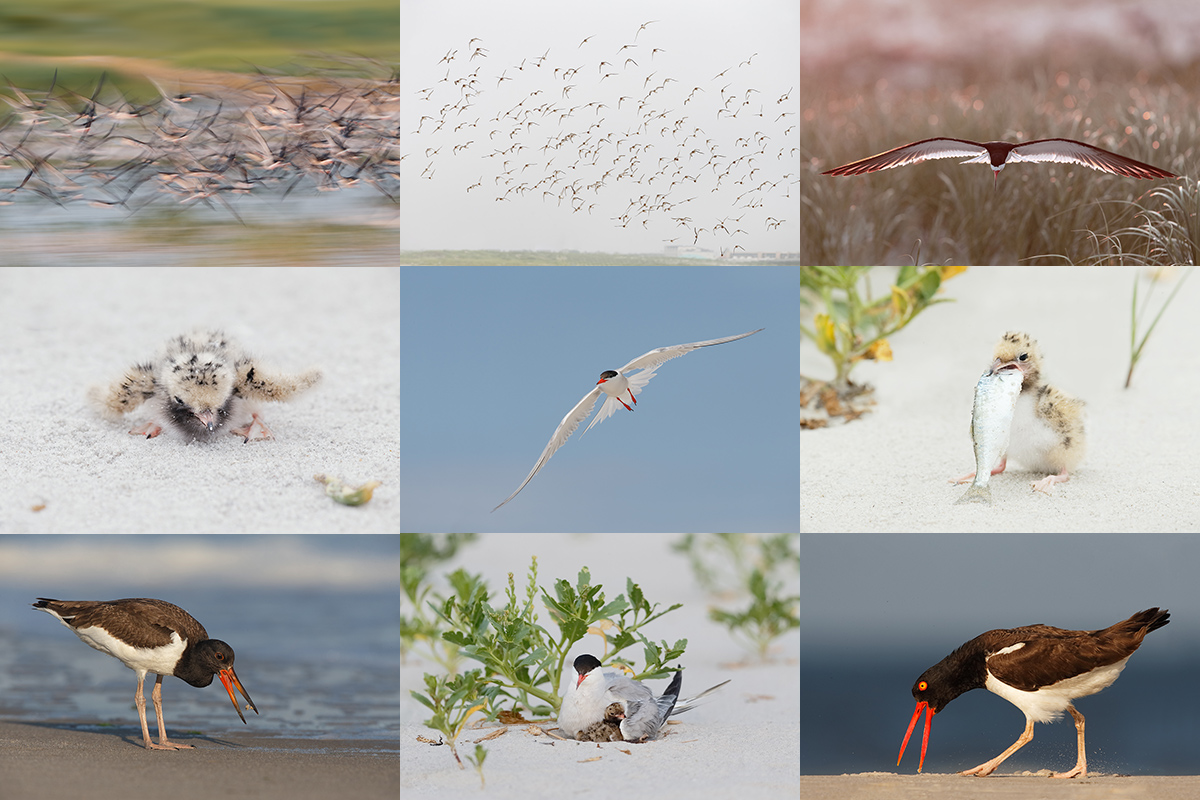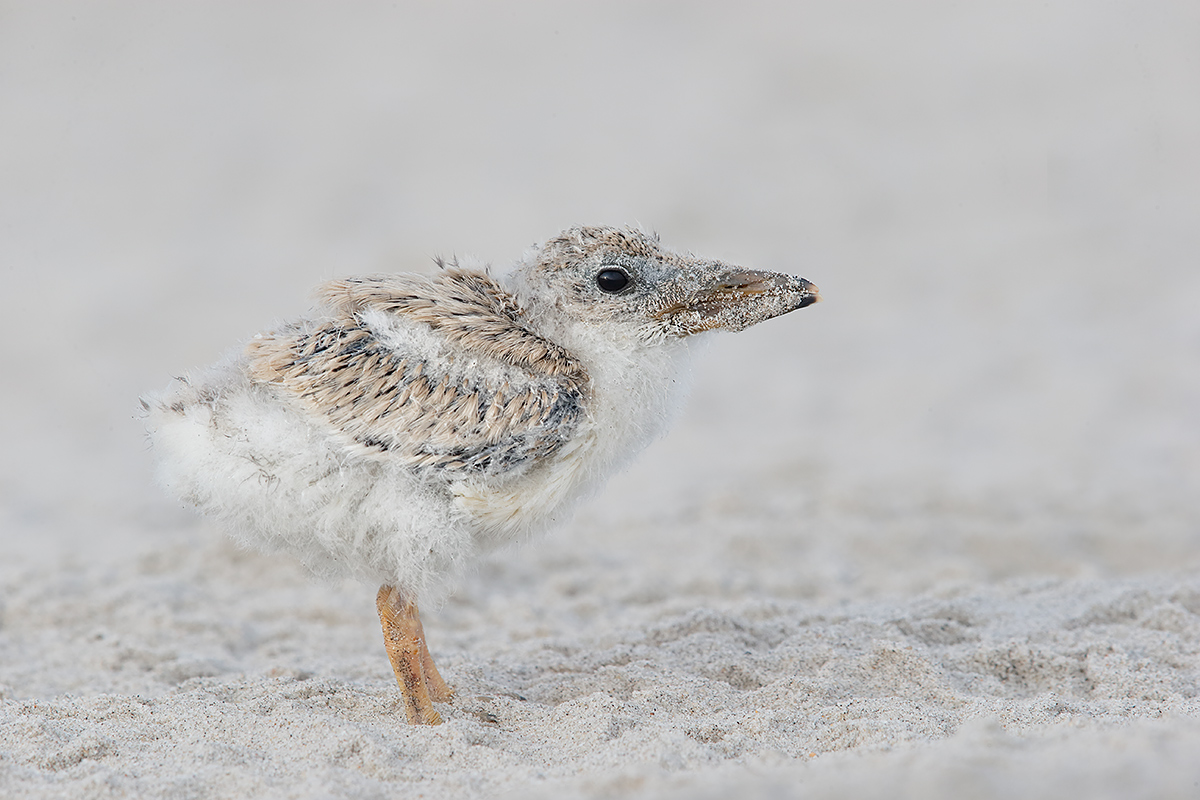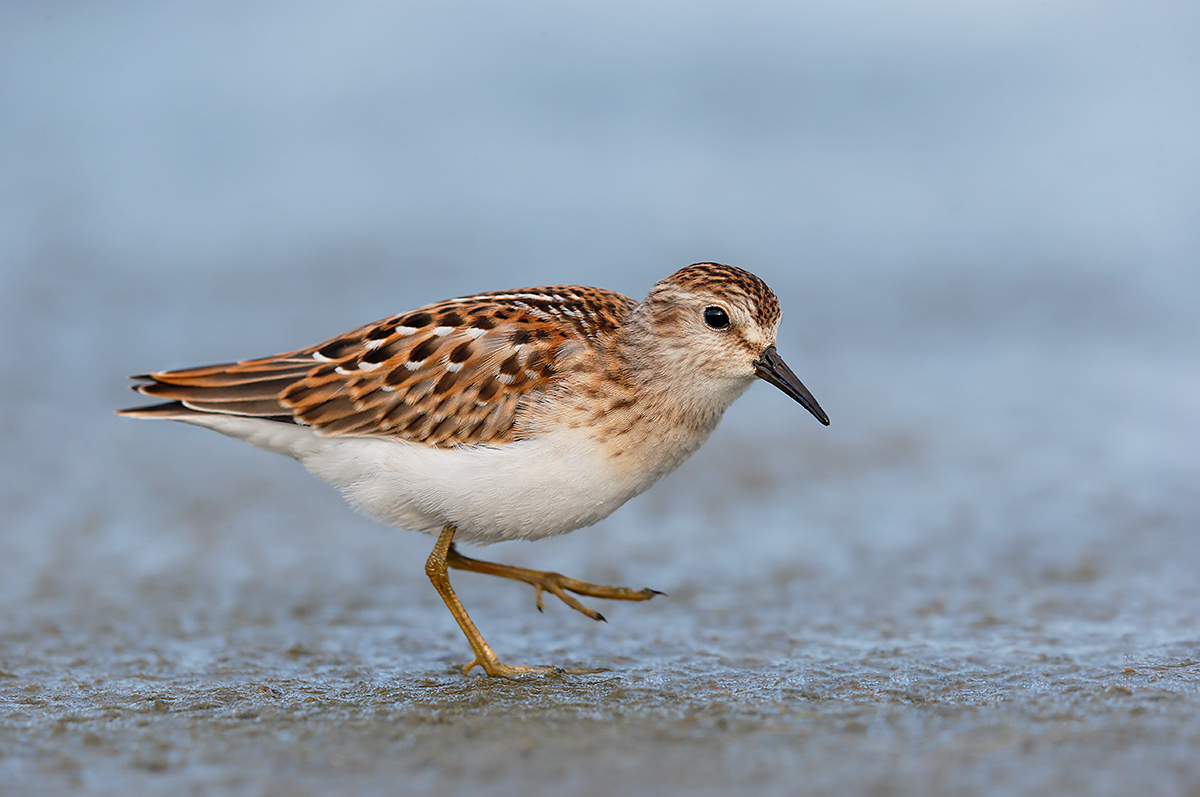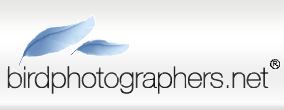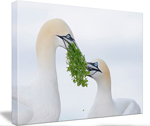September 11th, 2014 The Streak Continues: 285
This blog was published just before 7:00am from my home in Indian Lake Estates, FL. Yesterday I enjoyed another long, easy swim of just under a mile and another short nap. I spent another four solid hours working on the DPP 4.0 RAW Conversion eGuide, learning a ton as I go. This post, which took me about 4 hours to prepare, makes 285 in a row. 365 is well within sight….
As always, I would appreciate your using the BIRDS AS ART B&H affiliate links for all of your major gear, video, and electronic purchases, using our Amazon logo-link for all of your household purchases, and visiting the BAA Online Store for your tripod, tripod head, LensCoat, miscellaneous, accessories, and eGuide purchases as well. Please remember, web orders only. 🙂
You can find the following items in the Store: Gitzo tripods, Mongoose M3.6 and Wimberley heads, plates, low feet, and accessories, flash brackets, , Delkin e-film Pro Compact Flash Cards, LensCoat products, and our unique line-up of educational materials including ABP I & II, Digital Basics, Site and Set-up e-Guides, Canon and Nikon Camera Users and AF e-Guides, and MP-4 Photoshop video tutorials among others.
For the photographic stuff mentioned in the paragraph above we, meaning BAA, would of course greatly appreciate your business. Purchasing the items listed above from B&H actually hurts us :). Here is a huge thank you to the many who have been using our links on a regular basis and visiting the BAA Online store as well.
Great Used Photography Gear for Sale News
Mike Gotthelf’s 800mm f/5.6L IS and Walt Anderson’s EOS-1D Mark IV both sold this week. See more on selling your used photo gear through BAA below.
|
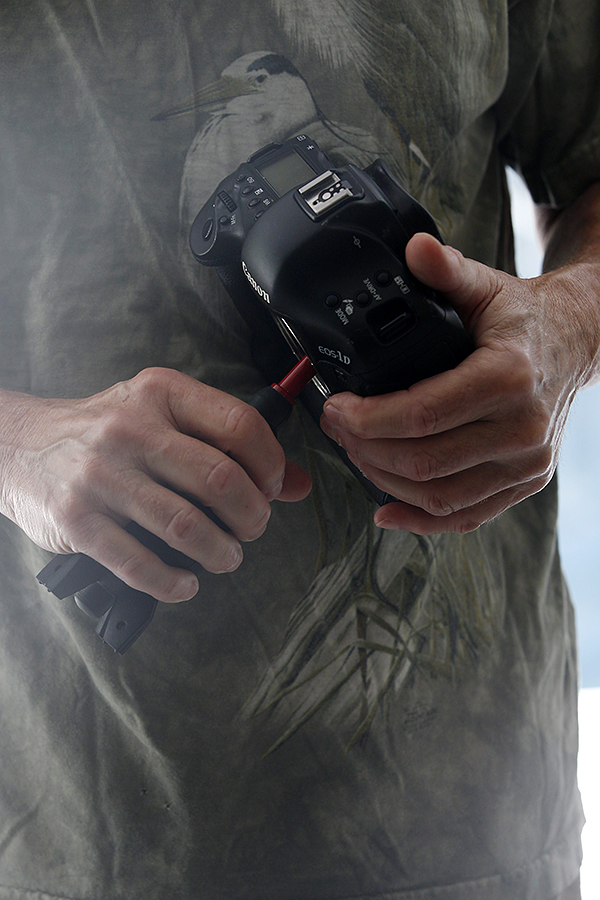
|
|
This image was created on the pool deck just outside my office door with the Gitzo 3532 LS carbon fiber tripod, the Mongoose M3.6 head, the Canon EF 70-200mm f/2.8L IS II USM lens (tripod-mounted at 90mm) and the Canon EOS-1D X. ISO 800. Evaluative metering +1/3 stop as framed: 1/125 sec. at f/5.6 in Manual mode.
Central sensor/AI Servo-Surround/Rear Focus on the top of the camera and re-compose. Click here if you missed the Rear Focus Tutorial. Click on the image to see a larger version.
Image courtesy of and copyright 2014: Jim Litzenberg.
|
Blower Brush Sensor Cleaning Tip Before Position
A powerful blower brush like the Giottos Rocket-Air Super Blower Brush that we carry (in the BAA Online Store) and that I use on a regular basis can often be used to remove loose visible dust from the sensor. You are always better off removing as much dust as possible with a blower brush than you are having to use your Lens Pen Mini Pro. Most visible dust can by eliminated with a good blower brush and good technique. Note: small blower brushes that are 4-5 inches long are not powerful enough to be effective. My Delkin Sensor Scope is an integral part of my sensor cleaning ritual; it allows me to see all but the microscopic dust on the sensors of my two 1D-X and my just-repaired 5D Mark III camera bodies.
Once you have raised the mirror, steady the camera by holding gripping it as you normally would and firmly pressing the left side of the body firmly against the lower part of your sternum (as in the image above). Note: with perfect technique the camera will be facing straight down, with the camera body pretty much parallel to the floor. Now insert the tip of the blower brush well into the mirror box being careful not to touch anything. You are now good to go.
Giottos Rocket-Air SuperBlower Brush
After last week’s onslaught of Lens Pen Mini Pro orders, the Giottos Rocket-Air SuperBlower Brush are currently out of stock. We expect a large shipment very soon. To beat the coming $2.00 price increase, order yours now here. Once we take delivery we will fill all orders and then raise the price.
|
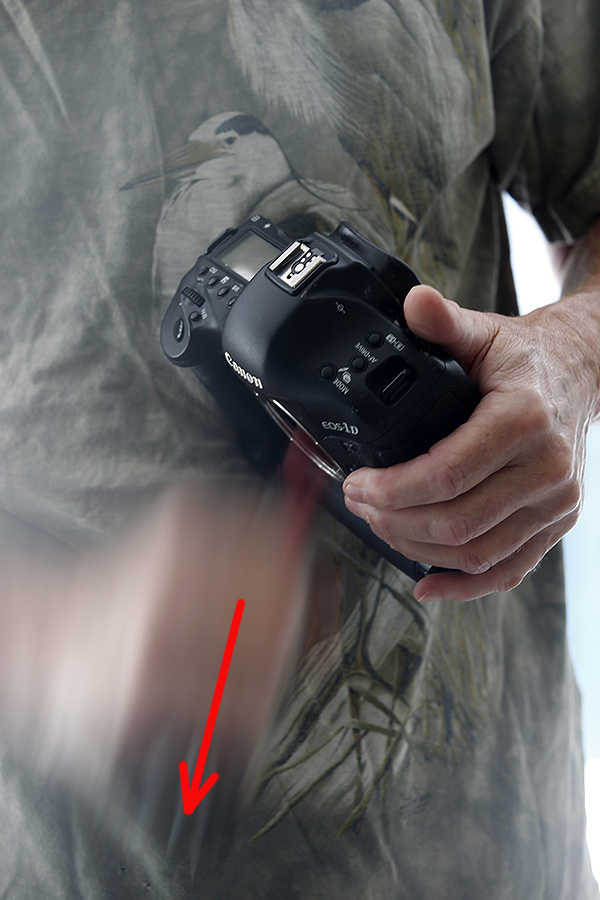
|
|
This image was also created on the pool deck just outside my office door with the Gitzo 3532 LS carbon fiber tripod, the Mongoose M3.6 head, the Canon EF 70-200mm f/2.8L IS II USM lens (tripod-mounted at 90mm) and the Canon EOS-1D X. ISO 200. Evaluative metering +1/3 stop as framed: 1/15 sec. at f/5.6 in Manual mode.
Central sensor/AI Servo-Surround/Rear Focus on the top of the camera and re-compose. Click here if you missed the Rear Focus Tutorial. Click on the image to see a larger version.
Image courtesy of and copyright 2014: Jim Litzenberg.
It took us a few tries to get the timing of the shutter release right to get the blurred effect that I was looking for. Jim did a great job. I brought the best blur into Photoshop, created a Quick Mask of my blurred hand, and accentuated the blur with a diagonal Filter > Blur > Motion Blur layer. As I learned in Denise Ippolito’s A Guide to Creative Filters and Effects.
|
The Blower Brush Sensor Cleaning Tip
Here is the tip that was taught to me by sensor cleaning expert Curt Fargo on last year’s Bosque del Apache Canon Destination Workshop (led by yours truly). Rather than simply holding the tip of the blower brush near the exposed sensor and squeezing the bulb firmly and repeatedly, perfect technique involves squeezing the bulb forcefully while violently pulling the blower brush down and away from the sensor. This action–it takes a bit of practice for some folks to get it down pat, actually sucks the dust off the sensor and out of the mirror box. That is much better option than simply blowing the dust around on the sensor…. I will usually execute this action 3-4 times before examining the sensor again with my sensor scope. Repeat as needed.
If, after several attempts, there is still a particle or two of visible dust stuck to the sensor (actually to the anti-aliasing filter that protects the sensor), then and only then do I go to my Lens Pen Mini Pro. You can learn more about the return of the Lens Pen by clicking here and scrolling down.
Please note that the purchase of a Lens Pen Mini Pro or one of our two Sensor Cleaning Bundles includes a detailed sensor cleaning tutorial that is sent via e-mail. You will learn to safely clean your camera’s sensor just as I have done thousands of times for the last decade.
First-ever BIRDS AS ART In-the-Field/Meetup Workshop Session (ITF/MWS): $50
Join me on the afternoon of October 10, 2014 for 3-hours of photographic instruction at Fort DeSoto Park. Beginners are welcome. Lenses of 300mm or longer are recommended but even those with 70-200s should get to make some nice images. Teleconverters are always a plus. Scroll down here for complete info.
Fort DeSoto Fall IPT/October 11-13, 2014. 3 FULL DAYs: $1099. Limit 8.
Tame shorebirds, herons, egrets, night-herons, terns and gulls plus tons of great instruction. Scroll down here for complete info. With one registrant, this trip is now a go. Join us.
Important Bosque Festival of the Cranes Event Registration Notice
Registration for all Festival of the Cranes workshops, seminars and programs is open. Please click here and read carefully to avoid missing out on several wonderful and inexpensive educational opportunities. Please do not tarry as we expect all of the BAA/A Creative Adventure sessions to sell out quickly, especially the early morning In-the-Field Workshops. You can click http://www.festivalofthecranes.com“>here to register.
There is still lots of room in the seminar and the free program. With just a single opening the Thursday In-the-Field Workshop (ITF-W) is almost sold out. Friday and Sunday are close to a sell-out. Somewhat inexplicably Saturday has only 2 folks signed up…. The seminar and the ITF-Workshops represent a chance to learn a ton cheap.
2015 San Diego 4 1/2-DAY BIRDS AS ART Instructional Photo-Tour (IPT): FEB 1 thru the morning of FEB 5, 2015: $1799 (Limit: 8/Openings: 4)
Meet and Greet after dinner on your own at 7:00pm on JAN 31
Just 4 slots left on this great IPT. Old friend, oft-published, and skilled hawk-in-flight photographer Ned Harris will be joining us.
Selling Your Used Photo Gear Through BIRDS AS ART
Selling your used (or like-new) photo gear through the BAA Blog or via a BAA Online Bulletin is a great idea. We charge only a 5% commission. One of the more popular used gear for sale sites charges a minimum of 20% plus assorted fees! Yikes. The minimum item price here is $500 (or less for a $25 fee). If you are interested please e-mail with the words Items for Sale Info Request cut and pasted into the Subject line :). Stuff that is priced fairly–I offer free pricing advice, usually sells in no time flat. In the past few months, we have sold just about everything in sight.
Used Gear Caution
Though I am not in a position to post images of gear for sale here or elsewhere, prospective buyers are encouraged to request for photos of the gear that they are interested in purchasing via e-mail. Doing so will help to avoid any misunderstandings as to the condition of the gear.
New Listings
Used Canon EF 500mm f/4L IS Lens
This Lens Sold in Two Hours!
BAA friend and multiple IPT veteran Brent Bridges is offering a used Canon EF 500mm f/4L IS lens in very good to excellent condition for $4900. The sale includes: the original lens trunk, the lens hood, carrying case, the front lens cover, the rear dust cap, the lens instructions, the original Canon USA Warranty Card, the original foot, a Mongoose 3.6-compatible low foot, a LensCoat, and insured shipping via UPS Ground to US addresses only. Your gear will be shipped only after your check clears.
Please contact Brent via e-mail or by phone at 1-770-565-5012.
The 500 f/4s have long been the world’s most popular super-telephotos for folks who photograph birds and wildlife. Brent recently upgraded to the Canon EF 600mm f/4L IS II USM /Canon EF 300mm f/2.8L IS II USM combo.
Used Canon EF 1.4XII and 2XII Teleconverters
BAA friend and multiple IPT veteran Brent Bridges is also offering, no, actually he is practically giving away a used Canon EF 1.4XII Teleconverter and a used 2XII Teleconverter, both in excellent condition with original box for $100 each. Nuf said. The sale includes both the front and rear dust caps and insured shipping via UPS Ground to US addresses only. Your gear will be shipped only after your check clears.
Please contact Brent via e-mail or by phone at 1-770-565-5012.
The 1.4XII TC is optically identical to the 1.4X III TC. The 2X II TC is slightly less sharp in the corners than the 2X III TC. I used both my 1.4X II and my 2X II TCs for years to produce hundreds of professionally sharp, saleable images.
Used Gitzo GT3450XLS 6X Carbon Fiber Tripod
Erik Hagstrom is offering a Gitzo GT3450XLS 6X carbon tripod (without adjustable center column as artie recommends) for $549. The tripod is in good condition, very clean with no major gouges or chips. There are as expected some normal use marks on the rubber feet. The sale includes a security plate, the fabric tripod sack, and the original box. Shipping terms: the buyer pays for shipping. Calculated at time of sale. Shipping weight is 6lbs. The tripod will ship in the original Gitzo box (6x6x29″).
Please contact Erik via e-mail or by phone at 1-206-999-1507 (9am – 5pm Pacific time).
The Gitzo GT3450XLS 6X Carbon Fiber Tripod is ideal for tall folks. It has been replaced by the virtually identical Gitzo GT3542XLS Tripod that sells new for $999.
Existing Listings
Used Canon EF 100-400 f 4.5-5.6 L IS Lens
Bruce Boswell is offering a used Canon EF 100-400 f 4.5-5.6 L IS lens in very good condition for $999 plus insured shipping via UPS Ground to US Continental addresses only. The tripod and zoom rings have a few minor blemishes. The sale includes: the original case, the front and rear caps, the lens hood, and the lens manual. Your gear will be shipped only after your check clears.
Please contact Bruce via e-mail or by phone at (309) 451-1506 or (309) 530-8493 (cell) (Central).
The 100-400 is a versatile intermediate telephoto zoom lens with 1,000+ uses. It makes a great starter lens especially for folks who do general nature and wildlife in addition to birds. I’ve sold 100s of images made with a 1-4 and denise loved hers for many years forsaking it only recently for the Canon EF 70-200mm f/2.8L IS II USM lens. Bruce’s 100-400 is priced to sell.
Used Canon 300mm f/4L IS USM Lens
Chris Callahan is offering a used Canon 300mm f/4L IS USM Lens in good to very good condition for $900. There is some wear on the finish. The sale includes the heavy duty fabric carrying case that is moderately worn, the tripod ring (tripod collar), and the rear cap. The seller will pay insured UPS shipping within continental US. The lens will ship after the check clears.
Please contact Chris via e-mail or by phone at 1-850-516-7155 (eastern time).
The Canon EF 300mm f/4L IS USM lens is still in production; it sells for $1449 new from B&H; buy Chris’s lens today and save $549! I have long recommended this lens as the best Canon bird photography starter lens, a clear choice over my old “toy lens,” the Canon EF 400mm f/5.6L. Why? It is faster at f/4. It has IS. And it autofocuses with a 7D (or other pro-sumer body) and a 1.4X teleconverter. The 300 f/4 L IS offers a minimum focusing distance of only 1.5 meters (less than 5 feet). This makes it a great lens for for frogs, butterflies, medium-sized and large flowers, and large insects like dragonflies. It is a great flight lens either alone or with the 1.4X TC. It is deadly sharp and great on a tripod with the Mongoose M3.6.
Used Canon EOS-1D Mark III
Michael Zajac is offering a Canon EOS-1D Mark III professional digital camera body in Excellent condition for $1250. The sale includes the battery charger, one battery, the original paperwork, the camera strap, the original box, and shipping to the continental US.
Please contact Michael via e-mail or by phone at 732-979 -6644. Photos are available upon request.
Some EOS-1D Mark III bodies originally had AF problems. Michael’s did not. I have seen his great flight images made with this camera. This body features a 1.3X crop factor sensor and is a great step-up for someone who wants to take a big step up from a 7D. It’s powerful battery drives AF much faster than the pro-sumer bodies especially with either a 1.4X or 2X teleconverter in place.
Facebook
Be sure to like and follow BAA on Facebook by clicking on the logo link upper right. And please do send a Friend Request. Tanks a stack!
Support the BAA Blog. Support the BAA Bulletins: Shop B&H here!
We want and need to keep providing you with the latest free information, photography and Photoshop lessons, and all manner of related information. Show your appreciation by making your purchases immediately after clicking on any of our B&H or Amazon Affiliate links in this blog post. Remember, B&H ain’t just photography!
…..
Amazon Canada
Many kind folks from north of the border, ay, have e-mailed stating that they would love to help us out by using one of our affiliate links but that living in Canada and doing so presents numerous problems. Now, they can help us out by using our Amazon Canada affiliate link by starting their searches by clicking here. Many thanks to those who have written.
Typos
In all blog posts and Bulletins, feel free to e-mail or to leave a comment regarding any typos, wrong words, misspellings, omissions, or grammatical errors. Just be right. 🙂
September 10th, 2014 The Streak Continues: 284
This blog was published at about 5:15am from my home in Indian Lake Estates, FL. Yesterday I enjoyed another long, easy swim of just under a mile and a short nap. I spent four solid hours working on the DPP 4.0 RAW Conversion eGuide. This post, which took me about 2 1/2 hours to prepare, makes 284 in a row. 365 is well within sight….
As always, I would appreciate your using the BIRDS AS ART B&H affiliate links for all of your major gear, video, and electronic purchases, using our Amazon logo-link for all of your household purchases, and visiting the BAA Online Store for your tripod, tripod head, LensCoat, miscellaneous, accessories, and eGuide purchases as well. Please remember, web orders only. 🙂


First-ever BIRDS AS ART In-the-Field/Meetup Workshop Session (ITF/MWS): $50
Join me on the afternoon of October 10, 2014 for 3-hours of photographic instruction at Fort DeSoto Park. Beginners are welcome. Lenses of 300mm or longer are recommended but even those with 70-200s should get to make some nice images. Teleconverters are always a plus. Scroll down here for complete info.
Fort DeSoto Fall IPT/October 11-13, 2014. 3 FULL DAYs: $1099. Limit 8.
Tame shorebirds, herons, egrets, night-herons, terns and gulls plus tons of great instruction. Scroll down here for complete info.
Important Bosque Festival of the Cranes Event Registration Notice
Registration for all Festival of the Cranes workshops, seminars and programs is open. Please click here and read carefully to avoid missing out on several wonderful and inexpensive educational opportunities. Please do not tarry as we expect all of the BAA/A Creative Adventure sessions to sell out quickly, especially the early morning In-the-Field Workshops. You can click http://www.festivalofthecranes.com to register.
Head Throw Photography
Head throws, usually part of the bill cleaning ritual of Pacific Brown Pelican are thought to be a form of intra-flock communication: one pelican talking to another. It is exceedingly rare to see a Brown Pelican of the Atlantic race do a head throw. On the other hand, the Pacific birds do them quite often. Head throw photography can be quite exciting and quite rewarding; one of my earliest BBC Wildlife Photographer of the Year Competition-honored images (I have eight in all), was a full frame vertical of Pacific Brown Pelican at the height of a head throw. You can see that image, cropped a bit too tightly by the original designer, on page 86 as a chapter opener and on the back cover of the original The Art of Bird Photography.
Head throw photography is a huge challenge. You might have as many as 20-30 or more pelicans sitting right in front of you at relatively close range; which one will be the next to execute a head throw? Are there any clues to which bird will be the next to show off? How do you position yourself to try to isolate your subject and come up with a clean background? What is the best lens? Should you use a fixed focal length lens or a zoom lens? Should you be in horizontal or vertical format? Should you include the whole bird in the frame, go for a head and shoulder vertical, or try for a tight bill portrait shot as in today’s featured image? Should you be on a tripod or hand holding? What sort of shutter speed should I be using? Is one time of day better than another for head portrait photography? Should you specifically try to create head throw images or do you have a chance to get a great one in the course of a given morning of general pelican photography?
Please note the answers to some of these questions can be ascertained by carefully reading the image caption above…. A good part of each morning on a San Diego IPT is spent considering all of the above questions…. And answering them. And lots more. If you would like to join us please scroll down for info on this great workshop.
Head Throw Word Association
Click on the image to enlarge it. What words and phrases come to mind? Please take a moment to leave a comment with your list. Right now I have more than 20 on my list. I will share my list with you here on Friday morning.
|
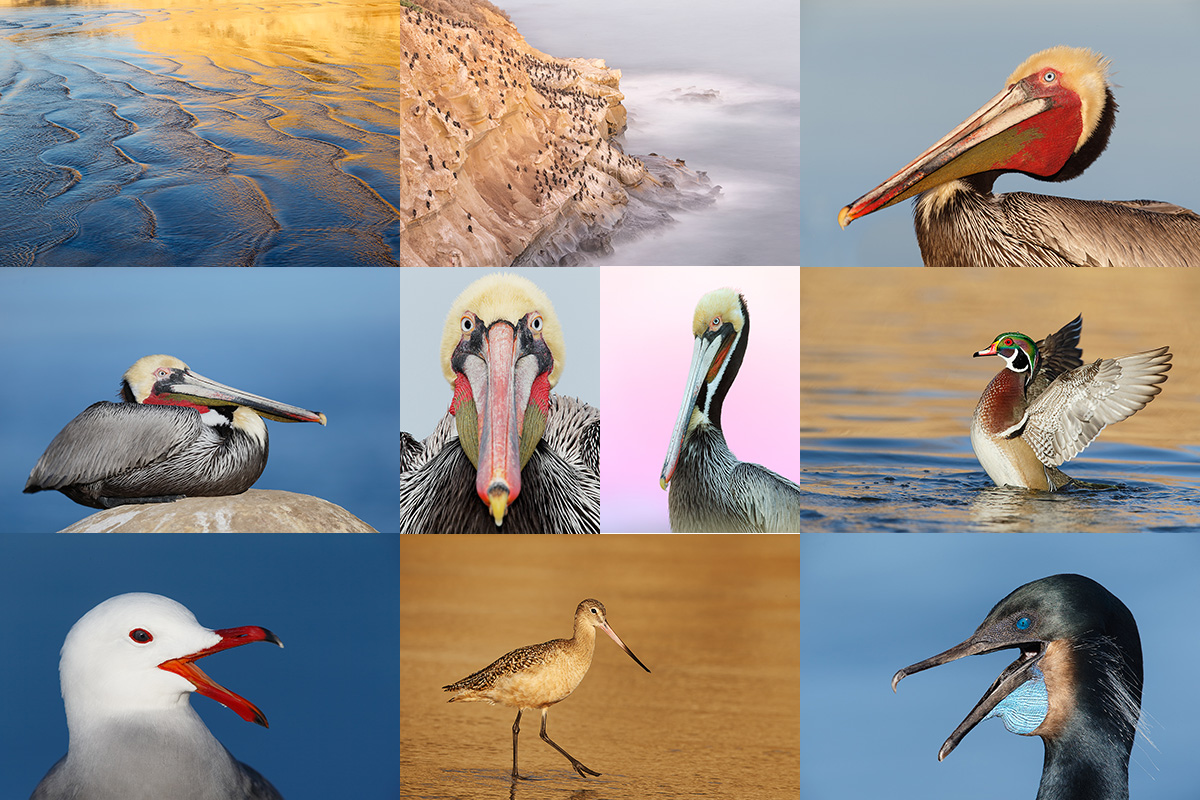
|
|
San Diego offers a wealth of very attractive natural history subjects. With annual visits spanning more than three decades I have lot of experience there….
|
2015 San Diego 4 1/2-DAY BIRDS AS ART Instructional Photo-Tour (IPT): FEB 1 thru the morning of FEB 5, 2015: $1799 (Limit: 8/Openings: 5)
Meet and Greet after dinner on your own at 7:00pm on JAN 31
Join me in San Diego to photograph the spectacular breeding plumage Brown Pelicans with their fire-engine red bill pouches; Brandt’s and Double-crested Cormorants in breeding plumage with their amazing crests; breeding plumage Wood and Ring-necked Duck; other species possible inluding Lesser Scaup, Redhead, and Surf Scoter; a variety of gulls including Western, California, and the gorgeous Heerman’s, all in full breeding plumage; shorebirds including Marbled Godwit, Willet, Sanderling and Black-bellied Plover; many others possible including Least, Western, and Spotted Sandpiper, Whimbrel, Black and Ruddy Turnstone, Semiplamated Plover, and Surfbird; Harbor Seals (depending on the current regulations) and California Sea Lions likely; and Bird of Paradise flowers. And as you can see by studying the two IPT cards there are some nice landscape opportunities as well.
Did I mention that there are wealth of great birds and natural history subjects in San Diego in winter?
This IPT will include five 3 1/2 hour morning photo sessions, four 2 1/2 hour afternoon photo sessions, five lunches, after-lunch image review and Photoshop sessions, and two fine dinners. To ensure early starts, breakfasts will be your responsibility.
A $499 non-refundable deposit is required to hold your slot for this IPT. You can send a check (made out to “Arthur Morris) to use at BIRDS AS ART, PO Box 7245, Indian Lake Estates, FL, 33855. Or call Jim or Jennifer at the office with a credit card at 863-692-0906. Your balance, payable only by check, will be due on 12/1//2014. If the trip fills, we will be glad to apply a credit applicable to a future IPT for the full amount less a $100 processing fee. If we do not receive your check for the balance on or before the due date we will try to fill your spot from the waiting list. If your spot is filled, you will lose your deposit. If not, you can secure your spot by paying your balance. Please print, complete, and sign the form that is linked to here and shoot it to us along with your deposit check. If you register by phone, please print, complete and sign the form as noted above and either mail it to us or e-mail the scan. If you have any questions, please feel free to contact me via e-mail.
|
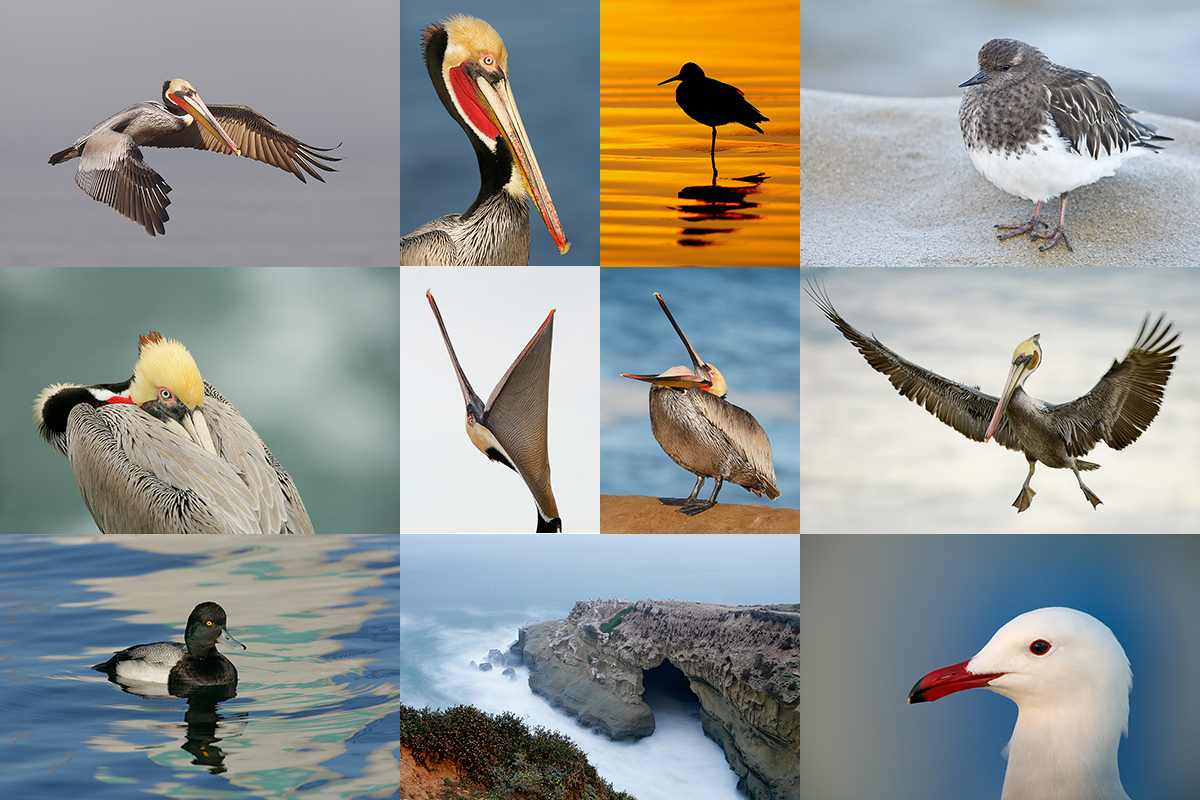
|
|
Though the pelicans will be the stars of the show on this IPT there will be many other handsome and captivating subjects in wonderful settings.
|
San Diego Natural History Museum Program & The Birds of the World Exhibit
On Saturday morning, February 7, 2015 I will be presenting “A Bird Photographer’s Story” at the San Diego Natural History Museum to kick off the Birds of the World photographic exhibit that will feature the images of about a dozen of the world’s top avian photographers. This program,which is being generously sponsored by the Canon Explorers of Light program, will be free and open to the public. I am proud to say that both Denise Ippolito and I will have images hanging in the show. The exhibit opening is scheduled for later that same day, February 7, 2015. (Times TBA).
Folks on the IPT who wish to stay over and attend the program and the exhibit opening on Saturday are invited to join me for a photo session on Friday morning as follows:
Friday Morning Add-on Photo Session: February 6, 2015: $299.
This workshop includes 3 hours of in-the-field pelican photography instruction and brunch with image review and Photoshop instruction. For now, this session is open only to folks attending the IPT.
Facebook
Be sure to like and follow BAA on Facebook by clicking on the logo link upper right. Tanks a stack!
Support the BAA Blog. Support the BAA Bulletins: Shop B&H here!
We want and need to keep providing you with the latest free information, photography and Photoshop lessons, and all manner of related information. Show your appreciation by making your purchases immediately after clicking on any of our B&H or Amazon Affiliate links in this blog post. Remember, B&H ain’t just photography!
…..
Amazon.com
Those who prefer to support BAA by shopping with Amazon may use this link:
Amazon Canada
Many kind folks from north of the border, ay, have e-mailed stating that they would love to help us out by using one of our affiliate links but that living in Canada and doing so presents numerous problems. Now, they can help us out by using our Amazon Canada affiliate link by starting their searches by clicking here. Many thanks to those who have written.
Typos
In all blog posts and Bulletins, feel free to e-mail or to leave a comment regarding any typos, wrong words, misspellings, omissions, or grammatical errors. Just be right. 🙂
September 9th, 2014 The Streak Continues: 283
This blog was published just after 7:15am from my home in Indian Lake Estates, FL. Yesterday I enjoyed another long, easy swim of just under a mile and another too-long nap. This post, which took me about 2 1/2 hours to prepare, makes 283 in a row. 365 is well within sight….
As always, I would appreciate your using the BIRDS AS ART B&H affiliate links for all of your major gear, video, and electronic purchases, using our Amazon logo-link for all of your household purchases, and visiting the BAA Online Store for your tripod, tripod head, LensCoat, miscellaneous, accessories, and eGuide purchases as well. Please remember, web orders only. 🙂


2015 San Diego 4 1/2-DAY BIRDS AS ART Instructional Photo-Tour (IPT): FEB 1 thru the morning of FEB 5, 2015: $1799 (Limit: 8/Openings: 5)
Meet and Greet after dinner on your own at 7:00pm on JAN 31
Just 5 slots left on this great IPT. Click here and scroll down for complete details.
Important Bosque Festival of the Cranes Event Registration Notice
Registration for all Festival of the Cranes workshops, seminars and programs is open. Please click here and read carefully to avoid missing out on several wonderful and inexpensive educational opportunities. Please do not tarry as we expect all of the BAA/A Creative Adventure sessions to sell out quickly, especially the early morning In-the-Field Workshops. You can click http://www.festivalofthecranes.com to register.
|
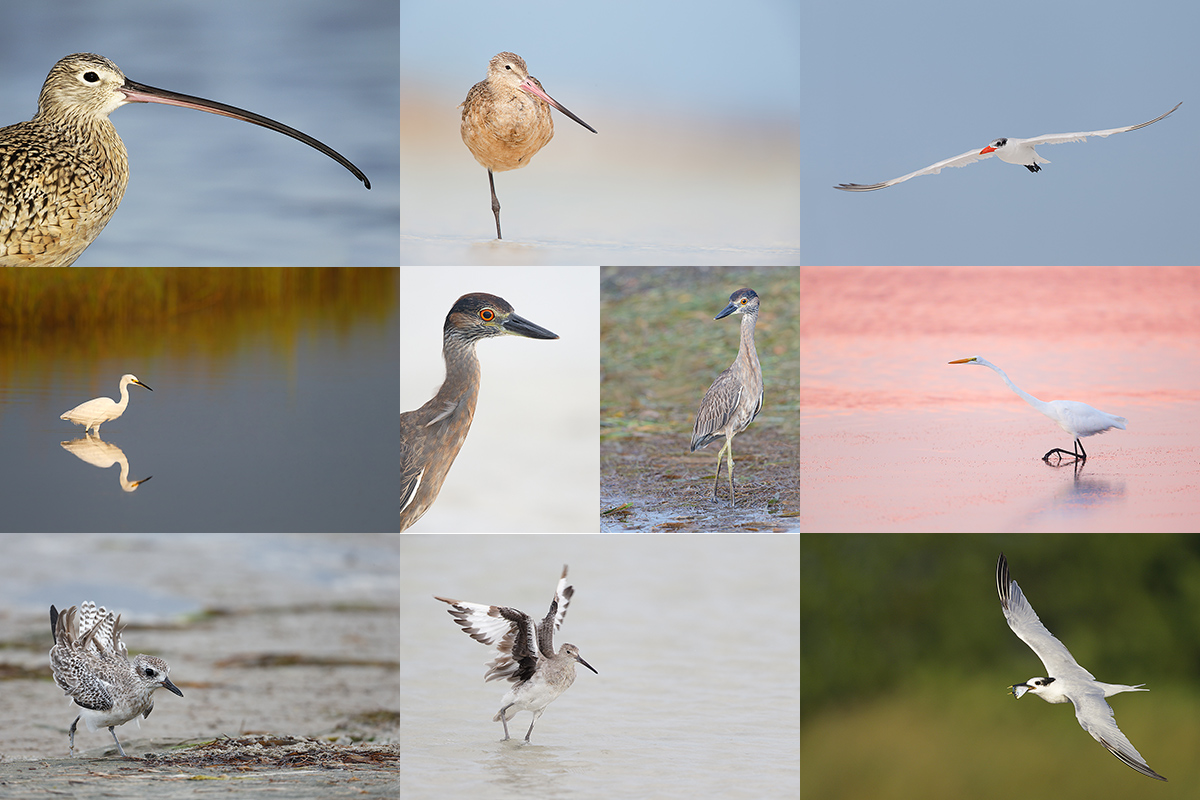
|
|
Fort DeSoto in fall is rich with tame birds. All of the images in this card were created at Fort DeSoto in either late September or early October. I hope that you can join me there this October. Click on the composite to enjoy a larger version.
|
First-ever BIRDS AS ART In-the-Field/Meetup Workshop Session (ITF/MWS): $50
Join me on the afternoon of October 10, 2014 for 3-hours of photographic instruction at Fort DeSoto Park. Beginners are welcome. Lenses of 300mm or longer are recommended but even those with 70-200s should get to make some nice images. Teleconverters are always a plus.
You will learn the basics of digital exposure and image design, autofocus basics, and how to get close to free and wild birds. We should get to photograph a variety of wading birds, shorebirds, terns, and gulls. This inexpensive afternoon workshop is designed to give folks a taste of the level and the quality of instruction that is provided on BIRDS AS ART Instructional Photo-tours. I hope to meet you there.
To register please call Jim or Jennifer during weekday business hours with a credit card in hand to pay the nominal registration fee. Your registration fee is non-refundable. You will receive a short e-mail with instructions, gear advice, and meeting place at least two weeks before the event.
|
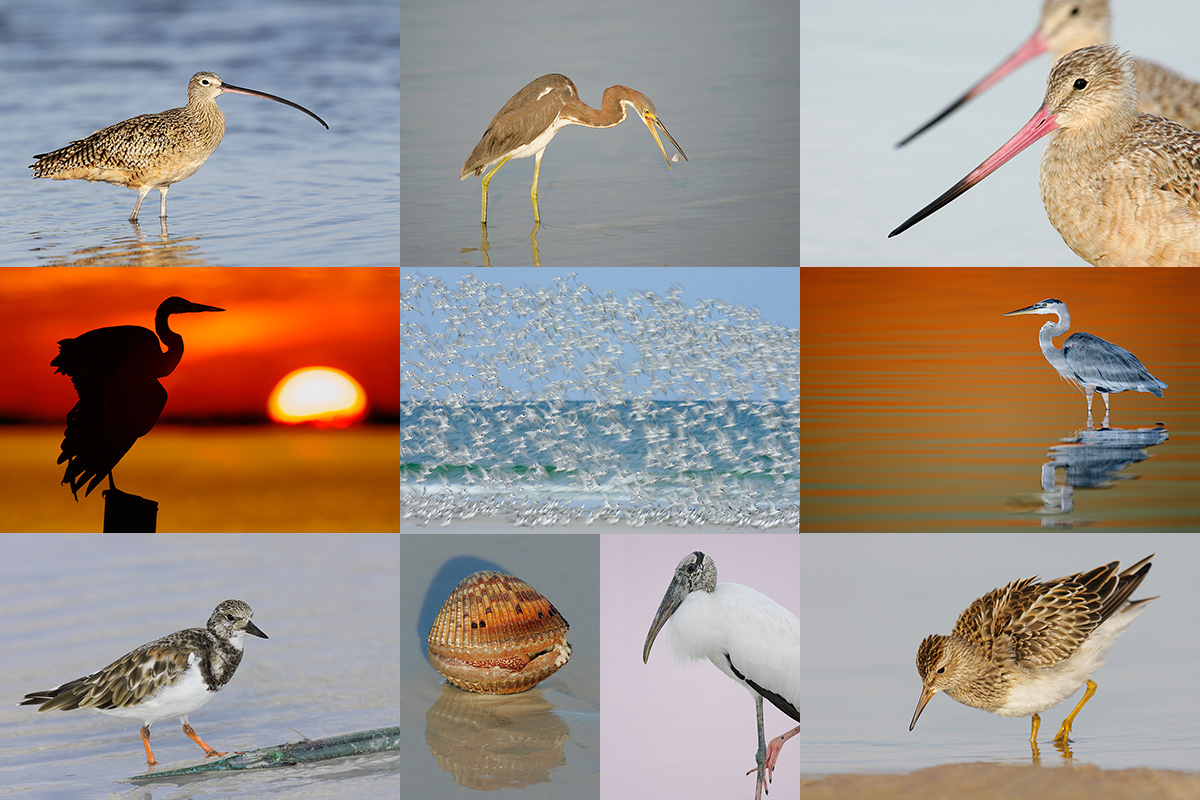
|
|
Obviously folks attending the IPT will be out in the field early and stay late to take advantage of sunrise and sunset colors. The good news is that the days are relatively short in October. Click on the composite to enjoy a larger version.
|
Fort DeSoto Fall IPT/October 11-13, 2014. 3 FULL DAYs: $1099. Limit 8.
Fort DeSoto, located just south of St. Petersburg, FL, is a mecca for migrant shorebirds in fall. There they join hundreds of egrets, herons, night-herons, gulls, and terns who winter on the T-shaped peninsula that serves as their wintering grounds. With any luck, we should get to photograph two of Florida’s most desirable shorebird species: Marbled Godwit and the spectacular Long-billed Curlew. Black-bellied Plover and Willet are easy, American Oystercatcher likely. Great Egret, Snowy Egret, Great Blue Heron, and Tricolored Heron are easy as well and we will almost surely come up with a tame Yellow-crowned Night-Heron or two. We should get to do some Brown Pelican flight photography. And Royal, Sandwich, Forster’s, and Caspian Terns will likely provide us with some good flight opportunities as well. Though not guaranteed Roseate Spoonbill and Wood Stork would not be unexpected.
Folks who sign up for the IPT are welcome to join us on the ITF/MWS on Friday afternoon as my guest. See above for details on that.
On the IPT you will learn basics and fine points of digital exposure and to get the right exposure every time after making a single test exposure, how to approach free and wild birds without disturbing them, to understand and predict bird behavior, to identify many species of shorebirds, to spot the good situations, to choose the best perspective, to see and understand the light, to, and to design pleasing images by mastering your camera’s AF system. And you will learn learn how and why to work in Manual mode (even if you’re scared of it).
At lunch (included) we will review my images–folks learn a ton watching me edit–why keep this one and delete that one. If you opt to bring your laptop, we will take a look at five of your best images from the morning session. We will process a few of my images in Photoshop after converting them in DPP. That followed by Instructor Nap Time.
As soon as I have a single sign-up for the IPT–as always I will go with one–I will make my reservations at the Beachcomber Beach Resort, 6200 Gulf Blvd, St. Petersburg (St. Pete Beach), FL 33706 (727-367-1902). I stayed at the Beachcomber Beach Resort on my last DeSoto visit and was quite happy with it. Lodging is tough in Florida at this season…. The best airport is Tampa (TPA). It is always best if IPT folks stay in the same hotel so if you are interested it would be a good idea to register now and make your hotel reservations as well. We can easily coordinate with local folks who opt to stay at home.
Because of the relatively late date, payment is full is due upon registration either by check or credit card. If the former, please e-mail us immediately so that we can save you a spot. If the latter, please call Jim or Jennifer during weekday business hours at 863-692-0906 with a credit card in hand to register . Your registration fee is non-refundable unless the IPT sells out with eight so please check your plans carefully before committing. You will receive a confirmation e-mail with detailed instructions, gear advice, and first morning meeting place about one month before this IPT.
|
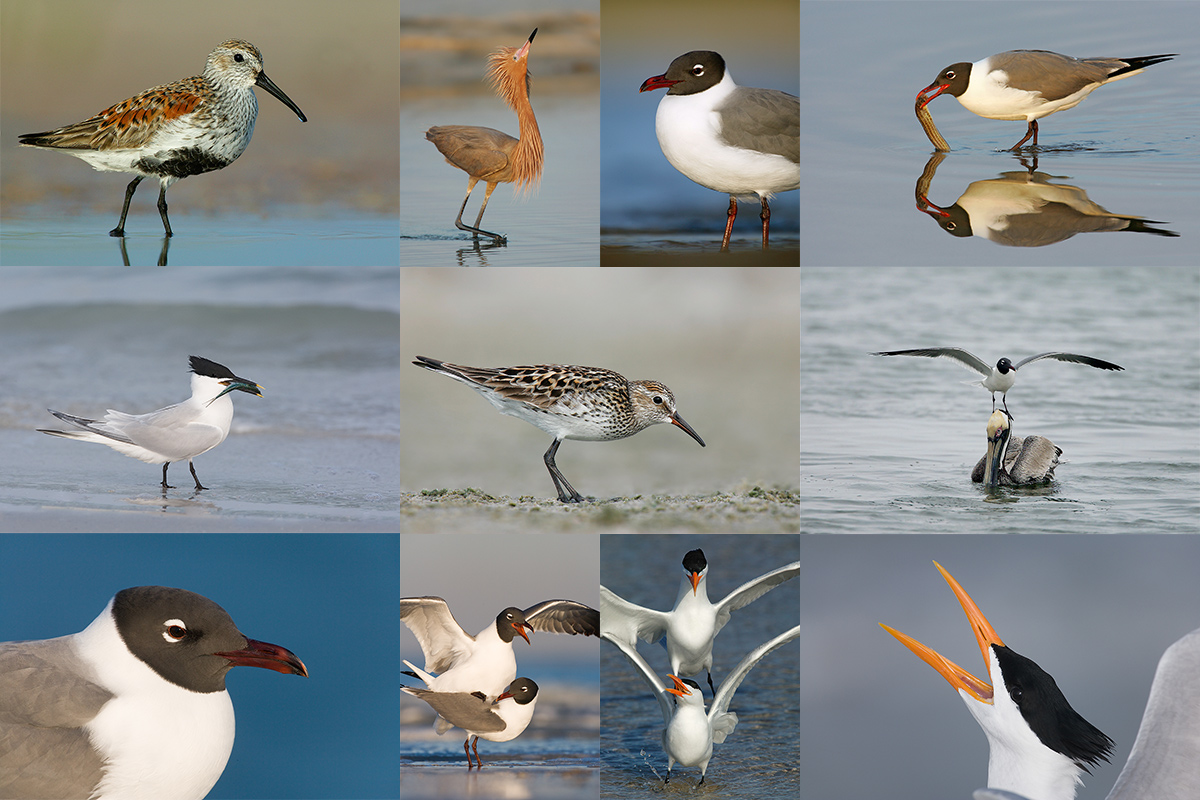
|
|
BAA Site Guides are the next best thing to being on an IPT.
|
Fort DeSoto Site Guide
Can’t make the IPT? Get yourself a copy of the Fort DeSoto Site Guide. Learn the best spots, where to be when in what season in what weather. Learn the best wind directions for the various locations. BAA Site Guides are the next best thing to being on an IPT. You can see all of them here.
Facebook
Be sure to like and follow BAA on Facebook by clicking on the logo link upper right. Tanks a stack!
Support the BAA Blog. Support the BAA Bulletins: Shop B&H here!
We want and need to keep providing you with the latest free information, photography and Photoshop lessons, and all manner of related information. Show your appreciation by making your purchases immediately after clicking on any of our B&H or Amazon Affiliate links in this blog post. Remember, B&H ain’t just photography!
…..
Amazon.com
Those who prefer to support BAA by shopping with Amazon may use this link:
Amazon Canada
Many kind folks from north of the border, ay, have e-mailed stating that they would love to help us out by using one of our affiliate links but that living in Canada and doing so presents numerous problems. Now, they can help us out by using our Amazon Canada affiliate link by starting their searches by clicking here. Many thanks to those who have written.
Typos
In all blog posts and Bulletins, feel free to e-mail or to leave a comment regarding any typos, wrong words, misspellings, omissions, or grammatical errors. Just be right. 🙂
September 8th, 2014 The Streak Continues: 282
This blog was published just after 6:45am from my home in Indian Lake Estates, FL. Yesterday I enjoyed a long, easy swim of just under a mile and a too-long nap. Plus lots of golf, tennis, and the NFL on the big flat screen TV. I was in bed early at 9:00pm, up at 3:00am, and at my desk hard at work by 3:30am. This post, which took me about 3 1/2 hours to prepare, makes 282 in a row. 365 is well within sight….
As always, I would appreciate your using the BIRDS AS ART B&H affiliate links for all of your major gear, video, and electronic purchases, using our Amazon logo-link for all of your household purchases, and visiting the BAA Online Store for your tripod, tripod head, LensCoat, miscellaneous, accessories, and eGuide purchases as well. Please remember, web orders only. 🙂
Ask and Ye Shall Receive
In the “Despicable Tales, 1D X Frame Rate, & Matters of Opinion” blog post here, I wrote under the heading of Blog Interactivity: While it is great that an average of more than 2,000 folks visit and learn from the blog each day it would be wonderful if more than a handful of folks tackled the questions that are designed to make the blog more interactive and less static. And I could have added, “more interesting for all as well.”
With 14 comments, folks really rose to the occasion. Such participation is greatly appreciated.
Lens Pen News
The Lens Pen sale will continue for one more day. The price increase will go into effect on Tuesday morning at 9am. We were overwhelmed by orders yesterday. You can read the whole story by scrolling down here. Or order one or more Lens Pen Mini Pros here for just $9.99 each plus shipping. As always, and ridiculous excess shipping charges will of course be refunded.
Click here to learn about all of our sensor cleaning supplies.
Coming Tomorrow (for sure!)
In tomorrow’s blog post I will share a great new Giottos Rocket-Air Super AIR Blower sensor cleaning tip.
|
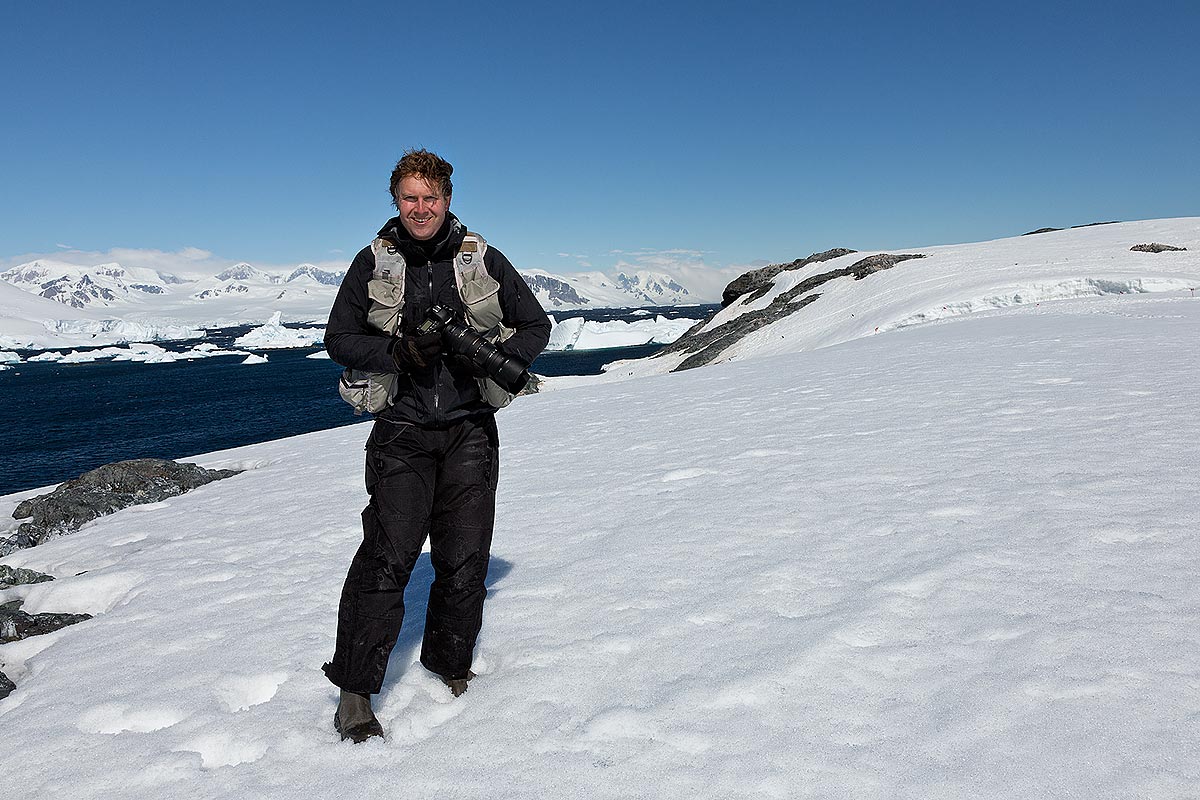
|
|
This image was created with the Canon 24-105mm f/4L IS EF USM AF lens hand held at 28mm with the Canon EOS 5D Mark III Digital camera body. ISO 400: 1/1600 sec. at f/13 in Manual mode.
Central sensor Surround/AI Servo/Rear Focus AF and recompose. Click here if you missed the Rear Focus Tutorial. Click on the image to see a larger, sharper version.
Image #1: A Happy Photographer… Detaille Island, Antarctica, south of the antarctic circle. Image courtesy of Clemens Van der Werf.
|
Thanks Clemens!
Clemens Van der Werf is unquestionably one of my two most talented students with only Todd Gustafson giving him a run for the money. Thanks to Clemens for letting me use six of his Southern Ocean images in this blog post. Clemens has been on several Southern Ocean expeditions, several with me and most with Cheesemans’ Ecology Safaris.
Please note: all of the images here were created by Clemens Van der Werf. Comments praising me for my great images will be deleted as a matter of course and without comment.
|
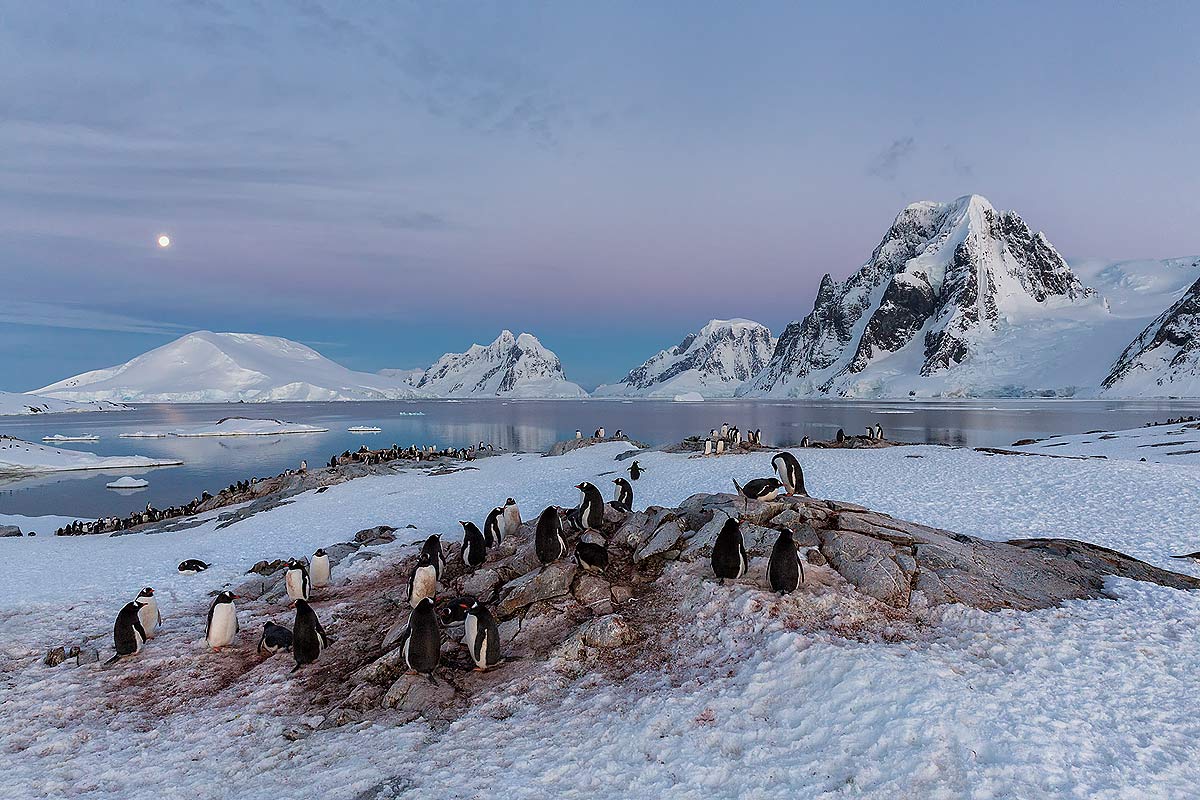
|
|
This image was created with the Canon EF 24-70mm f/2.8L II USM lens (hand held at 24mm) and the Canon EOS 5D Mark III. ISO 400: 1/80 sec. at f/8 in Manual mode.
Central sensor/AI Servo/Surround Rear Focus AF on the nearest penguin and re-compose. Click here to see the latest version of the Rear Focus Tutorial. Click on the image to see a larger version.
Image #2: Gentoo Penguins & full moon with a pink/purple/blue sky. Petermann Island, Antarctica , looking towards the south entrance of the Lemaire Channel. Image courtesy of and copyright 2013 Clemens Van der Werf.
|
Compositional Skills
Note Clemens’ superb compositional skills in each of the images presented here. Interestingly enough, when Clemens came on his first IPT he had no interest in bird photography. He just wanted to learn photography. Canon Explorer of Light Onne van der Wal recommended that Clemens study with me. He has done that in spades. He has attended well more than a dozen IPTs, Photo Cruises and Expeditions, and Bear Boat trips in all.
|
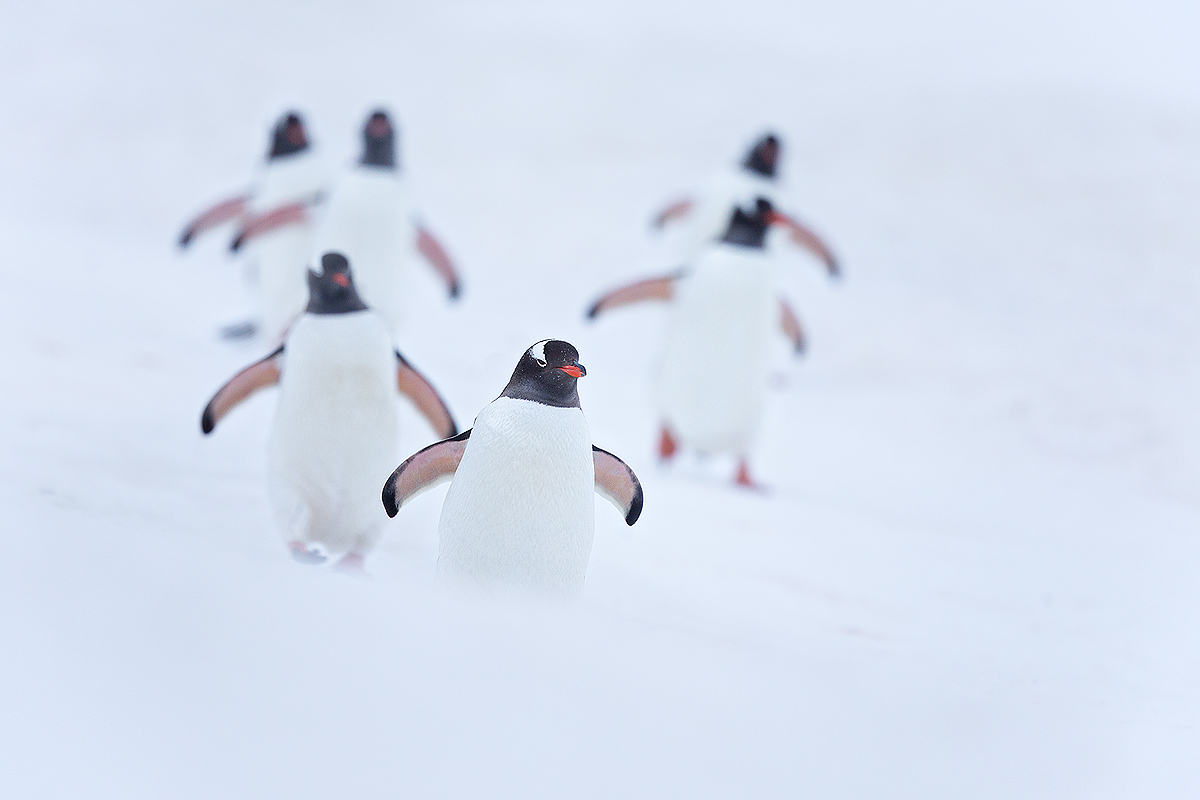
|
|
This image was created with the Canon EF 500mm f/4L IS II USM lens, a Canon Extender EF 1.4X III, and the Canon EOS 5D Mark III. ISO 400: 1/80 sec. at f/8 in Manual mode.
One sensor to the left of the central sensor/AI Servo/Surround Rear Focus AF on the neck of the nearest penguin was active at the moment of exposure. Click here to see the latest version of the Rear Focus Tutorial. Click on the image to see a larger version.
Image #3: Gentoo Penguin March. 3rd image: Yankee Harbor, South Shetlands Islands, Antarctica. Image courtesy of and copyright 2013 Clemens Van der Werf.
|
AF Tip
In soft light/low contrast situations like the one above it is important to choose an AF point that falls on an area of contrast. Here Clemens activated a sensor that fell right on the spot where black hood of the front bird met the white breast. AF acquired and held focus easily resulting in a series of sharp images.
|
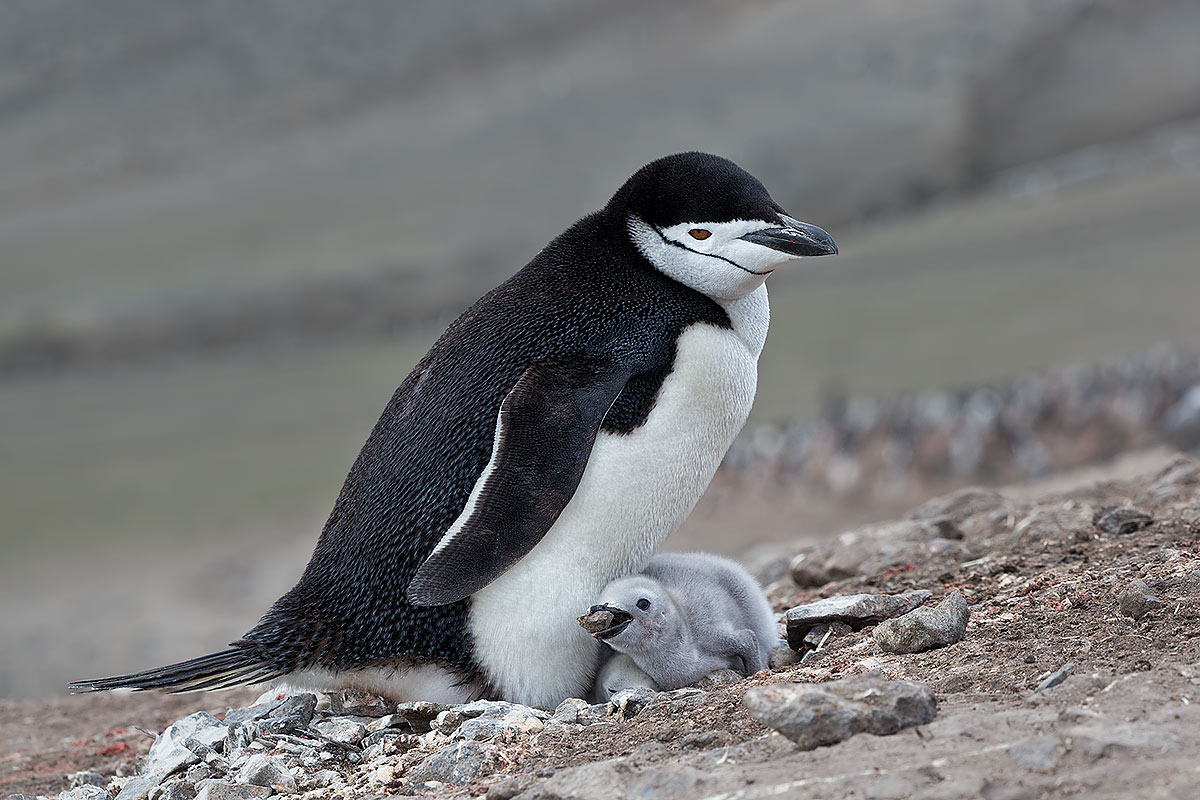
|
|
This image was created with the Sigma 50-500mm f/4.5-6.3 APO DG OS HSM lens for Canon EOS (hand held at 203mm) and the Canon EOS-1D X. ISO 500: 1/320 sec. at f/11 in Manual mode.
Central sensor/AI Servo/Surround Rear Focus AF on the nearest penguin and re-compose. Click here to see the latest version of the Rear Focus Tutorial. Click on the image to see a larger version.
Image #4: Chinstrap Penguin at nest with grown chick. Bailey Head, South Shetland Islands, Antarctica. Image courtesy of and copyright 2013 Clemens Van der Werf.
|
Local Knowledge…
Even in wildlife-rich paradises like the Southern Ocean, each landing rife with almost unlimited photographic opportunities, a little bit of local knowledge goes a long way. On my first landing at Bailey Head, long-time CES leader Tom Murphy alerted me to the single hillside that would be best for photographing chinstraps with chicks at the nest with pleasingly distant backgrounds….
|
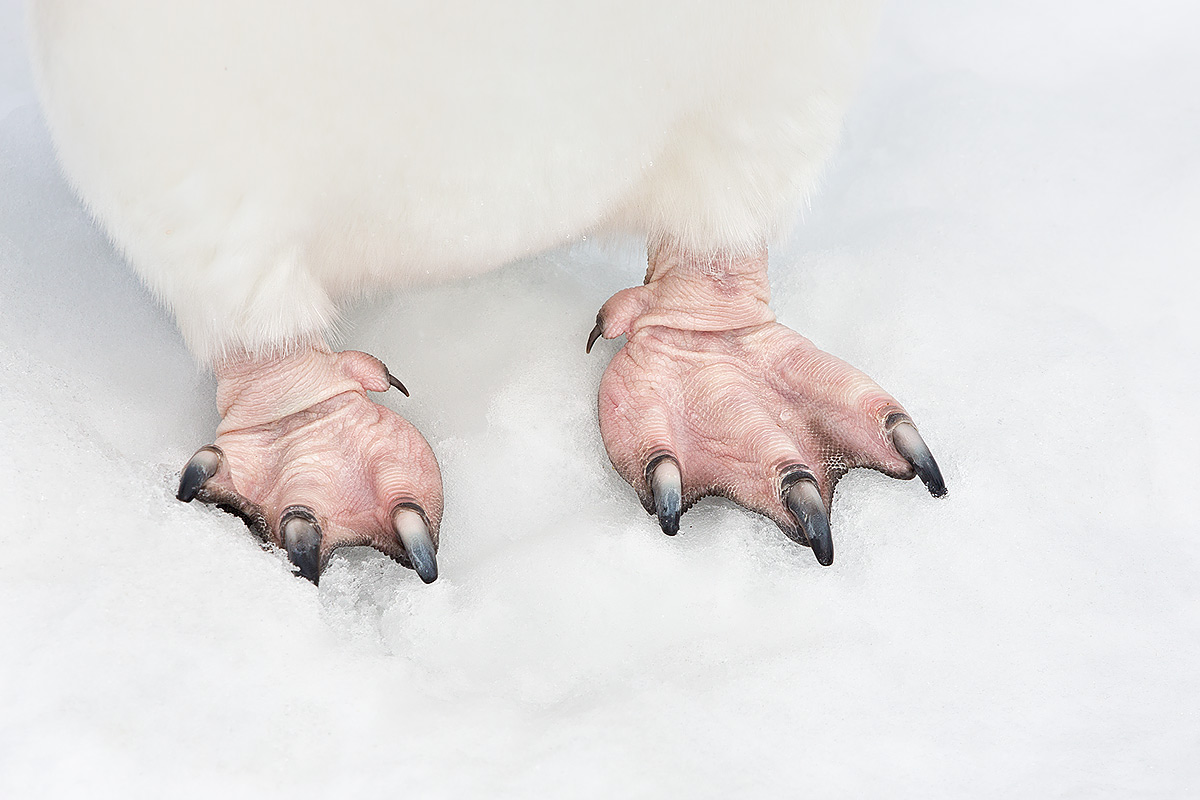
|
|
This image was created with the Sigma 50-500mm f/4.5-6.3 APO DG OS HSM lens for Canon EOS (this one hand held at 500mm) and the Canon EOS 5D Mark III. ISO 400: 1/320 sec. at f/16 in Manual mode.
Central sensor/AI Servo/Surround Rear Focus AF behind the base of the long toe on the bird’s left foot and re-compose. Click here to see the latest version of the Rear Focus Tutorial. Click on the image to see a larger version.
Image #5: Chinstrap Penguin, close-up of feet. Penguin Island, South Shetland Islands, Antarctica. Image courtesy of and copyright 2013 Clemens Van der Werf.
|
Sigma 50-500mm f/4.5-6.3 APO DG OS HSM Lens Versatility
By simply looking at this image and the one above it is easy to tell that the Sigma 50-500mm f/4.5-6.3 APO DG OS HSM lens is amazingly versatile. With it 10X zoom range and remarkable close focus abilities it really is a one-size fits all hand holdable lens for wildlife. The only drawback? For decent sharpness, you need to work at f/8 or smaller. Nikon users need not despair; a Nikon mount version is available.
|
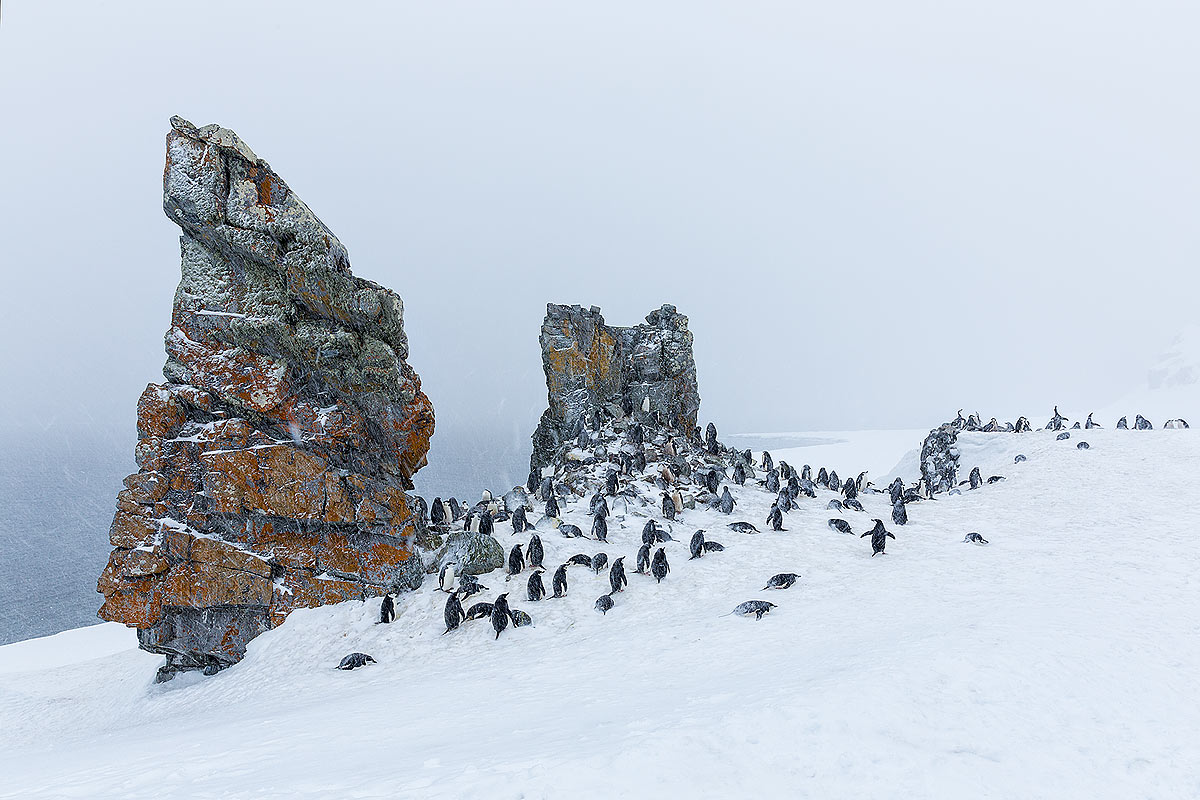
|
|
This image was also created with the Canon EF 24-70mm f/2.8L II USM lens (hand held again at 24mm) and the Canon EOS 5D Mark III. ISO 400: 1/60 sec. at f/14 in Manual mode.
Central sensor/AI Servo/Surround Rear Focus AF on the second closest penguin and re-compose. Click here to see the latest version of the Rear Focus Tutorial. Click on the image to see a larger version.
Image #6: Chinstrap Penguins & rock formations. Half Moon Island, South Shetland Islands, Antarctica. Image courtesy of and copyright 2013 Clemens Van der Werf.
|
Exposure Quiz
OK boys and girls, here is your chance to shine and show how much you have learned here. List the images by number like this:
#1:
#2:
#3:
#4:
#5:
#6: +1 1/3 stops.
and then type in what you think was the correct exposure compensation for each image. I have given you my best guess for #6. Nikon folks will on average need to add 2/3 stop to their Nikon exposure compensations. When we follow up I will share my thoughts on each exposure and we will have Clemens chime in with his best recollections.
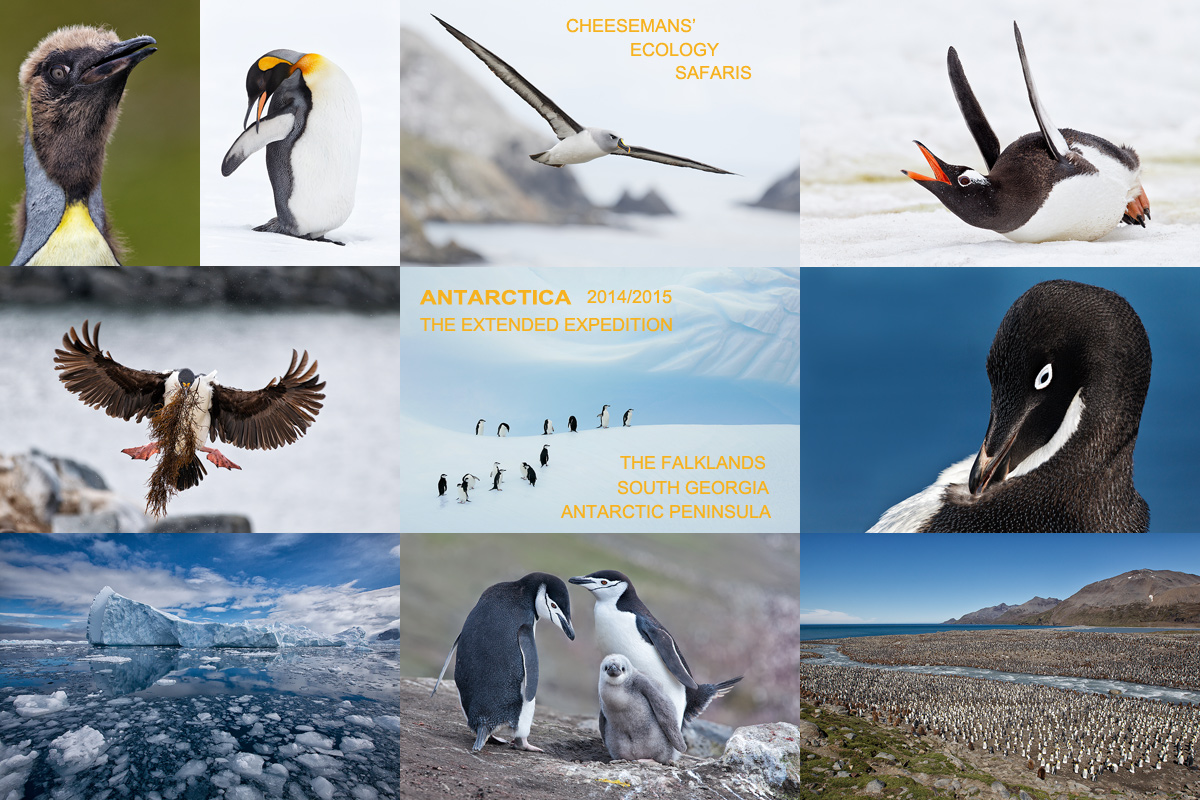
|
|
Breathe deeply, bite the bullet, and live life to its fullest; we all get only one ride on the merry-go-round… Join me on this great trip.
Click on the image to enjoy a larger version.
|
This Could Be You in the Southern Ocean!
I’ve been blessed. I’ve made three trips to the Southern Ocean, two extended trips that visited the Falklands, South Georgia, and the Antarctic Peninsula, and one to the Falklands and South Georgia. Each was a truly amazing experience. With three trips under my belt, I have a pretty good idea about how to make great images at each of the iconic landings. And I would love the chance to share my knowledge with you.
And I know from personal experience that if you are a photographer who is going to invest in Southern Ocean voyage that you will want to put your money on Cheesemans’. No other tour company goes so far out of their way to ensure making every possible safe landing. And no other tour company will have you spending more time on land. Here, from the” Way to Go CES! (Cheeseman’s Ecology Safaris)” blog post here, is one of my favorite Cheesemans’ stories:
The landing at Bailey Head, Antarctica, was especially rewarding to me as I had been sitting in a zodiac 100 yards off shore on my 2007 trip when the zodiac in front of mine swamped and the captain of the ship called off the landing…. Early that day it looked as if my weather Karma might not be working. Ted’s “Good morning shipmates” was followed by the news that we would not be able to land at Bailey Head that morning as the swell was too big. The beach there is sloped tremendously and the sea strives to pull the zodiacs back into the ocean before folks have gotten off with their gear. Tom Murphy had said to me several days before, “We will get you on the beach at Bailey Head.” Ted concluded his morning greetings by saying, “We are sending out a scout team to see if landing is possible.”
After breakfast I was thrilled to hear Ted’s voice again on the PA, “We will be landing at 8am.” Afterwards folks noted that it was the calmest landing ever at this amazingly beautiful spot. My good weather Karma (courtesy of late-wife Elaine) had come through one last time. Along with St. Andrews Bay, it was one of my two favorite super-great once-in-a-lifetime days of the trip. And we even got to enjoy three additional hours at Hannah Point, Antarctica before calling it a wrap and heading for the feared Drake Passage. All thanks to Cheesemans’ Ecology Safaris.
Why Sign Up Through BIRDS AS ART?
If you have been thinking and dreaming of finally visiting South Georgia and Antarctica, this is the trip for you. Quit dreaming and act now. Though I will not be an official leader on this trip, those who have traveled with me know that I cannot help but teach. I will make pre-trip gear recommendations. I will hold informal pre-landing briefings. In the same vein, everyone will receive a free copy of our Antarctica Site Guide once they are paid in full (August 15, 2014). I will be available on the ship to review your images,, answer questions, and conduct informal over-the shoulder Photoshop sessions. And best of all everyone who signs up under the auspices of BAA are invited to tag along with me on the landings where I will be glad to offer invaluable in-the-field advice. And the same goes for the ship-board birds in flight and marine mammal photography opportunities.
Do join us. To learn how to be part of the BAA group please e-mail me with the words Antarctica/Extended Expedition BAA Info Please cut and pasted into the Subject line.
The Cheesemans’ Ecology Safaris Antarctica/The Extended Expedition Voyage
Antarctic Peninsula, South Georgia and Falkland Islands: December 13, 2014 to January 10, 2015
From the CES website:
Join us on a voyage of discovery to an awe-inspiring world devoted to nature, wildlife, science, and peace. This expedition will have you completely captivated, from the stunning vistas of Tierra del Fuego to the busy penguin rookeries of the Falklands, from the dramatic landscapes of South Georgia to the ice-covered terrain of the Antarctic. Board the comfortable, safe and newly upgraded Ortelius for an expedition offering an unparalleled 17 landing days in the Southern Ocean. Our voyage includes three days in the Falklands with a huge diversity of species, six days at South Georgia Island, the all but undiscovered rugged land of towering mountains and thriving colonies of penguins, seals, and albatross, one day at the South Orkneys with nesting Snow Petrels, and seven days along the Antarctic Peninsula, the wonderland of ice and inconceivably vibrant polar wildlife. During days at sea, our naturalists on the ship’s bridge and stern share sightings of whales and seabirds, including many of the world’s species of albatross. Maximum time both on shore and Zodiac cruising will be available for photography, wildlife experiences, and exploring the landscapes of the great Southern Ocean. Our priority is assuring the most in-depth wildlife experience in the Antarctic, an experience made possible by our excellent itinerary and committed expedition staff.
I can personally attest to the accuracy of everything above. 🙂
Additional Links
Learn about the global ocean here.
Antarctic Inspiration from Paul Mckenzie here.
Way to Go CES! (Cheeseman’s Ecology Safaris) here.
Or simply type any of the following words or phrases in the little white search box on the top right of this page, hit Search, and follow the links: penguin; Antarctica; South Georgia; Falklands. Have fun.
The Pull is Too Strong…
The pull is too strong. I need to go back. And I am. Do join me for an unparalleled wildlife and scenic photography experience. Please e-mail or leave a comment if you’d like to learn more.
Facebook
Be sure to like and follow BAA on Facebook by clicking on the logo link upper right. Tanks a stack!
Support the BAA Blog. Support the BAA Bulletins: Shop B&H here!
We want and need to keep providing you with the latest free information, photography and Photoshop lessons, and all manner of related information. Show your appreciation by making your purchases immediately after clicking on any of our B&H or Amazon Affiliate links in this blog post. Remember, B&H ain’t just photography!
…..
Amazon.com
Those who prefer to support BAA by shopping with Amazon may use this link:
Amazon Canada
Many kind folks from north of the border, ay, have e-mailed stating that they would love to help us out by using one of our affiliate links but that living in Canada and doing so presents numerous problems. Now, they can help us out by using our Amazon Canada affiliate link by starting their searches by clicking here. Many thanks to those who have written.
Typos
In all blog posts and Bulletins, feel free to e-mail or to leave a comment regarding any typos, wrong words, misspellings, omissions, or grammatical errors. Just be right. 🙂
September 7th, 2014 The Streak Continues: 281
This blog was published at about 6:30am from my home in Indian Lake Estates, FL after a strange night’s sleep. I was in bed by 10:00pm, a bit on the late side for me. I awoke at midnight to persistent but strong dull aches in both my right shoulder and my left knee, surely the body’s response to Wednesday’s stem cell/PRP/Prolozone injections. PRP stands for platelet rich plasma. My understanding is the the injections, especially the PRP, inflame the joint tissue which then heals by re-growing new tissue, the end result being a stronger pain-free joint. Thus last night’s pain–a small price to pay for healing.
I slept well for more than five hours until I woke from a traveler’s nightmare. I got to the airport for a bit photo trip aghast to see only my tripod and my hiking boots in the trunk. Zero checked bags. I do not know if I made it home and back in time to make my flight as I awoke feeling quite unsettled :).
This post, which took me about 2 1/2 hours to prepare, makes 281 in a row. 365 is well within sight….
As always, I would appreciate your using the BIRDS AS ART B&H affiliate links for all of your major gear, video, and electronic purchases, using our Amazon logo-link for all of your household purchases, and visiting the BAA Online Store for your tripod, tripod head, LensCoat, miscellaneous, accessories, and eGuide purchases as well. Please remember, web orders only. 🙂
Worth a Second Look…
While looking through various trip folders on Saturday evening in search of an image or two for Sunday’s blog post I came across the image above and thought, “How did I miss this one?”
I remember the situation. I was walking back from the Beatrix Pavilion towards the car park in search of a lost couple from the group. I learned later that they had inadvertently walked across the whole of the gardens following signs to the wrong exit. 🙂 When I saw this single tulip I added the 2X TC to the tripod-mounted 70-200 to take advantage of the isolating power of the 400mm focal length and set up the gorgeous red background. I never shy away from adding the 2X III TC to any of my L series Canon lenses; many folks do over concerns with image sharpness….
In retrospect it is possible that the late afternoon back light is what steered me away from optimizing this image long ago.
There is a section on using long lenses for flower photography in The Art of Flower Photography eGuide; scroll down for details. And of course folks who join us in Holland will get daily doses of the same. And tons more. Again, scroll down here for dates, rates, and details. You only live once 🙂
Speaking of the Image Optimization…
The key to the success of this image was managing the incredible REDs while at the same time controlling noise during the RAW conversion. DPP 4.0 to the rescue. I made lots of small changes to Hue, Saturation, and Luminance in the RED, YELLOW, and ORANGE channels on the Adjust image colors tab. I used the incredible Chromiance and Luminance Noise Reduction tables that Arash painstakingly developed for our new DPP RAW Conversion Guide. His suggested values worked like a charm.
The New DPP RAW Conversion Guide
To learn why I use Canon’s Digital Photo Professional (DPP) to convert every image that I work on, click here. Coming soon: The DPP 4.0 RAW Conversion Guide by Arash Hazeghi and Arthur Morris. The more that I use DPP 4.0 for my RAW conversions the more I am impressed with it. I put in several more hours of work on the guide on Saturday editing and adding to the new eGuide and augmented that with two lengthy phone sessions with Arash. My time-consuming, meticulous work on the guide has proven to be a great way to master DPP 4.0. We hope to have the guide finished before the end of the month if not sooner.
Note: at present, DPP 4.0 works only with 1D X, 5D III, and 6D images.
Lens Pen News
Lens Pen offers several types of small pens that can be used effectively to clean the sensors of digital cameras safely and efficiently. For almost a decade we offered the Lens Pen combo kit for $20 recommending that folks use the smaller of the two Lens Pens to clean their sensors and keep the larger one in their photo vests or fanny packs to clean the front and rear elements of their teleconverters and to remove troublesome thumbprints or spots of unidentified gunk from the front elements of their lenses.
About a year ago I learned that the Lens Pen combo kit had been discontinued and that the manufacturing of the small Lens Pens had been discontinued as well. I told Jim to take the Combo Kit out of the store and save the last 20 kits for my personal use. One of the two major Camera manufacturers purchases 30,000 Lens Pens each year to be used by their repair centers to clean the sensors of folks who send their cameras in for service….
About two months ago I was working with the Lens Pen rep to see if I could come up with an adequate replacement to the small Lens Pens that I loved, valued, and depended on for a decade. I do not like the Lens Pens with the tiny triangular cleaning surfaces. The next thing that I know Gary tells me that his brother-in-law recently discovered that he had 5,000 small Lens Pens in stock. We ordered 1,000 of them immediately. Jim has been after me for several weeks to mention this in the blog….
If you visit the BAA Online Store you can purchase one or more of my favorite Lens Pen Mini Pros here for $9.99 today only, Sunday, September 7, 2014. There will be a price increase of $2.00 as soon as Jim gets to work on Monday morning.
The Lens Pen Mini Pro
- Will not scratch or damage your sensor.
- Outperforms all other sensor cleaning devices.
- The unique LENS PEN tip is self-replenishing.
- The cleaning compound will not spill or dry.
- It is safe for all optical lens surfaces including multi-coated ones.
- NOTE: You will need more than one Lens Pen if you plan to use one on your lenses and teleconverters; you must set aside one Lens Pen for sensor cleaning only.
- Your purchase includes a detailed Sensor Cleaning tutorial that will be sent via e-mail.
- For best results, use in conjunction with the Delkin Sensor Scope.
Click here to learn about all of our sensor cleaning supplies.
Coming Tomorrow
In tomorrow’s blog post I will share a great new Giottos Rocket-Air Super AIR Blower sensor cleaning tip.
Your Help Is Needed
Sales for the August, 2014 via our BIRDS AS ART B&H affiliate links have been microscopically abysmal at best. If you need to purchase some new camera gear, please remember to use either our B&H logo link below or one of the product-specific links in the blog or the Bulletins. All should feel free to write me via e-mail for gear advice.
The Art of Flower Photography
Click here if you missed the recent eBook announcement.
Ken Kovak: I have been working my way through the “Art of Flower Photography” and it is both a feast for the eyes and quite informative.
Art Buesing: Artie and Denise have outdone themselves with “The Art of Flower Photography.” Gorgeous photos with careful explanations of the production techniques for camera and computer. A valuable addition to my photography library!
|
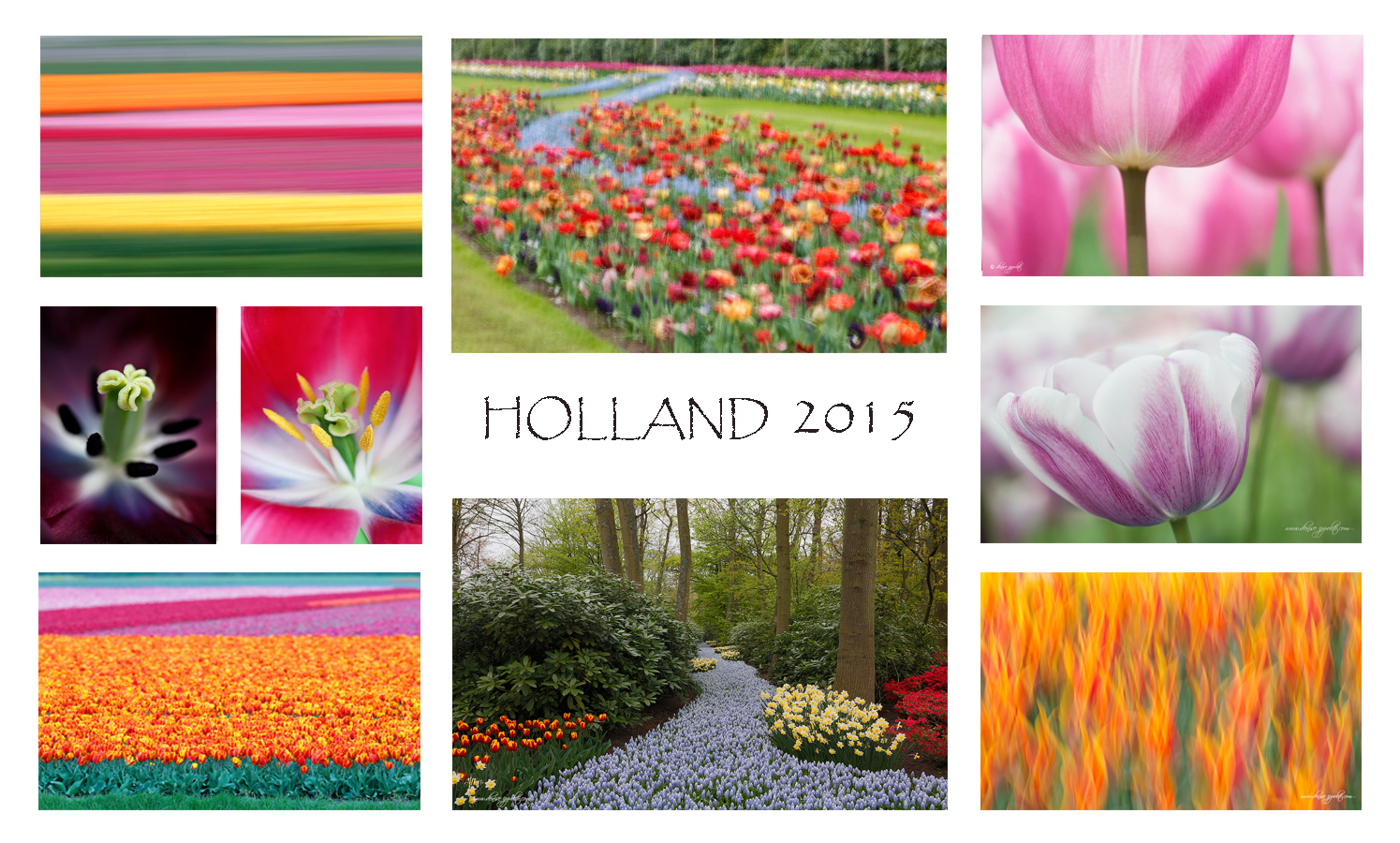
|
|
Denise and artie hope that you can join them next spring in Holland and learn to improve both the technical and creative aspects of your flower (and street) photography.
|
7 1/2-Day/8-Night: A Creative Adventure/BIRDS AS ART/Tulips & A Touch of Holland Instructional Photo-Tour (IPT)
Keukenhof—Delft—Amsterdam–Flower Fields—Kinderdijk
April 9 -April 16, 2015: $4995. Limit: 12 photographers/Openings 10. Four more to make the trip a go.
This trip needs 6 registrants to run so please do not purchase your plane tickets until you hear from us that the trip is a go.
Join Denise Ippolito, the author of “Bloomin’ Ideas,” and Arthur Morris, Canon Explorer of Light Emeritus, for a great trip to Holland in mid-April 2015. Day 1 of the IPT will be April 9, 2015. We will have a short afternoon get-together and then our first photographic session at the justly-famed Keukenhof. Our last day, Day 8, April 16 will be a full day of photography.
The primary subjects will be tulips and orchids at Keukenhof and the spectacularly amazing tulip, hyacinth, and daffodil bulb fields around Lisse and points north. We will spend one full day in Amsterdam. There will be optional visits to the Van Gogh Museum, the Anne Frank House and/or the Rijk’s Museum. Street photography and sightseeing will be other options. We will spend a half day at Kinderdijk where we will be photographing the windmills and doing some creative photography. We will spend an afternoon in the lovely Dutch town of Delft where we will do some street photography and shopping. There is an optional church tower tour/climb. We will also enjoy a superb fine dining experience in a traditional restaurant.
Other than the arrival date: April 9, Day 1, and the date of our last day of photography on April 16, Day 8, there is no set itinerary. We will check the weather and play everything by ear to maximize the photographic opportunities. We will try to do Amsterdam, Delft, and especially Kinderdijik, on cloudy days.
There are several huge pluses to this trip. First off, denise is an amazingly skilled and caring instructor. Both her creativity and her willingness to share and to help beginning and intermediate photographers are unmatched. And though artie has learned a ton about flower photography from denise, their styles and techniques do vary considerably. You will have a chance to be counseled by and to learn from both of them. While denise will hunt you down to help you, artie’s teaching style is more “the closer you stay to me, the more you will learn.” Both leaders consistently inspire the participants. And each other. The sky, of course, is the limit.
You will learn to create tight abstracts, how best to use depth-of-field (or the lack thereof) to improve your flower photography, how to get the right exposure and make sharp images every time, how to see the best shot, and how to choose the best perspective for a given situation. And you will of course learn to create a variety of pleasingly blurred flower images. If you bring a long lens, you will learn to use it effectively for flower photography. Denise’s two favorite flower lenses are the Canon EF 100mm f/2.8L Macro IS USM lens and the Canon EF 24-105mm f/4L IS USM lens. Mine are the Canon 100mm f/2.8L IS macro , the Canon EF 180mm f/3.5L Macro USM lens ,and the Canon EF 300mm f/2.8L IS II USM lens, all almost always on a tripod. Often with extension tubes and/or either the 1.4X or the 2X (with the 300 II) teleconverters. Denise hand holds a great deal of the time. For flower field blurs denise uses the same lenses mentioned above along with her new 70-200mm f/2.8L IS III lens. Artie’s favorite is that same 70-200 often with a 1.4X TC but he uses both the new Canon EF 24-70mm f/2.8L II USM lens and the 300 II as well. Both of us use and love the Canon EOS 5D Mark III for all of our flower photography. The in-camera HDR and Multiple Exposure features are a blast.
One of the great advantages of our trip is that we will be staying in a single, strategically located hotel that is quite excellent. Do note that all ground transfers to and from Schipol Airport will be via the free hotel shuttle bus.
What’s included: Eight hotel nights. All ground transportation except for airport transfers as noted above. In-the-field instruction and small group image review and Photoshop sessions. All meals from dinner on Day 1 through dinner on Day 8. There is good food at the hotel and we will be dining there on occasion; whenever you order off the menu be it at the hotel or at another restaurant only the cost of your main course is included. On these occasions the cost of soups, appetizers, salads, sodas and other beverages, alcoholic drinks and wine, bottled water, and desserts are not included. Snacks, personal items, phone calls, etc. are also not included. The cost of bus or train transportation to and from Amsterdam (about $20 US), museum entry, and tower and church entry fees (optional) are likewise not included.
Beware of seemingly longer, slightly less expensive tours that include travel days and days sitting in the hotel doing nothing as part of the tour. In addition, other similar trips have you changing hotels often and needlessly. One final note on other similar trips: the instructors on this trip actually instruct. On other similar trips the instructors, though usually imminently qualified, serve for the most part as van drivers and van door openers.
A non-refundable deposit of $1,000 per person is required to hold your spot. The second payment of $2,000 due by October 30, 2014. The balance is due on January 15, 2015. Payments in full are of course welcome at any time. All payments including the deposit must be by check made out to “Arthur Morris.” As life has a way of throwing an occasional curve ball our way, you are urged to purchase travel insurance within 15 days of our cashing your check. Artie uses and recommends Travel Insurance Services. All payments are non-refundable unless the trip fills to capacity. In that case, all payments but your deposit will be refunded. If the trip does not run every penny will of course be refunded. Again, please do not purchase your air tickets until you hear from us that the trip is a go. We are very confident that it will.
All checks should be made out to “Arthur Morris” and sent to: Arthur Morris, PO Box 7245, Indian Lake Estates, FL 33855. Call Jim or Jen in the BAA office with any additional registration questions: 863-692-0906.
For couples or friends signing up at the same time for the tulip trip, a $200/duo discount will be applied to the final payment.
When you send your deposit check, please print, sign, and include the paperwork here.
If you have any questions on the trip please contact artie by e-mail or denise by e-mail.
Facebook
Be sure to like and follow BAA on Facebook by clicking on the logo link upper right. Tanks a stack!
Support the BAA Blog. Support the BAA Bulletins: Shop B&H here!
We want and need to keep providing you with the latest free information, photography and Photoshop lessons, and all manner of related information. Show your appreciation by making your purchases immediately after clicking on any of our B&H or Amazon Affiliate links in this blog post. Remember, B&H ain’t just photography!
…..
Amazon.com
Those who prefer to support BAA by shopping with Amazon may use this link:
Amazon Canada
Many kind folks from north of the border, ay, have e-mailed stating that they would love to help us out by using one of our affiliate links but that living in Canada and doing so presents numerous problems. Now, they can help us out by using our Amazon Canada affiliate link by starting their searches by clicking here. Many thanks to those who have written.
Typos
In all blog posts and Bulletins, feel free to e-mail or to leave a comment regarding any typos, wrong words, misspellings, omissions, or grammatical errors. Just be right. 🙂
September 6th, 2014 The Streak Continues: 280
This blog was published at about 6:15am from my home in Indian Lake Estates, FL after another good night’s sleep. I enjoyed a nice swim again yesterday and a rather lazy day. Though both the left shoulder and right knee are feeling pretty darned good this morning, only time will reveal the effects of the recent stem cell/PRP/Prolozine injections. Healing takes time. This post, which took me about 2 1/2 hours to prepare, makes 280 in a row. 365 is well within sight….
As always, I would appreciate your using the BIRDS AS ART B&H affiliate links for all of your major gear, video, and electronic purchases, using our Amazon logo-link for all of your household purchases, and visiting the BAA Online Store for your tripod, tripod head, LensCoat, miscellaneous, accessories, and eGuide purchases as well. Please remember, web orders only. 🙂
You can find the following items in the store: Gitzo tripods, Mongoose M3.6 and Wimberley heads, plates, low feet, and accessories, flash brackets, , Delkin e-film Pro Compact Flash Cards, LensCoat products, and our unique line-up of educational materials including ABP I & II, Digital Basics, Site and Set-up e-Guides, Canon and Nikon Camera Users and AF e-Guides, and MP-4 Photoshop video tutorials among others.
For the photographic stuff mentioned in the paragraph above we, meaning BAA, would of course greatly appreciate your business. Purchasing the items listed above actually hurts us :). Here is a huge thank you to the many who have been using our links on a regular basis and visiting the BAA Online store as well.
Despicable Tales
If you hear a despicable tale about someone please take a moment to consider both the source and the source’s motives….
|
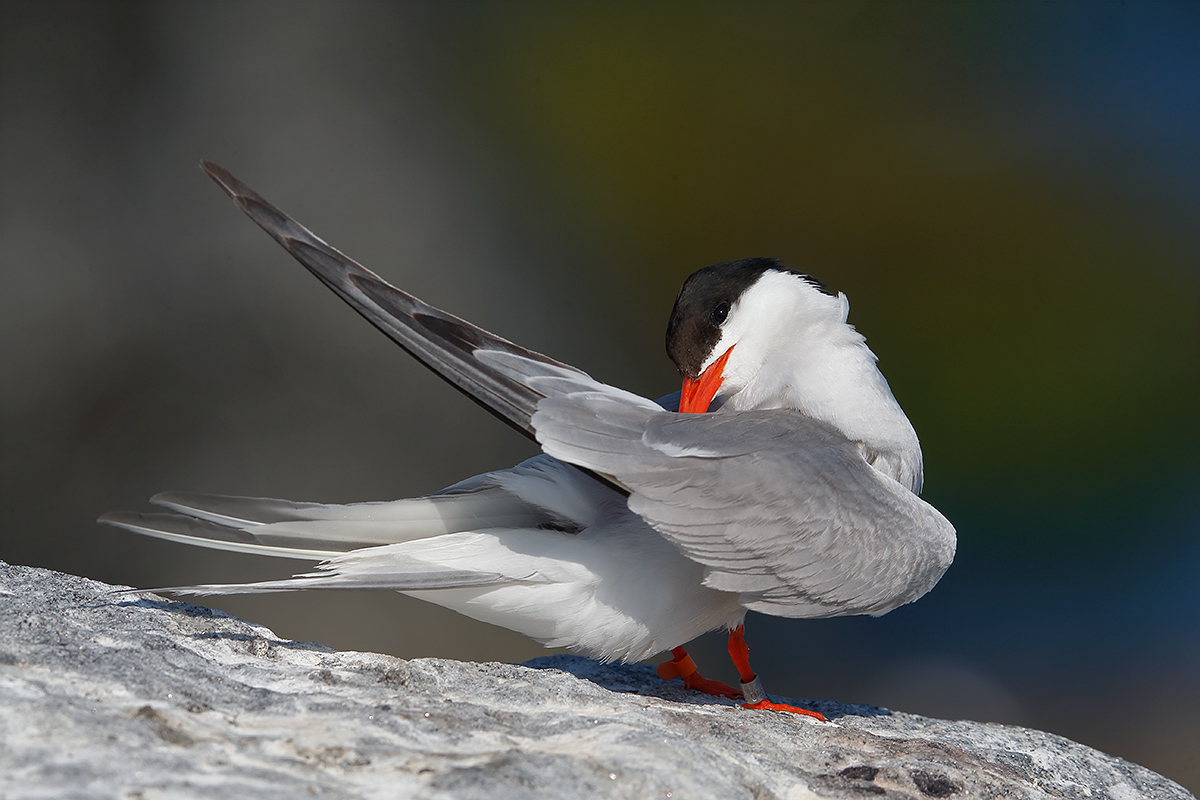
|
|
This image was created at 9:03:55am on July 25, 2014 at Great Gull Island with the Gitzo 3532 LS carbon fiber tripod, the Mongoose M3.6 head, the Canon EF 600mm f/4L IS II USM lens, the Canon Extender EF 2X III, and the Canon EOS-1D X. ISO 400. Evaluative metering -1/3 stop as framed: 1/1250 sec. at f/11 in Manual mode. With brilliant WHITEs in full sun you will never be far off the right exposure at 1/2500 sec. at f/8 or, as here, an equivalent exposure.
Central Sensor (by necessity)/AI Servo-Expand/Rear Focus AF on the base of the tern’s neck and re-compose. Click here to see the latest version of the Rear Focus Tutorial. Click on the image to see a larger version.
Image #1: Common Tern/Perfect Preening Head Angle
|
1D X Frame Rate
Eighty-one frames in 20 seconds. Seven keepers, the three best of those presented here. While the frame rate sounds impressive, it is but a fraction of what the Canon EOS-1D X is capable of. I could have created well more than 200 images in those 20 seconds but I fired only when there was a chance that the tern’s head would be in a decent position relative to its body. And I paused several times to re-focus.
That said, the speed of the 1D X enables bird photographers to capture instants in time that they may not have been able to see with the human eye. If you see the tern grab ones of its primaries in its bill while preening, it is too late to press the shutter button. Folks need to learn to anticipate the best potential positions and then hold the shutter button down for short rapid fire bursts of three to six or more frames. Remember however that if you are working with a shutter speed of 1/1000 sec. with a camera that fires 10 fps and you hold the shutter button down for exactly one second you will still be missing 99% of the action….
None-the-less, the Canon EOS-1D X is by far the best camera that I have ever owned or used for creating images of birds in flight or in action. On many occasions it has enabled me to capture special moments that I never saw or envisioned.
If reading this post has convinced you to finally purchase a 1D X please consider using the B&H BAA affiliate logo link below. And please remember, web orders only. E-mail us a copy of your B&H receipt and we will be glad to send along a free copy of my EOS-1D X AF Guide.
|
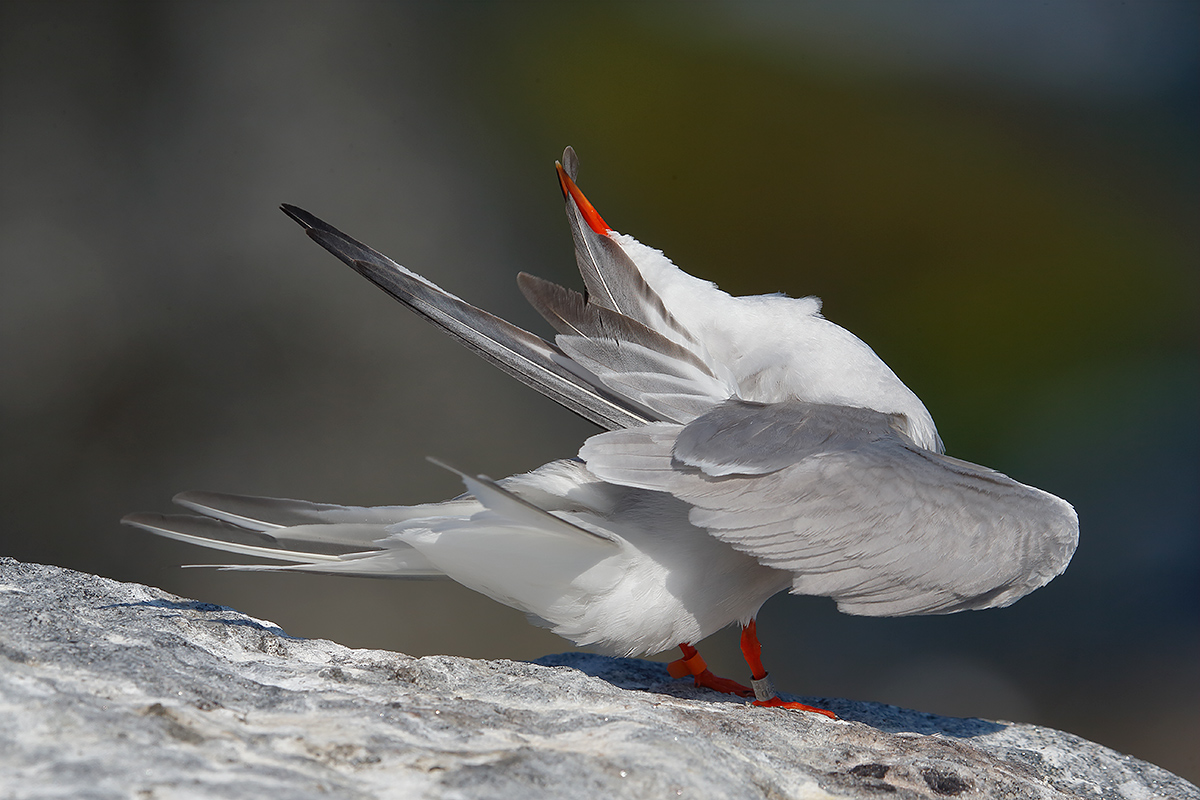
|
|
This image was created at 9:03:56am on July 25, 2014 at Great Gull Island with the Gitzo 3532 LS carbon fiber tripod, the Mongoose M3.6 head, the Canon EF 600mm f/4L IS II USM lens, the Canon Extender EF 2X III, and the Canon EOS-1D X. ISO 400. Evaluative metering -1/3 stop as framed: 1/1250 sec. at f/11 in Manual mode. With brilliant WHITEs in full you will never be far off the right exposure at 1/2500 sec. at f/8 or, as here, an equivalent exposure.
Central Sensor (by necessity)/AI Servo-Expand/Rear Focus AF on the base of the tern’s neck and re-compose. Click here to see the latest version of the Rear Focus Tutorial. Click on the image to see a larger version.
Image #2: Common Tern/Where’s the Eye?
|
Image Optimization Questions
Would you have chosen to remove the metal band and the orange plastic leg flag (where visible)? Why or why not?
Photoshop Trickery Question
After enlarging each image let us know if you see any absolute evidence of a major change or changes made in Photoshop.
|
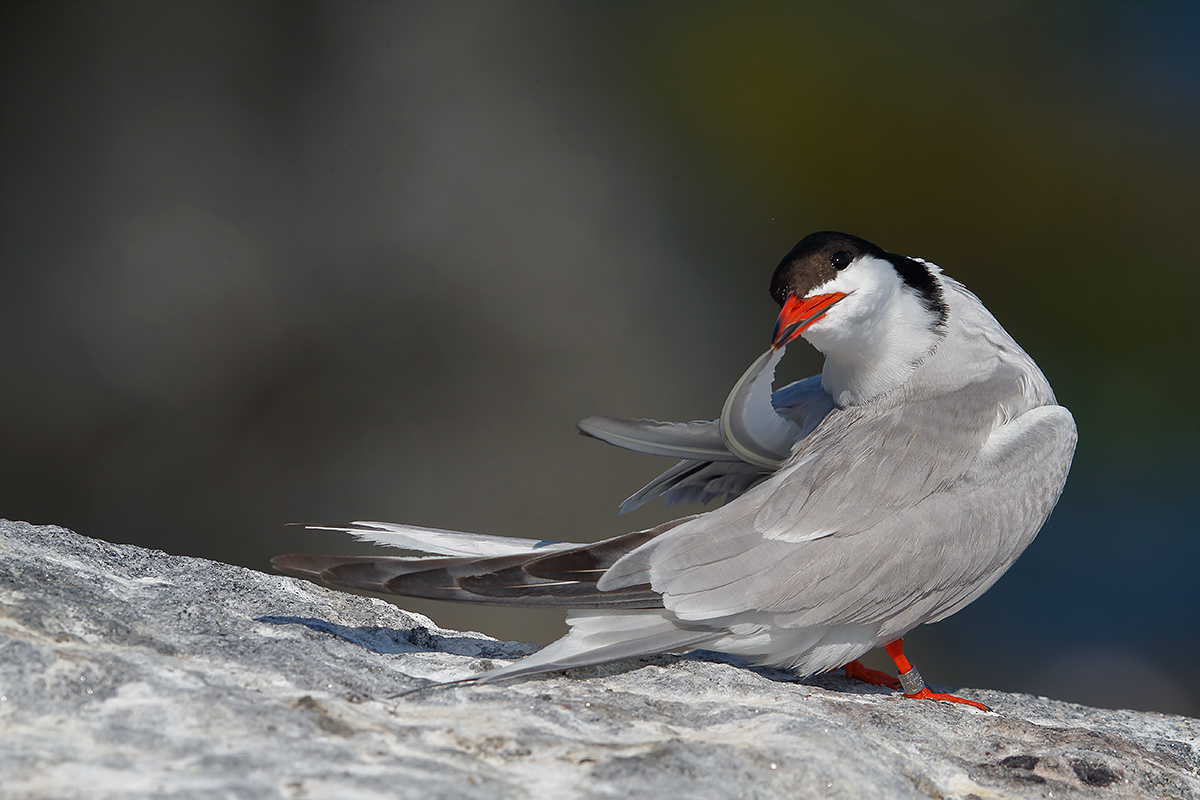
|
|
This image was created at 9:03:59am on July 25, 2014 at Great Gull Island with the Gitzo 3532 LS carbon fiber tripod, the Mongoose M3.6 head, the Canon EF 600mm f/4L IS II USM lens, the Canon Extender EF 2X III, and the Canon EOS-1D X. ISO 400. Evaluative metering -1/3 stop as framed: 1/1250 sec. at f/11 in Manual mode. With brilliant WHITEs in full you will never be far off the right exposure at 1/2500 sec. at f/8 or, as here, an equivalent exposure.
Central Sensor (by necessity)/AI Servo-Expand/Rear Focus AF on the base of the tern’s neck and re-compose. Click here to see the latest version of the Rear Focus Tutorial. Click on the image to see a larger version.
Image #3: Common Tern/”The Curve”
|
The Best Image
Please take a moment to let us know which of the 3 images you feel is the strongest. And why. Feel free to let us know what you like or don’t like about each of the three images.
Image Flaw Question
Images #1 and #2 each have a similar flaw that is not seen in Image #3. What is it?
Blog Interactivity
While it is great that an average of more than 2,000 folks visit and learn from the blog each day it would be wonderful if more than a handful of folks tackled the questions that are designed to make the blog more interactive and less static.
Important Bosque Festival of the Cranes Event Registration Notice
Registration for all Festival of the Cranes workshops, seminars and programs is open. Please click here and read carefully to avoid missing out on several wonderful and inexpensive educational opportunities. Please do not tarry as we expect all of the BAA/A Creative Adventure sessions to sell out quickly, especially the early morning In-the-Field Workshops. You can click http://www.festivalofthecranes.com“>here to register.


Facebook
Be sure to like and follow BAA on Facebook by clicking on the logo link upper right. Tanks a stack!
Support the BAA Blog. Support the BAA Bulletins: Shop B&H here!
We want and need to keep providing you with the latest free information, photography and Photoshop lessons, and all manner of related information. Show your appreciation by making your purchases immediately after clicking on any of our B&H or Amazon Affiliate links in this blog post. Remember, B&H ain’t just photography!
…..
Amazon Canada
Many kind folks from north of the border, ay, have e-mailed stating that they would love to help us out by using one of our affiliate links but that living in Canada and doing so presents numerous problems. Now, they can help us out by using our Amazon Canada affiliate link by starting their searches by clicking here. Many thanks to those who have written.
Typos
In all blog posts and Bulletins, feel free to e-mail or to leave a comment regarding any typos, wrong words, misspellings, omissions, or grammatical errors. Just be right. 🙂
September 5th, 2014 The Streak Continues: 279
This blog was published at 7:45am from my home in Indian Lake Estates, FL after another good night’s sleep. I enjoyed an easy swim yesterday; only time will reveal the effects of the stem cell/PRP/Prolozine injections in my right shoulder (the 2nd set) and left knee. Healing takes time. This post, which took me about 3 hours to prepare, makes 279 in a row.
As always, I would appreciate your using the BIRDS AS ART B&H affiliate links for all of your major gear, video, and electronic purchases, using our Amazon logo-link for all of your household purchases, and visiting the BAA Online Store for your tripod, tripod head, LensCoat, miscellaneous, accessories, and eGuide purchases as well. Please remember, web orders only. 🙂
You can find the following items in the store: Gitzo tripods, Mongoose M3.6 and Wimberley heads, plates, low feet, and accessories, flash brackets, , Delkin e-film Pro Compact Flash Cards, LensCoat products, and our unique line-up of educational materials including ABP I & II, Digital Basics, Site and Set-up e-Guides, Canon and Nikon Camera Users and AF e-Guides, and MP-4 Photoshop video tutorials among others.


I would of course appreciate your using our B&H affiliate links for all of your major gear, video, and electronic purchases. For the photographic stuff mentioned in the paragraph above we, meaning BAA, would of course greatly appreciate your business. Here is a huge thank you to the many who have been using our links on a regular basis and visiting the BAA Online store as well.
|
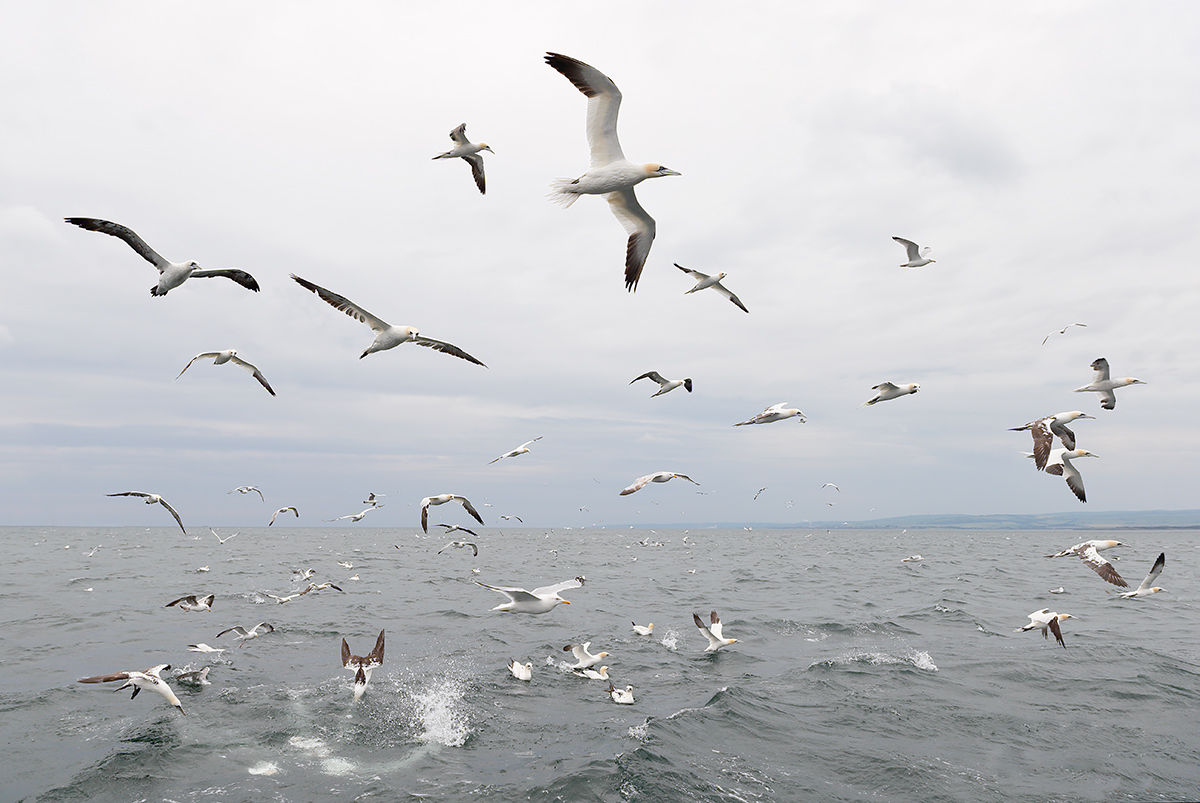
|
|
This image was created on last July’s UK Puffins and Gannets IPT with the Canon EF 24-70mm f/2.8L II USM lens (hand held at 24mm) and the Canon EOS-1D X. ISO 800. Evaluative metering +1 2/3 stops off the sky: 1/2000 sec. at f/4.5 in Manual mode. Color temperature: Cloudy.
Central sensor/AI Servo/Surround Rear Focus AF on the closest gannets hitting the water and re-compose. Click here to see the latest version of the Rear Focus Tutorial. Click on the image to see a larger version.
|
Ah, The Insanity Of It…
Once the mate began tossing fish and the gannets came, it was pure chaos. Within the hour, folks began taking extended rests, too exhausted even to lift their 70-200s. Once in a while I would take short “break” by going for some wide stuff with the 24-70. It is a lot lighter than the 70-200 f/2.8L IS II.
As you might surmise, the big key to creating pleasing images of single birds like the one immediately below is being able to isolate your chosen subject. Going to a longer focal length, a tactic that usually works well when you have problems isolating a single bird in a flock, did not help on the gannet boat because the birds were simply too close. In fact, pretty much everyone in the group removed their 1.4X teleconverters from their 70-200s….
So how do you go about isolating a single gannet? Study and anticipation. I urged the group to simply quit photographing the birds for a minute, to see how they were flying, to note the direction of the wind and the quality and direction of the light. Bird behavior tends to be repetitive.
In the situation pictured above, I might have counseled the group in my loudest voice something like this, “Watch for the birds coming in from our left. Get on one that looks to be in a bit of relatively clear sky and wait until it turns to its right and starts to dive. Then push and hold the shutter button. Be sure to follow through.”
|
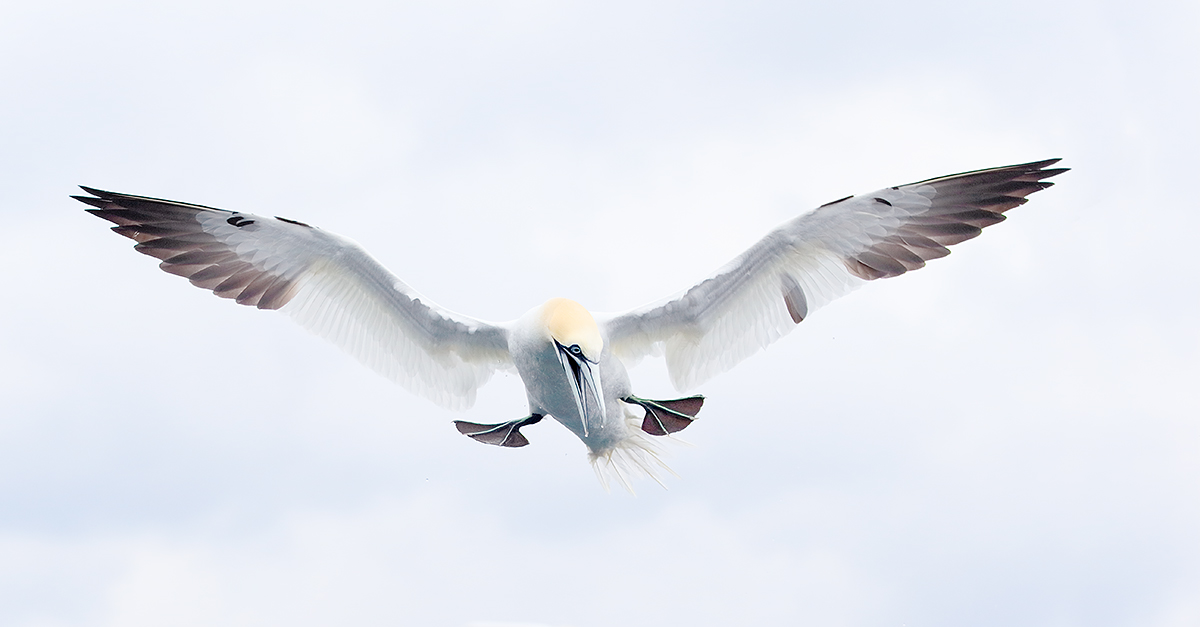
|
|
This image was also created on the gannet boat on the UK Puffins and Gannets IPT, this one with the Canon EF 70-200mm f/2.8L IS II USM lens (hand held at 140mm) and the and the Canon EOS-1D X. ISO 800. Evaluative metering +2 stops off the dreary grey sky was still a significant under-exposure: 1/2000 sec. at f/4 in Manual mode. AWB
Central sensor Surround/AI Servo Rear Focus AF on the bird’s right foot was active at the moment of exposure. Click here to see the latest version of the Rear Focus Tutorial. Click on the image to see a larger version.
Image #2: Spotting the Fish
|
Isolating a Single Bird
In addition to figuring out the flight and diving patterns, isolating a single gannet in the mayhem takes a great deal of determination and some degree of stamina. I still have probably 200 very good images of single gannets in flight to process….
The Image Optimization
First off, I will say that I realize that there are a few of you out there who prefer the original chaotic image to the cleaner more balanced look of the optimized image. I am fine with that but much prefer the optimized version.
Here is an easy multiple choice question: How much time did I spend on the image optimization?
a-about 30 minutes
b-about one hour
c-about 90 minutes
d-very close to two hours
After the conversion in DPP 4.0, the clean-up–as always–was done with a combination of the Clone Stamp Tool, the Spot Healing Brush, the Patch Tool, and many small Quick Masks that were refined via the addition of a Regular Layer Mask. I used both the “Divide and Conquer” and the “Denise Ippolito Protective Cloning on a Layer” techniques. And I used them often. I applied a heavy layer of Image> Blur> Surface Blur and painted that onto the sky via an Inverse or Hide-All Layer Mask to smooth out the bird removal and bird relocation repairs. Near the end I move the whole flock a bit back in the frame using techniques from APTATS II. Lastly I noticed that the image needed to be leveled; that resulted in the need for a small crop.
The DPP RAW Conversion Guide
To learn why I use Canon’s Digital Photo Professional (DPP) to convert every image that I work on, click here. Coming soon: The DPP 4.0 RAW Conversion Guide by Arash Hazeghi and Arthur Morris. The more that I use DPP 4.0 for my RAW conversions the more I am impressed with it. I will be putting in several more hours of work today editing and adding to our new eGuide. Note: at present, DPP 4.0 will work only with 1D X and 5D III images.
Digital Basics
Everything that I did to optimize today’s image is detailed in my Digital Basics File–written in my easy-to-follow, easy-to-understand style. Are you tired of making your images look worse in Photoshop? Digital Basics File is an instructional PDF that is sent via e-mail. It includes my complete digital workflow, dozens of great Photoshop tips, details on using all of my killer image clean-up tools, the use of Contrast Masks, several different ways of expanding and filling in canvas, all of my time-saving Keyboard Shortcuts, Quick Masking, Layer Masking, and NIK Color Efex Pro basics, Digital Eye Doctor, Tim Grey Dodge and Burn, how to create time-saving actions, and tons more.
APTATS I & II
Learn the details of advanced Quick Masking techniques in APTATS I. Learn Advanced Layer Masking Techniques in APTATS I. Mention this blog post and apply a $5 discount to either with phone orders only. Buy both APTATS I and APTATS II and we will be glad to apply at $15 discount with phone orders only. Please call Jim or Jennifer at 863-692-0906 weekdays to order.
|
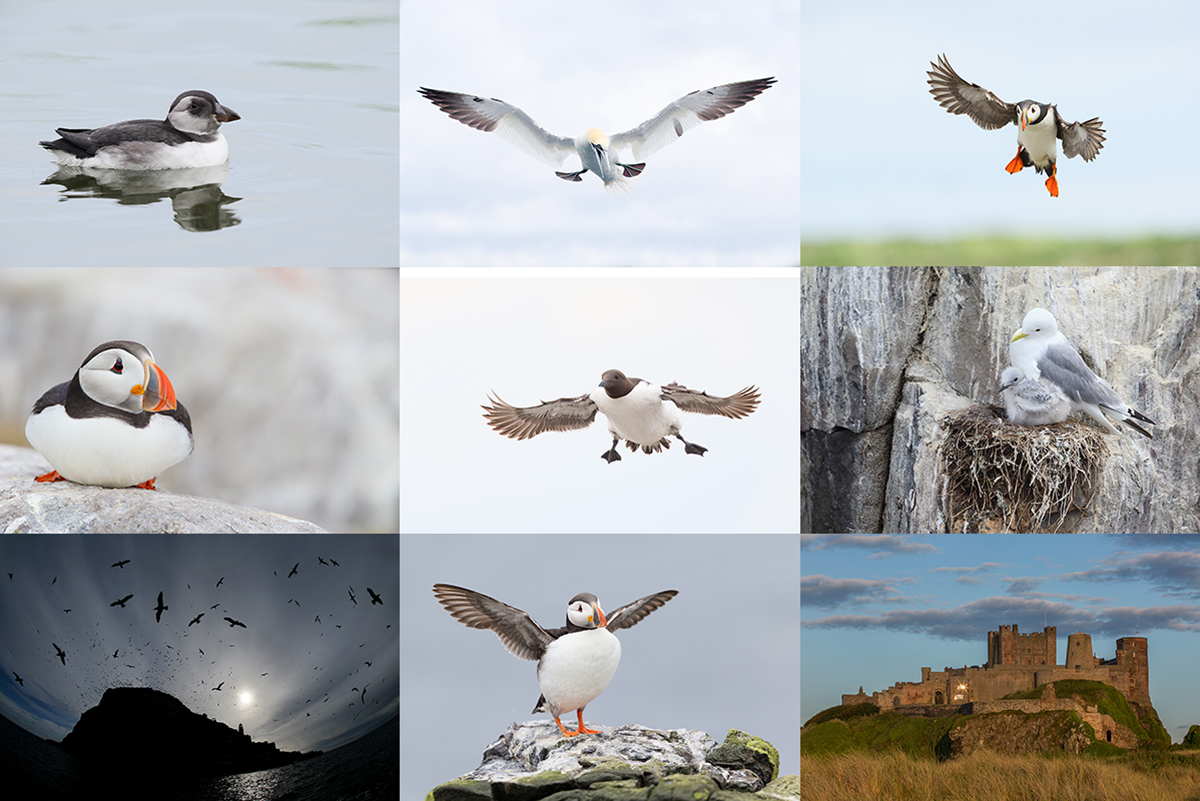
|
|
Images and card design copyright 2014: Arthur Morris/BIRDS AS ART. Click on the card to enjoy a spectacular larger version.
|
The 2015 UK Puffins and Gannets IPT
June 29 through July 5, 2015: $5499: Limit 10 photographers/Openings 2. Two great leaders: Denise Ippolito and Arthur Morris.
Here are the plans for next year: take a red eye from the east coast of the US on 28 June arriving in Edinburgh, Scotland on the morning of Monday 29 June (or simply meet us then either at the Edinburgh Airport (EDI) or later in the day at our cottages if you are driving your own vehicle either from the UK or from somewhere in Europe. Stay 7 nights in two gorgeous modern country cottages.
There are 5 days of planned puffin/seabird trips—weather permitting, and 1 full day of gannet photography with 2 sessions on the boat. (More info below.)
|

|
|
Images and card design copyright 2014: Arthur Morris/BIRDS AS ART. Click on the card to enjoy a spectacular larger version.
|
The Rest of the Fine Details
All breakfasts, lunches and dinners are included. All 5 puffins boat lunches will need to be prepared in advance, taken with, and consumed at your leisure. I usually eat mine on the short boat trip from one island to the other. Also included is a restaurant lunch on the gannet boat day and a farewell fine dining thank you dinner. The cost of your National Heritage Trust is also included; that covers the twice a day landing fees.
Plan to fly home on the early morning of Monday 6 July or to continue your stay or travels.
We are planning this as double-occupancy only but we should be able to arrange for singles by renting a 3rd cottage. We would need to know well in advance, i.e., soon, and it would be pricey and would need to be paid with your non-refundable deposit of $2,000. The shared rooms are decent-sized, each with two roomy single beds and a private bathroom. There are two king rooms available for couples. The upscale country-side cottages are beyond lovely with large living areas and lots of open space for image sharing and Photoshop lessons.
The single supplement is $1475. As we will be renting a third cottage the $1475 is due with your deposit and is also non-refundable.
If you are good to go please send your $2,000 deposit check now to save a spot. We do expect this workshop to sell out very quickly as we have already sold 2 slots even though the trip has not yet been formally announced till right now. Not to mention that everyone loves puffins. Please make your check out to “Arthur Morris” and send it to Arthur Morris/BIRDS AS ART, PO Box 7245, Indian Lake Estates, FL, 33855.
We do hope that you can join us.
Facebook
Be sure to like and follow BAA on Facebook by clicking on the logo link upper right. Tanks a stack!
Support the BAA Blog. Support the BAA Bulletins: Shop B&H here!
We want and need to keep providing you with the latest free information, photography and Photoshop lessons, and all manner of related information. Show your appreciation by making your purchases immediately after clicking on any of our B&H or Amazon Affiliate links in this blog post. Remember, B&H ain’t just photography!
…..
Amazon Canada
Many kind folks from north of the border, ay, have e-mailed stating that they would love to help us out by using one of our affiliate links but that living in Canada and doing so presents numerous problems. Now, they can help us out by using our Amazon Canada affiliate link by starting their searches by clicking here. Many thanks to those who have written.
Typos
In all blog posts and Bulletins, feel free to e-mail or to leave a comment regarding any typos, wrong words, misspellings, omissions, or grammatical errors. Just be right. 🙂
September 4th, 2014 Helen Hayes/Great Island “CBS This Morning” Feature Aired Yesterday
It was wonderfully done. Older daughter Jennifer and I laughed a lot. Helen’s understated humor cracked us up. When Michelle Miller asked “How did you learn to get along with them?” Helen answered,
“Oh, I got a hat. That made all the difference.” (Tern researchers wear a variety of headgear designed to keep the birds from opening up their scalps while defending their eggs, young, and territories.)
I was happy to see six BAA tern images on TV in the CBS “Taking Flight/Researcher helps migratory birds make a comeback” feature. It was yet another great tribute to the amazing ornithologist, Helen Hays. Those of you who did not get to see or tape it can enjoy “Woman revives Great Gull Island’s tern population” hereor on You Tube here. Thanks to Jay for leaving a comment with the link to the story on the CBS website and to Andrew Grandys for the You Tube link.


Important Bosque Festival of the Cranes Event Registration Notice
Registration for all Festival of the Cranes workshops, seminars and programs is open. Please click here and read carefully to avoid missing out on several wonderful and inexpensive educational opportunities. Please do not tarry as we expect all of the BAA/A Creative Adventure sessions to sell out quickly, especially the early morning In-the-Field Workshops.
The Streak Continues: 278
This blog was published just before 7:15am from my home in Indian Lake Estates, FL after another good night’s sleep. I did have stem cell/PRP/Prolozine injections in my right shoulder (the 2nd set) and the first ones for my left knee. The procedures were a lot more painful than they were the first time around. A very lot…. This post, which took me about 3 hours to prepare, makes 278 in a row.
As always, I would appreciate your using the BIRDS AS ART B&H affiliate links for all of your major gear, video, and electronic purchases, using our Amazon logo-link for all of your household purchases, and visiting the BAA Online Store for your tripod, tripod head, LensCoat, miscellaneous, accessories, and eGuide purchases as well.
Mysterious All Around…
Exploring old abandoned buildings in the Palouse was an exciting adventure, as was exploring the entire, insanely beautiful region.
#1: Aside from the grasses, what exactly are we looking at (or through)?
#2: Where was I standing?
#3: Why -1 stop? (A peek at the DPP 4.0 screen capture below might help.)
#4: Describe the lighting.
#5: What setting accentuated the ORANGE tones in the image?
|

|
|
This is a DPP 4.0 screen capture for today’s featured image.
|
DPP 4.0
In the new DPP 4.0 RAW eGuide Arash Hazeghi and I will teach you how to set up and customize DPP 4.0 so that it is most efficient. We teach you how and why to view the various palettes and where to put them. And we teach you how to set and use those two long bars each with lots of buttons and icons. As I said originally, DPP 4.0 is a whole different animal as compared to previous iterations of Canon Digital Photo Professional. There is a somewhat steep learning curve–heck, that’s what we are here for, but the results are clearly superior to those attained with any other RAW converter. I am working hard every day at re-crafting Arash’s original and brilliant first draft and each weekend we fine-tune things with a long phone conference. Writing is a process, a difficult one at best….
Most obvious in the screen capture above is the stuff in BLUE, the Shadow warnings. Those with good vision will see a smattering of Highlight warnings in RED. Likewise, those with perfect vision will note that the active AF sensor is illuminated in RED. The hard-to-see items are of course plainly visible on your laptop or computer monitor; here we are limited by the presentation of a small JPEG image file.
|
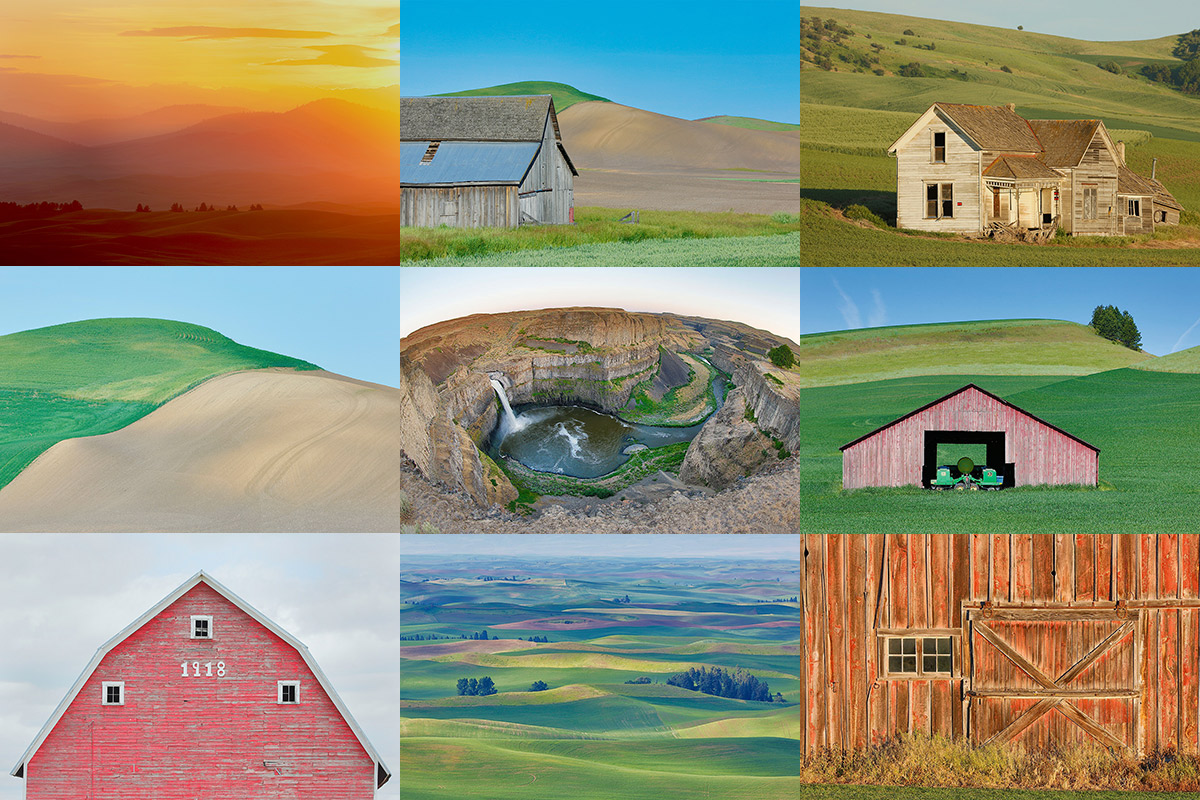
|
|
Please note that there are two Palouse IPTs in place. Hope that you can join us 🙂 Card and design by Arthur Morris/BIRDS AS ART.
|
The Palouse A Creative Adventure/BIRDS AS ART Instructional Photo-Tour (IPT)/Eastern Washington State. June 5-9, 2015/5 Full Days: $1699/Limit 12 photographers/Openings 4; this trip is a go.
Rolling farmlands provide a magical patchwork of textures and colors, especially when viewed from the top of Steptoe Butte where we will likely enjoy spectacular sunrises and possibly a nice sunset or two. We will photograph grand landscapes and mini-scenics of the rolling hills and farm fields. We will take you to some really neat old abandoned barns and farmhouses in idyllic settings. There is no better way to improve your compositional and image design skills and to develop your creativity than to join us for this trip. Two great leaders: Denise Ippolito and Arthur Morris. Photoshop and image sharing sessions when we have the time and energy…. We get up early and stay out late and the days are long. For a sample of what you will be learning, click here.
After 6 days of back-breaking scouting work in early June 2014 we found all of the iconic locations and, in addition, lots of spectacular new old barns and breath-taking landforms and views. We will teach you what makes one situation prime and another seemingly similar one a waste of your time.
What’s included: In-the-field instruction, guidance, lessons, and inspiration, our newfound but very extensive knowledge of the area, all lunches, motel lobby breakfasts, and Photoshop and image sharing sessions when possible.
You will learn and hone both basic and advanced compositional and image design skills. You will learn to get the right exposure every time. You will learn to develop your creative eye. You will learn the basics of HDR (high dynamic range) photography. You will learn a variety of in-camera creative techniques; Canon 5D Mark III bodies are a plus. And most importantly you will learn to see the situation and to create a variety of top-notch images. Do see both of our blogs for lots more on that in the coming weeks. You will learn how the quality and direction of light combine to determine the success of your images. And–please don’t gasp–we will be working quite a bit with sidelight when creating landscapes. Lastly, we will be touching on infrared photography.
A non-refundable $699 deposit is due now. The balance will be due on January 29, 2015. With the unpredictable nature of the photography business, I have not said this often lately, but it seems quite likely that this one will fill up very quickly. Please let me know via e-mail that you will be joining us. Then you can either call Jim or Jennifer at 863-692-0906 during business hours or send us a check; the latter is preferred.
Please send your deposit check made out to “Arthur Morris” to us at Arthur Morris/BIRDS AS ART, PO Box 7245, Indian Lake Estates, FL, 33855. If you have any questions, please feel free to contact me via e-mail. You can also contact denise via e-mail here
Facebook
Be sure to like and follow BAA on Facebook by clicking on the logo link upper right. Tanks a stack!
Support the BAA Blog. Support the BAA Bulletins: Shop B&H here!
We want and need to keep providing you with the latest free information, photography and Photoshop lessons, and all manner of related information. Show your appreciation by making your purchases immediately after clicking on any of our B&H or Amazon Affiliate links in this blog post. Remember, B&H ain’t just photography!
…..
Amazon Canada
Many kind folks from north of the border, ay, have e-mailed stating that they would love to help us out by using one of our affiliate links but that living in Canada and doing so presents numerous problems. Now, they can help us out by using our Amazon Canada affiliate link by starting their searches by clicking here. Many thanks to those who have written.
Typos
In all blog posts and Bulletins, feel free to e-mail or to leave a comment regarding any typos, wrong words, misspellings, omissions, or grammatical errors. Just be right. 🙂
September 3rd, 2014 Important “CBS This Morning” News Flash Update
Helen Hayes/Great Island Feature Re-scheduled.
8:51am EDT. The feature just aired. It was wonderful and I laughed a lot. And they used some of my images. I hope that each of you got it on tape or Tivo or got to watch it. It is not too late for those in time zones to the west.
A Wonderful and Moving Tribute to Helen HaysVia a comment on the blog by Glen Fox
September 2, 2014 at 4:13 pm
Artie, Thank you for this photo and head-up regarding the CBS interview with Helen Hayes. I first came acquainted with Helen in 1957, at the American Ornithologists Union meeting in Regina, SK. when I was a 14yr old budding ornithologist. I remember distinctly the cheers and wolf whistles that went up as Helen, then a newly-minted waterfowl biologist crossed the stage to present her paper, and the extended applause she received after her presentation from all her male contemporaries. You see, Helen was a pioneer, and one of the very first female wildlife biologists of her day. Later, in the early 1970s, we worked together editing my manuscript on Common Terns based on my graduate thesis. Helen was then the editor of The Wilson’s Bulletin, and with her help, that manuscript won a prize as the best paper to be published in that journal that year. Later, when I was a biologist with the Canadian Wildlife Service, we corresponded on deformities in fish-eating birds. Helen Hays has been a mentor and source of encouragement to hundreds of young people as she was to your Jennifer and her husband Erik. Her extensive data set on Common and Roseate Terns collected over the past 47 years will be a goldmine of information. Rarely do studies last more than 10 years, let alone 47! Hats off to the 80-something year old wonder lady with the yellow flowers in her straw hat. She is still a classy act and an inspiration to us all.. Yeah Helen!
On September 2, 2014 at 4:35 pm I responded:
Glen, Thanks for sharing your powerful and moving tribute to Helen with us here.
I wrote an article about Helen for the now defunct “Birder’s World Magazine” about 20 years ago. It was entitled “One Good Tern Lady.” At one point I had several hard copies but have lost track of those. I have been trying without success to find one so that I could scan the article…. Perhaps you or someone else has a copy…. best and thanks again, artie
Important Bosque Festival of the Cranes Event Registration Notice
Registration for all Festival of the Cranes workshops, seminars and programs will be open for all today at 9:00am MDT (11:00am EDT). Please click here and read carefully to avoid missing out on several wonderful and inexpensive educational opportunities. Please do not tarry as we expect all of the BAA/A Creative Adventure sessions to sell out quickly, especially the early morning In-the-Field Workshops.
The Streak Continues: 277
This blog was published just after 6:00am from my home in Indian Lake Estates, FL after another good night’s sleep. We head to Tampa today for another stem cell/PRP/Prolozine injection treatment for my right shoulder and the first one for my left knee. This post, which took me about two hours to prepare, makes 277 in a row.
As always, I would appreciate your using the BIRDS AS ART B&H affiliate links for all of your major gear, video, and electronic purchases, using our Amazon logo-link for all of your household purchases, and visiting the BAA Online Store for your tripod, tripod head, LensCoat, miscellaneous, accessories, and eGuide purchases as well.
Web Orders Only Please!
Though we have let you know in the past that BAA will receive affiliate credit only for web orders, several well meaning folks have placed B&H orders by phone after calling and being told by the salesman that “BIRDS AS ART will absolutely earn credit for this purchase. Please understand that that is not the case. BAA affiliate credit is earned only on orders placed on the web.
I greatly appreciate those of you who have been placing your gear orders on the web while using our B&H (or Amazon) affiliate links.
Catching Up on Photography Fine Points
From time to time–but probably not often enough–I like to go back and take a look at the answers to the questions that are sprinkled throughout various blog posts.
|
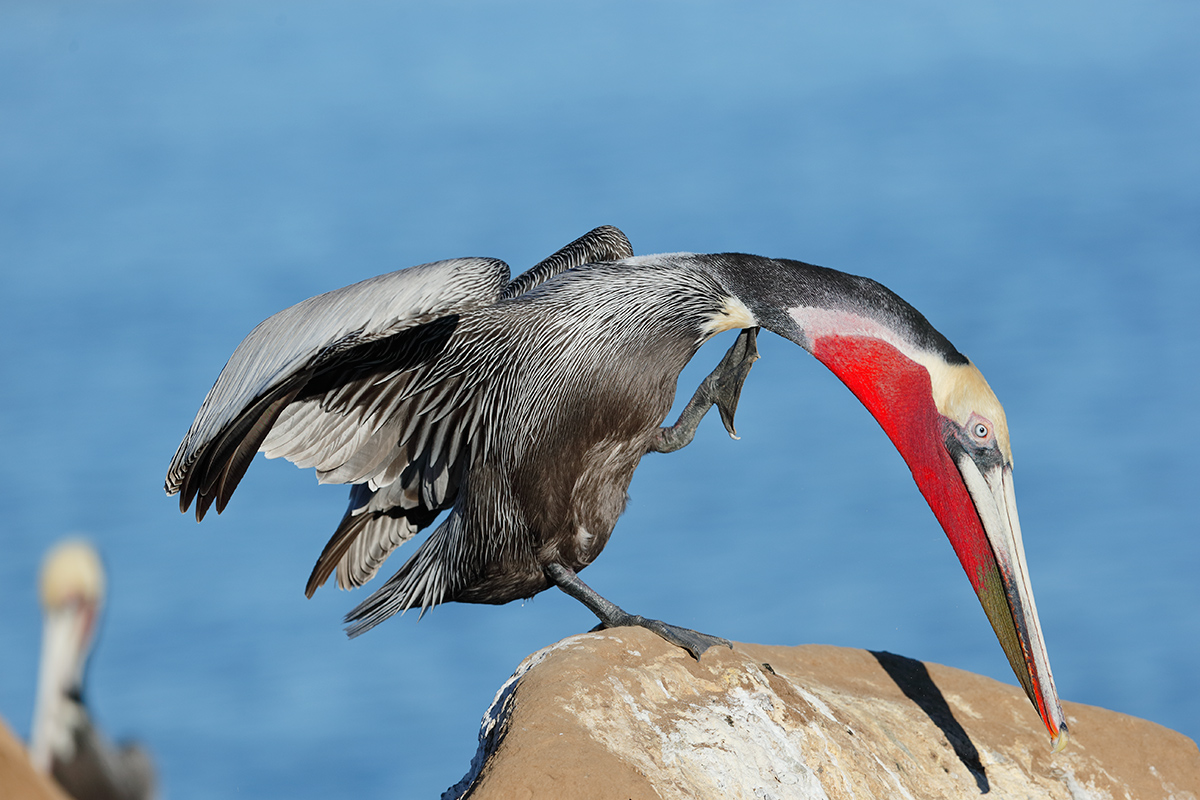
|
|
This image was created at 8:11am in full sun on last year’s Short Notice San Diego IPT with the hand held Canon EF 300mm f/2.8L IS II USM lens and the Canon EOS-1D X. ISO 400. Evaluative metering at zero: 1/4000 sec. at f/4.5 in Manual mode.
Central sensor/AI Servo/Surround Rear Focus AF as originally framed (see below) was active at the moment of exposure. Click here to see the latest version of the Rear Focus Tutorial. Click on the image to see a larger version. See image next for the original capture.
|
Mommy, Why are Their Bills So Red?
In yesterday’s Mommy, Why are Their Bills So Red? blog post, I asked:
#1: Why didn’t I simply point my lens to the right to eliminate the out-of-focus pelican behind the subject and have more room in front of the bird?
Nobody came close on this one…. At 1/4000 sec. at f/4.5 with central sensor AI Servo Surround set some might surmise that I had been concentrating on flight photography. They would have been correct. When I saw the pelican scratching, I got as low as I could to eliminate the rocks right behind the bird. I was not able to get low enough to separate the pelican’s bill from the rock. I knew that there was too much room behind the bird and not enough room in front but I did not want to miss the scratching action. The problem stemmed from the fact that central sensor Surround AF was active; if I pointed the lens to the right for better framing the active sensor would have been on the distant ocean. I remember being reluctant to move the active AF sensor as I was not sure of what would have been the best choice.
Knowing now what I did not know then about 61-Point AF, I would have realized that 61-Point Automatic selection would have been perfect for this situation as I was almost parallel to the bird…. Once I acquired focus I would have been able to re-compose right without losing focus….
#2: Had I been able to get lower, how would that have helped the image?
As noted above, had I been able to get lower I could have eliminated the merge of the tip of the bill with the rock. Kudos to David Policansky for leaving a comment and nailing that one.
|
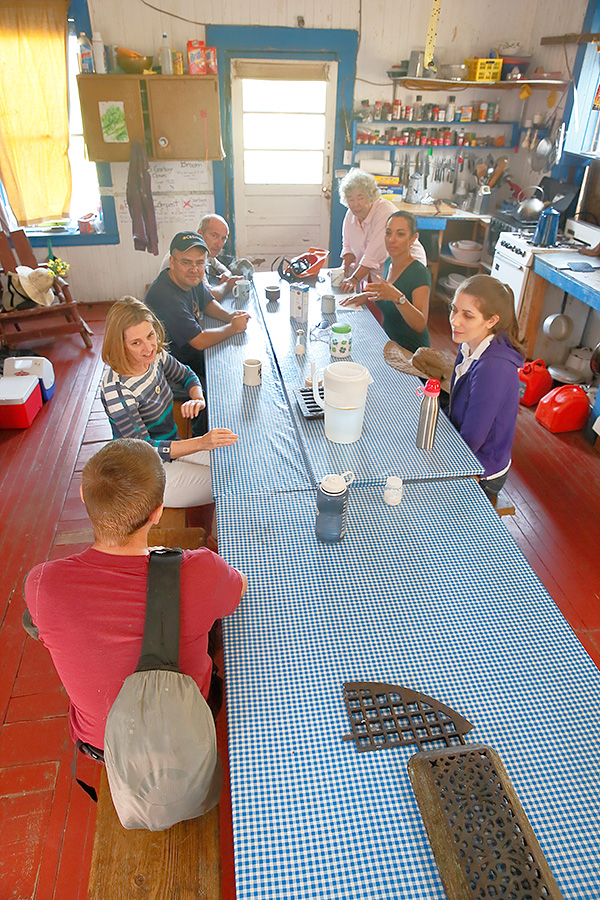
|
|
This image was created with the Canon EF 24-70mm f/2.8L II USM lens (hand held at 24mm) and the Canon EOS-1D X. ISO 1600. Evaluative metering +1/3 stop: 1/60 sec. at f/5.6 in Av mode. Color temperature: AWB.
Central sensor/AI Servo/Surround Rear Focus AF on the head of the young man with his back to the camera and and re-compose. Click here to see the latest version of the Rear Focus Tutorial. Click on the image to see a larger version.
|
Important CBS This Morning News Flash for Tuesday, September 2, 2014
In the “Important CBS This Morning News Flash for Tuesday, September 2, 2014” blog post here, I asked, referring to the image created in the GGI kitchen, why I should have gone with an HDR (High Dynamic Range) series. When you are photographing indoors with a window to the outside world going HDR is often the best and only solution. Note that both windows as well as the blue & white checkerboard oilcloth at the far end of the table were mega-over-exposed.
I followed the standard advice of going “high and wide for people” and was standing on one of the bench seats. Being indoors I was at a necessarily slow shutter speed despite having set a high ISO so in order to create a usable HDR series I would have needed to have my rig on a tripod. But that was not possible with me standing on the bench seat. You get the picture. So I went with a straight image capture and lived with the toasted windows and tablecloth.
Had my EOS-5D Mark III not been on the fritz I would have gone with in-camera HDR Natural with Auto Align set and hoped for the best….
|
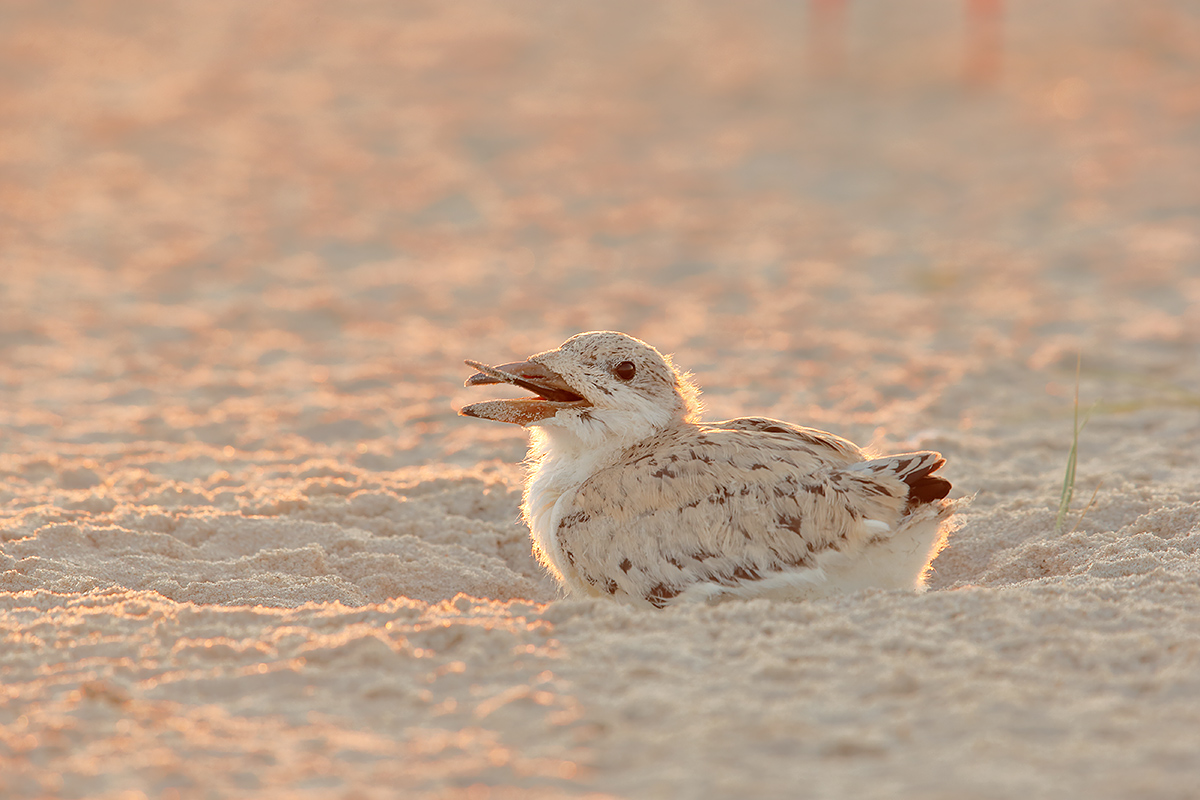
|
|
This image was created at Nickerson Beach at 6:33am on the clear morning of 25 August, 2014 with the Gitzo 3532 LS carbon fiber tripod, the Mongoose M3.6 head, the Canon EF 600mm f/4L IS II USM lens, the Canon Extender EF 2X III, and the Canon EOS-1D X. ISO 1600. Evaluative metering +1 2/3 stops as framed: 1/160 sec. at f/9 in Manual mode.
Central Sensor (by necessity)/AI Servo-Expand/Rear Focus AF on the base of the bird’s face and release. When you add the 2X TC to an f/4 lens with the 1DX or the 5D III hit the MFn button once to toggle to AF Expand and enjoy 4 extra AF sensors. Learn everything there is to know about the 1D X and 5D III AF systems including how to manage the various AF Area Selection Modes, when to use which one, and several ways to move the AF sensor around in the 1D X AF Guide and the 5D Mark III User’s Guide. Click here to see the latest version of the Rear Focus Tutorial. Click on the image to see a larger version.
Black Skimmer chick with twig at dawn
|
The Importance of Being Early III
In The Importance of Being Early III I posted with regards to the image above:
Image Question
What other elements of composition–though quite small and seemingly insignificant to many, add to the success of this image?
The two tiny blades of grass right behind the behind the chick and the pair of legs of an adult skimmer on the upper right frame-edge both added interest to the image as both were perfectly positioned. If I were painting this chick on a plain sand beach I would have placed these two elements in exactly the same spots….
Just for the record book, the item that the chick is holding in its bill is a small, likely windblown twig.
AF Question
With the active and the eight surrounding sensors squarely on the chick’s face why did I take my thumb off the rear focus button before creating the image? Note: I did not re-compose….
AF sometimes has problems in extreme low contrast situations. AF often has problems in backlit situations. For those reasons I released the rear focus button once I had acquired focus. Here’s a tip for similar situations: there is a small, round, green AF indicator light. If that light is flickering when you are in AI Servo AF it means that AF is having trouble locking on. If the light is steady, it indicates that accurate focus has been achieved….
Exposure Questions
With regards to the skimmer silhouette image I wrote:
1-Why would +2 stops as framed have been very close to +3 stops off the sky?
+2 stops as framed would have been very close to the meter reading that you got at +3 stops off the sky because the bird is darker than the sky and would have influenced the meter. Remember that if you are (properly) working in Manual mode that you would need to look at the analogue scale in the viewfinder to note these differences.
2-Assuming that I went to Manual mode what would the correct shutter speed have been at f/5.6?
The image was created at zero in Av mode at 1/8000 sec. at f/5.6. To get two stops lighter in Manual mode I would have needed to halve the shutter speed twice as halving the shutter speed once gets you one stop lighter. Another way to think of it would be to go six counterclockwise clicks with the index finger wheel with each click representing 1/3 stop lighter. Either way you would wind up at 1/2000 sec. at f/5.6.
All photographers need to be familiar with the relationships that deal with ISO, shutter speed, aperture, and exposure compensation. In other words, you need to be able to do the math. Those who have trouble doing the math are referred to “Measuring Light in Stop”s section on page 54 of the original The Art of Bird Photography (160 pages in soft cover).
|

|
|
San Diego offers a wealth of very attractive natural history subjects. With annual visits spanning more than three decades I have lot of experience there….
|
2015 San Diego 4 1/2-DAY BIRDS AS ART Instructional Photo-Tour (IPT): FEB 1 thru the morning of FEB 5, 2015: $1799 (Limit: 8/Openings: 7)
Meet and Greet after dinner on your own at 7:00pm on JAN 31
Join me in San Diego to photograph the spectacular breeding plumage Brown Pelicans with their fire-engine red bill pouches; Brandt’s and Double-crested Cormorants in breeding plumage with their amazing crests; breeding plumage Wood and Ring-necked Duck; other species possible inluding Lesser Scaup, Redhead, and Surf Scoter; a variety of gulls including Western, California, and the gorgeous Heerman’s, all in full breeding plumage; shorebirds including Marbled Godwit, Willet, Sanderling and Black-bellied Plover; many others possible including Least, Western, and Spotted Sandpiper, Whimbrel, Black and Ruddy Turnstone, Semiplamated Plover, and Surfbird; Harbor Seals (depending on the current regulations) and California Sea Lions likely; and Bird of Paradise flowers. And as you can see by studying the two IPT cards there are some nice landscape opportunities as well.
Did I mention that there are wealth of great birds and natural history subjects in San Diego in winter?
This IPT will include five 3 1/2 hour morning photo sessions, four 2 1/2 hour afternoon photo sessions, five lunches, after-lunch image review and Photoshop sessions, and two fine dinners. To ensure early starts, breakfasts will be your responsibility.
A $499 non-refundable deposit is required to hold your slot for this IPT. You can send a check (made out to “Arthur Morris) to use at BIRDS AS ART, PO Box 7245, Indian Lake Estates, FL, 33855. Or call Jim or Jennifer at the office with a credit card at 863-692-0906. Your balance, payable only by check, will be due on 12/1//2014. If the trip fills, we will be glad to apply a credit applicable to a future IPT for the full amount less a $100 processing fee. If we do not receive your check for the balance on or before the due date we will try to fill your spot from the waiting list. If your spot is filled, you will lose your deposit. If not, you can secure your spot by paying your balance. Please print, complete, and sign the form that is linked to here and shoot it to us along with your deposit check. If you register by phone, please print, complete and sign the form as noted above and either mail it to us or e-mail the scan. If you have any questions, please feel free to contact me via e-mail.
|

|
|
Though the pelicans will be the stars of the show on this IPT there will be many other handsome and captivating subjects in wonderful settings.
|
San Diego Natural History Museum Program & The Birds of the World Exhibit
On Saturday morning, February 7, 2015 I will be presenting “A Bird Photographer’s Story” at the San Diego Natural History Museum to kick off the Birds of the World photographic exhibit that will feature the images of about a dozen of the world’s top avian photographers. This program,which is being generously sponsored by the Canon Explorers of Light program, will be free and open to the public. I am proud to say that both Denise Ippolito and I will have images hanging in the show. The exhibit opening is scheduled for later that same day, February 7, 2015. (Times TBA).
Folks on the IPT who wish to stay over and attend the program and the exhibit opening on Saturday are invited to join me for a photo session on Friday morning as follows:
Friday Morning Add-on Photo Session: February 6, 2015: $299.
This workshop includes 3 hours of in-the-field pelican photography instruction and brunch with image review and Photoshop instruction. For now, this session is open only to folks attending the IPT.
Facebook
Be sure to like and follow BAA on Facebook by clicking on the logo link upper right. Tanks a stack!
Support the BAA Blog. Support the BAA Bulletins: Shop B&H here!
We want and need to keep providing you with the latest free information, photography and Photoshop lessons, and all manner of related information. Show your appreciation by making your purchases immediately after clicking on any of our B&H or Amazon Affiliate links in this blog post. Remember, B&H ain’t just photography!
…..
Amazon.com
Those who prefer to support BAA by shopping with Amazon may use this link:
Amazon Canada
Many kind folks from north of the border, ay, have e-mailed stating that they would love to help us out by using one of our affiliate links but that living in Canada and doing so presents numerous problems. Now, they can help us out by using our Amazon Canada affiliate link by starting their searches by clicking here. Many thanks to those who have written.
Typos
In all blog posts and Bulletins, feel free to e-mail or to leave a comment regarding any typos, wrong words, misspellings, omissions, or grammatical errors. Just be right. 🙂
September 2nd, 2014 Important “CBS This Morning” News Flash Update
Helen Hayes/Great Island Feature Re-scheduled.
The Helen Hays/Great Gull island feature that was slated to air this morning has–as per the e-mail below from CBS producer Alberto Moya–been tentatively re-scheduled to air tomorrow morning between 8:00 and 9am nationally on the “CBS This Morning” show. I do hope that it airs tomorrow; it will surely be worth waiting for. If it does not my understanding is that it will air this week.
E-mail from Alberto Moya:
Art – I apologize for the late heads up but my bosses have held up our profile of Helen and Gull Island. We’re going to try again for Wednesday’s broadcast. Sorry for the back and forth but that’s the way news works. Will keep u posted again tomorrow. A.
Important Bosque Festival of the Cranes Event Registration Notice
Registration for all Festival of the Cranes workshops, seminars and programs opens today only for Friends of Bosque members at at 9:00am MDT. That is 11:00am EDT. Please click here and read carefully to avoid missing out. Registration will be open to the public tomorrow, Wednesday September 3 at at 9:00am MDT (11:00am EDT). Please do not tarry as we expect all the BAA/A Creative Adventure sessions to sell out quickly, especially the early morning In-the-Field Workshops.
This Just In!
There are huge B&H discounts on most Canon lenses including and especially the super-telephotos. Click here to see the discounts and the amazingly low prices.
Here are some examples:
Canon EF 500mm f/4L IS II USM lens: $1000 off.
Canon EF 600mm f/4L IS II USM lens: $1000 off.
Canon EF 300mm f/2.8L IS II USM lens: $700 off.
Canon EF 800mm f/5.6L IS USM Lens: $500 off.
Canon Extender EF 1.4X III: $50 off.
Canon Extender EF 2X III: $50 off.
The Streak Continues: 276
This blog was published just before 6:45am from my home in Indian Lake Estates, FL after another great night’s sleep. I will be here for the better part of the next ten weeks with no plane flights on the horizon until I fly to ABQ for a long stretch at Bosque. Then home for four days before heading to the Southern Ocean for a month on another great Cheeseman’s Expedition. Click here for info on this great trip and learn about joining the BAA group. This post, which took me more than 5 hours to prepare, makes 276 in a row.
As always, I would appreciate your using the BIRDS AS ART B&H affiliate links for all of your major gear, video, and electronic purchases, using our Amazon logo-link for all of your household purchases, and visiting the BAA Online Store for your tripod, tripod head, LensCoat, miscellaneous, accessories, and eGuide purchases as well.
|
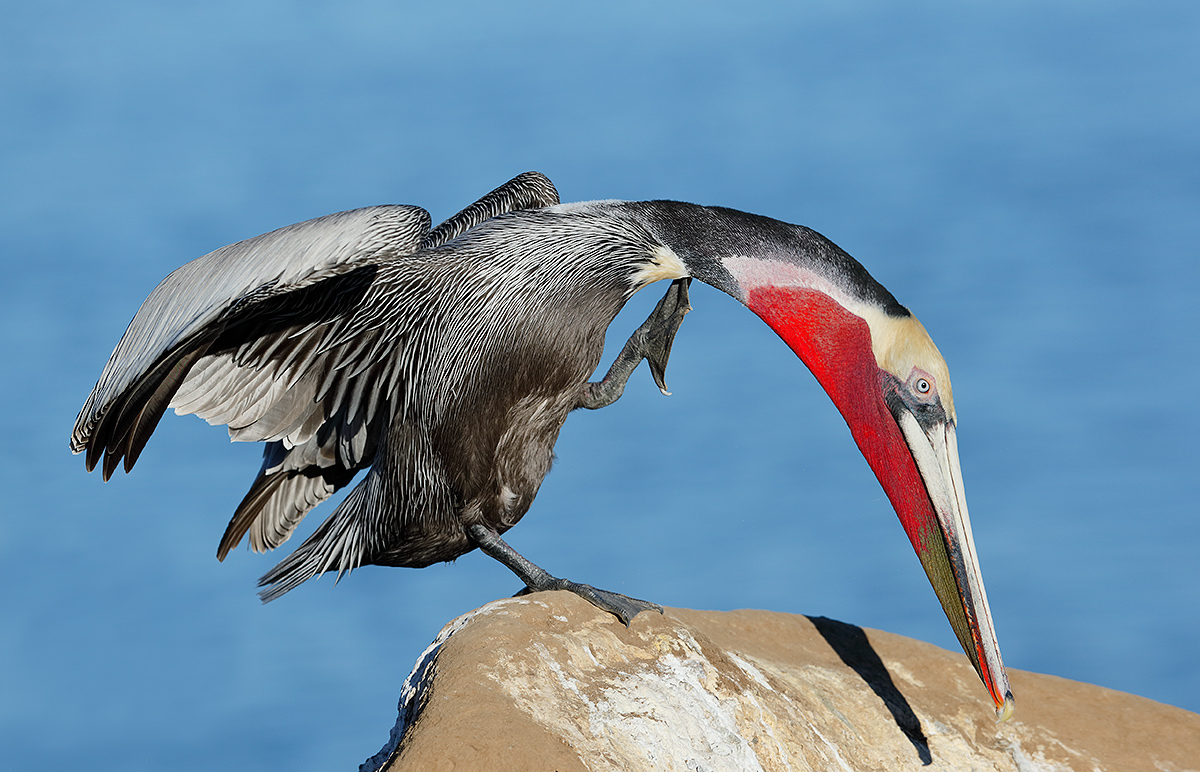
|
|
This image was created at 8:11am in full sun on last year’s Short Notice San Diego IPT with the hand held Canon EF 300mm f/2.8L IS II USM lens and the Canon EOS-1D X. ISO 400. Evaluative metering at zero: 1/4000 sec. at f/4.5 in Manual mode.
Central sensor/AI Servo/Surround Rear Focus AF as originally framed (see below) was active at the moment of exposure. Click here to see the latest version of the Rear Focus Tutorial. Click on the image to see a larger version. See image next for the original capture.
|
Mommy, Why are Their Bills So Red?
At the height of breeding plumage, the Pacific race of Brown Pelican sports bright fire-engine red bill pouches with the lower mandible often olive or yellowish green. In short, they are spectacularly beautiful. Creating simple portraits or interesting behavioral studies all with backgrounds of distant Pacific Ocean blue is one photographic opportunity that everyone with a long lens should enjoy once in their lives. I have been photographing San Diego’s pelicans for well more than two decades and can’t wait to get back. If you like to join me see the info on the 2015 San Diego IPT below.
Precious one, the pelican’s bill and pouch colors as well as the dark chocolate feathers on the back of their heads and necks are a result of hormonal changes that take place during the breeding season.
|

|
|
This JPEG represents the original image capture after the RAW conversion in DPP 4.0.
|
The Image Optimization
Image optimization was fairly straightforward. I converted the image in DPP 4.0 and fine-tuned the bill color with both color temperature and image color adjustments. The latter is new to DPP 4.0 and is pretty much identical to the HSL (Hue, Saturation, Luminance) tab in Photoshop. Once in CS-6 I toned down the REDs that I had juiced up during the conversion a bit by adding 30 points of CYAN to the REDs via a Selective Color adjustment. A crop from above and left eliminated most of the out-of-focus pelican in the background and the Clone Stamp Tool did the job on the sliver that remained. Next came some Digital Eye Doctor work and the application of a Contrast Mask (Unsharp Mask at 15, 65. 0) on the face only. Then I boosted the saturation and darkened the golden yellow feathers of the top of the head slightly. All selections were made with the Quick Selection Tool. Next I used the Clone Stamp and Patch Tools along with the Spot Healing Brush to clean up some of the whitewash on the rock.
Things were looking good but I realized that I needed a bit more room in front of the bird. To lay the groundwork for doing that I first expanded the canvas in front of the bird with the Crop Tool love handle. Then I selected the area in front of the bill with the seldom-used Rectangular Marquee Tool, put that on its own layer, hit Control T for the Transform Tool, and stretched the selection judiciously. Very judiciously. The last thing that you want to do is ruin the image quality by stretching too few pixels over too large an area. I finished by warping the rock so that it looked more natural.
Image Optimization Question
Would you have cleaned all the whitewash on the rock near the tip of the bill? Why or why not?
Image Creation Questions
#1: Why didn’t I simply point my lens to the right to eliminate the out-of-focus pelican behind the subject and have more room in front of the bird?
#2: Had I been able to get lower, how would that have helped the image?
The DPP RAW Conversion Guide
To learn why I use Canon’s Digital Photo Professional (DPP) to convert every image that I work on, click here. Coming soon: The DPP 4.0 RAW Conversion Guide by Arash Hazeghi and Arthur Morris. The more that I use DPP 4.0 for my RAW conversions the more I am impressed with it. I will be putting in several more hours of work today editing and adding to our new eGuide. Note: at present, DPP 4.0 will work only with 1D X and 5D III images.
Digital Basics
Everything that I did to optimize today’s image is detailed in my Digital Basics File–written in my easy-to-follow, easy-to-understand style. Are you tired of making your images look worse in Photoshop? Digital Basics File is an instructional PDF that is sent via e-mail. It includes my complete digital workflow, dozens of great Photoshop tips, details on using all of my killer image clean-up tools, the use of Contrast Masks, several different ways of expanding and filling in canvas, all of my time-saving Keyboard Shortcuts, Quick Masking, Layer Masking, and NIK Color Efex Pro basics, Digital Eye Doctor, Tim Grey Dodge and Burn, how to create time-saving actions, and tons more.
APTATS I & II
Learn the details of advanced Quick Masking techniques in APTATS I. Learn Advanced Layer Masking Techniques in APTATS I. Mention this blog post and apply a $5 discount to either with phone orders only. Buy both APTATS I and APTATS II and we will be glad to apply at $15 discount with phone orders only. Please call Jim or Jennifer at 863-692-0906 weekdays to order.
|

|
|
San Diego offers a wealth of very attractive natural history subjects. With annual visits spanning more than three decades I have lot of experience there….
|
2015 San Diego 4 1/2-DAY BIRDS AS ART Instructional Photo-Tour (IPT): FEB 1 thru the morning of FEB 5, 2015: $1799 (Limit: 8/Openings: 5)
Meet and Greet after dinner on your own at 7:00pm on JAN 31
Join me in San Diego to photograph the spectacular breeding plumage Brown Pelicans with their fire-engine red bill pouches; Brandt’s and Double-crested Cormorants in breeding plumage with their amazing crests; breeding plumage Wood and Ring-necked Duck; other species possible inluding Lesser Scaup, Redhead, and Surf Scoter; a variety of gulls including Western, California, and the gorgeous Heerman’s, all in full breeding plumage; shorebirds including Marbled Godwit, Willet, Sanderling and Black-bellied Plover; many others possible including Least, Western, and Spotted Sandpiper, Whimbrel, Black and Ruddy Turnstone, Semiplamated Plover, and Surfbird; Harbor Seals (depending on the current regulations) and California Sea Lions likely; and Bird of Paradise flowers. And as you can see by studying the two IPT cards there are some nice landscape opportunities as well.
Did I mention that there are wealth of great birds and natural history subjects in San Diego in winter?
This IPT will include five 3 1/2 hour morning photo sessions, four 2 1/2 hour afternoon photo sessions, five lunches, after-lunch image review and Photoshop sessions, and two fine dinners. To ensure early starts, breakfasts will be your responsibility.
A $499 non-refundable deposit is required to hold your slot for this IPT. You can send a check (made out to “Arthur Morris) to use at BIRDS AS ART, PO Box 7245, Indian Lake Estates, FL, 33855. Or call Jim or Jennifer at the office with a credit card at 863-692-0906. Your balance, payable only by check, will be due on 12/1//2014. If the trip fills, we will be glad to apply a credit applicable to a future IPT for the full amount less a $100 processing fee. If we do not receive your check for the balance on or before the due date we will try to fill your spot from the waiting list. If your spot is filled, you will lose your deposit. If not, you can secure your spot by paying your balance. Please print, complete, and sign the form that is linked to here and shoot it to us along with your deposit check. If you register by phone, please print, complete and sign the form as noted above and either mail it to us or e-mail the scan. If you have any questions, please feel free to contact me via e-mail.
|

|
|
Though the pelicans will be the stars of the show on this IPT there will be many other handsome and captivating subjects in wonderful settings.
|
San Diego Natural History Museum Program & The Birds of the World Exhibit
On Saturday morning, February 7, 2015 I will be presenting “A Bird Photographer’s Story” at the San Diego Natural History Museum to kick off the Birds of the World photographic exhibit that will feature the images of about a dozen of the world’s top avian photographers. This program,which is being generously sponsored by the Canon Explorers of Light program, will be free and open to the public. I am proud to say that both Denise Ippolito and I will have images hanging in the show. The exhibit opening is scheduled for later that same day, February 7, 2015. (Times TBA).
Folks on the IPT who wish to stay over and attend the program and the exhibit opening on Saturday are invited to join me for a photo session on Friday morning as follows:
Friday Morning Add-on Photo Session: February 6, 2015: $299.
This workshop includes 3 hours of in-the-field pelican photography instruction and brunch with image review and Photoshop instruction. For now, this session is open only to folks attending the IPT.
Facebook
Be sure to like and follow BAA on Facebook by clicking on the logo link upper right. Tanks a stack!
Support the BAA Blog. Support the BAA Bulletins: Shop B&H here!
We want and need to keep providing you with the latest free information, photography and Photoshop lessons, and all manner of related information. Show your appreciation by making your purchases immediately after clicking on any of our B&H or Amazon Affiliate links in this blog post. Remember, B&H ain’t just photography!
…..
Amazon.com
Those who prefer to support BAA by shopping with Amazon may use this link:
Amazon Canada
Many kind folks from north of the border, ay, have e-mailed stating that they would love to help us out by using one of our affiliate links but that living in Canada and doing so presents numerous problems. Now, they can help us out by using our Amazon Canada affiliate link by starting their searches by clicking here. Many thanks to those who have written.
Typos
In all blog posts and Bulletins, feel free to e-mail or to leave a comment regarding any typos, wrong words, misspellings, omissions, or grammatical errors. Just be right. 🙂
September 1st, 2014 The Streak Continues: 275
This blog was published just after 5:30am from my home in Indian Lake Estates, FL after another great night’s sleep. I will be here for the better part of the next ten weeks with no plane flights on the horizon until I fly to ABQ for a long stretch at Bosque. Then home for four days before heading to the Southern Ocean for a month on another great Cheeseman’s Expedition. Click here for info on this great trip and learn about joining the BAA group. This post, which took me more than 2 1/2 hours to prepare, makes 275 in a row.
As always, I would appreciate your using the BIRDS AS ART B&H affiliate links for all of your major gear, video, and electronic purchases, using our Amazon logo-link for all of your household purchases, and visiting the BAA Online Store for your tripod, tripod head, LensCoat, miscellaneous, accessories, and eGuide purchases as well.
This Just In!
There are huge B&H discounts on most Canon lenses including and especially the super-telephotos. Click here to see the discounts and the amazingly low prices.
Here are some examples:
Canon EF 500mm f/4L IS II USM lens: $1000 off.
Canon EF 600mm f/4L IS II USM lens: $1000 off.
Canon EF 300mm f/2.8L IS II USM lens: $700 off.
Canon EF 800mm f/5.6L IS USM Lens: $500 off.
Canon Extender EF 1.4X III: $50 off.
Canon Extender EF 2X III: $50 off.
Festival of the Cranes Early Morning Photography In-the-Field Workshops Notice!
If you wish to guarantee a spot on one or more of the Festival of the Cranes Early Morning Photography In-the-Field Workshops it is imperative that you read the registration information below very carefully. Registration begins tomorrow for Friends of Bosque members only. See below for info on joining and registering early. We expect that all four sessions will fill quickly. Folks attending the Sunday session should consider the 2-DAY Creative Workshop as well as Denise and I still have a very few openings on that IPT.
Your Help Is Needed
Sales for the August, 2014 via our BIRDS AS ART B&H affiliate links have been microscopically abysmal at best. If you need to purchase some new camera gear, please remember to use either our B&H logo link below or one of the product-specific links in the blog or the Bulletins. All should feel free to write me via e-mail for gear advice.
|
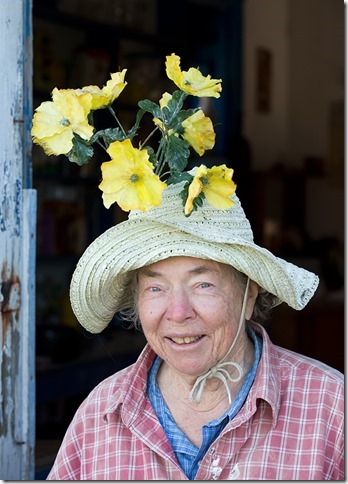
|
|
Helen Hays standing in one of the three GGI HQ doorways. The flowered straw hats (and other types of unique headgear) are designed to prevent scalp lacerations caused by terns defending their nest sites, eggs, and/or offspring.
|
Important “CBS This Morning” News Flash for Tuesday, September 2, 2014
Helen Hayes/Great Island Feature to Air
While I was on Great Gull Island this past July photographing Common and Roseate Terns as well B-roll GGI, a crew from CBS news showed up as scheduled to do a feature on Helen Hayes, now in her 47th year of studying the terns of GGI. The crew was made up of on-air talent/host Michelle Miller, producer Alberto Moya, videographer Paul Lederman, and talent acquisitions specialist (aka “talent scout”) Ginny de Liagre, nice folks all.
The feature on Helen will air nationally on “CBS This Morning” between 8:00 and 9:00am on Tuesday, September 2, 2014. Be sure to tune in or catch it on Tivo or whatever device you use to record TV shows. Helen’s dedication to the terns of GGI is unparalleled. My older daughter Jennifer worked on Great Gull for five summers and met her husband Erik there. As far as I know, the plan is to use six of my tern images in the feature.
Note: “CBS This Morning” airs from 7:00 to 9:00am. My understanding is that the GGI segment will air during the 2nd hour….
|

|
|
Clockwise from front left: with his back to the camera, tern researcher Ian Putnam, CBS talent scout Ginny de Liagre, producer Alberto Moya, videographer Paul Lederman, Helen Hays, feature host Michelle Miller, and Kendra Snyder, a public relations liaison from the American Museum of Natural History. AMNH owns Great Gull Island and the work there is done under the auspices of the museum. My interest in natural history was kindled on the many weekends that I spent walking the galleries of the museum as a young teen of about 13. My folks let me take the subway into the city. I’d start with what was then the Brighton Beach Express (now the Q train) and connect with what is now the C train….
|
The GGI Kitchen/Dining Room
The kitchen/dining room is one of four (relatively small) rooms in the Great Gull Island headquarters building. On my last visit, I learned that the floor is the original floor, circa the early 1900s as part of Fort Michie. Fort Michie was built in 1896 as part of the Harbor Defense of Long Island Sound.
Image Question
Why should I have created an HDR series for the image above?
|
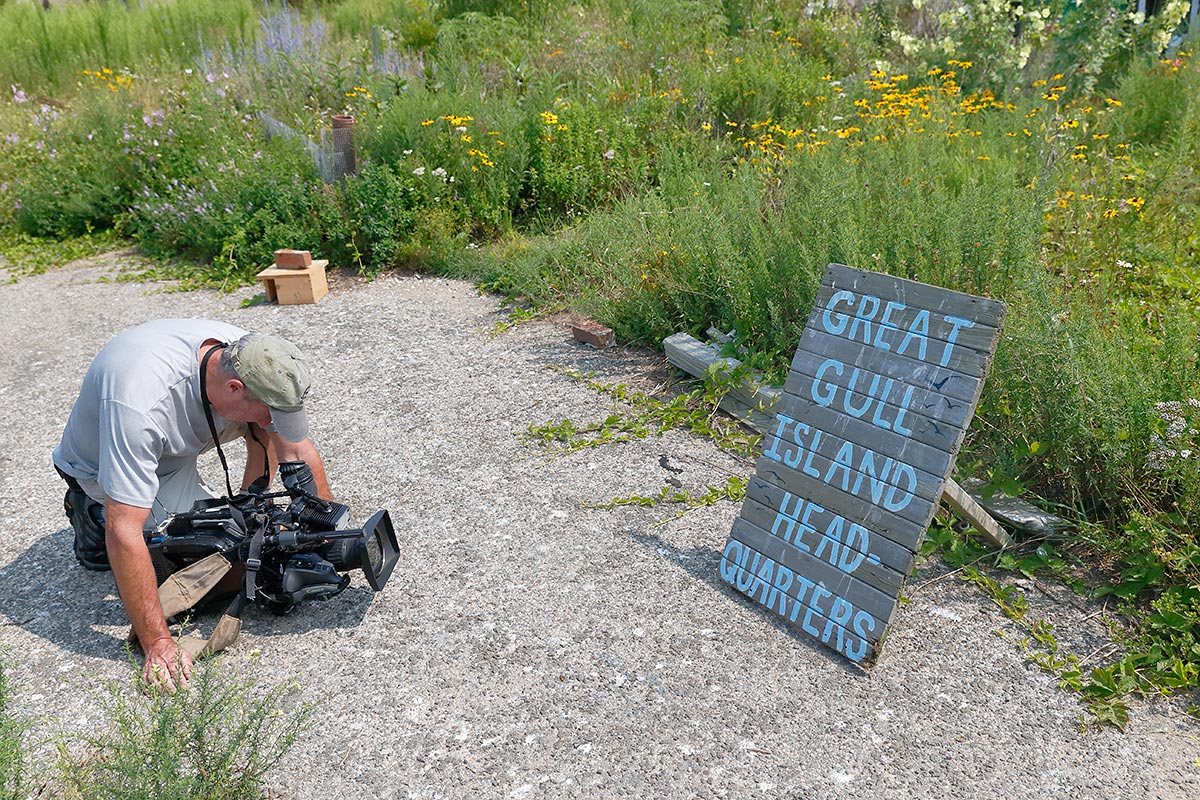
|
|
CBS videographer Paul Lederman filming the GGI HQ sign for B-roll.
|
My Right Shoulder
Whenever I see someone working with a huge video camera I quit feeling sorry for myself….
Thirty-one years of carrying a big lens on a tripod has taken a toll on my right shoulder. As regular readers know, I have been trying a variety of alternative methods of healing and pain relief. About six weeks ago I had stem cell/PRP/Prolozone injections in my right shoulder. While I do not quite have the hoped-for new shoulder yet, I have enjoyed great improvement. Before the treatment I had very limited range of motion and frequent sharp pain, and worst of all, when I swam, my shoulder always got worse. The more I swam, the worse the pain. Right now I have very close to complete range of motion with only a bit of tightness–and no pain. I have been easy-swimming between a half mile and a mile each day; when I get out of the pool, my shoulder feels better than when I got in the pool. No twinges while swimming and no pain afterwards. I am hoping to get another treatment on the right shoulder as well as one for my bone on bone left knee in the next week or two.
A while back, someone–a woman–I believe, wrote me asking about the stem cell/PRP treatment after I mentioned it on the blog. Though I spent a good deal of time searching for that e-mail, I have been unable to find it. If that was you, please get in touch again via e-mail.
|
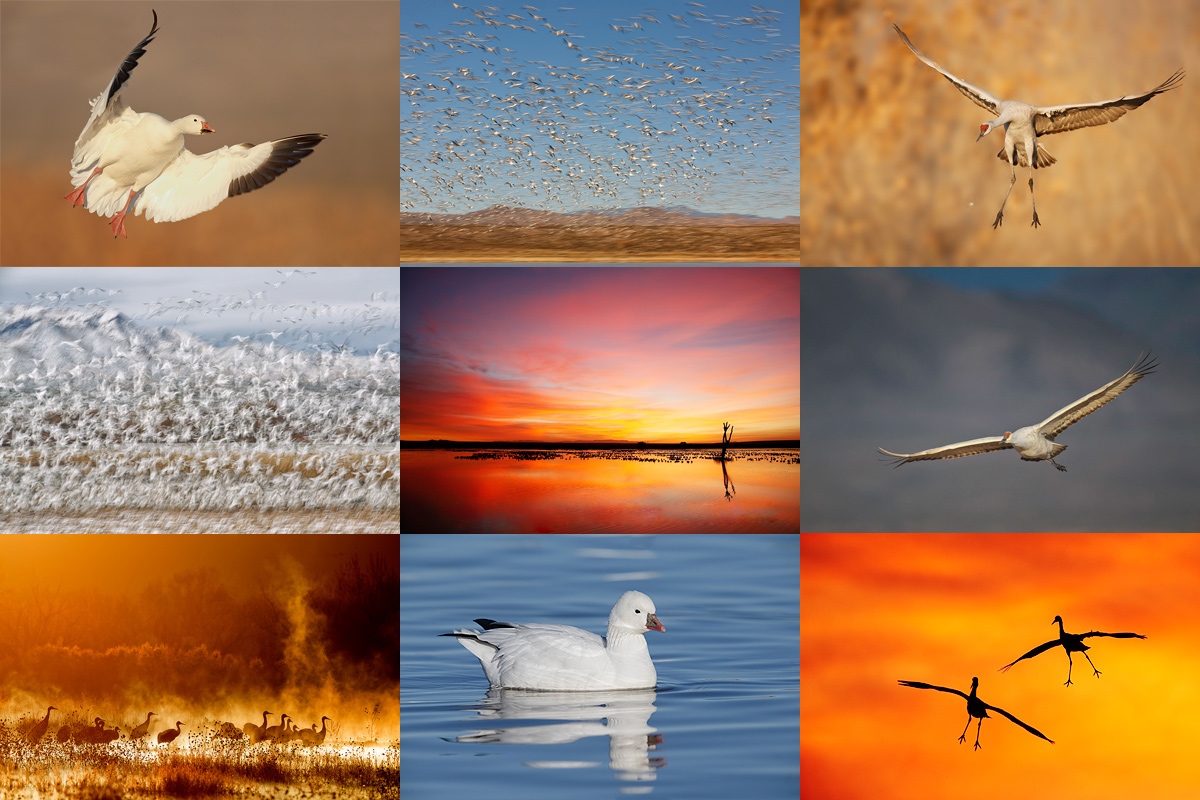
|
|
Get your butt on a plane and take advantage of some downright cheap instruction! Please click on the card to enjoy a larger version.
|
Festival of the Cranes Early Morning Photography In-the-Field Workshops
Festival of the Cranes Early Morning In-the-Field Photography Workshops: 5:50-10:30am. Limit 16. NOV 20/21/22 & 23: $125/session. Please see the important registration information below.
Join fulltime professional photographers Arthur Morris/BIRDS AS ART and Denise Ippolito/A Creative Adventure for four 1/2 hours of fun and learning at the refuge. You will learn how to create pleasingly blurred images in the low predawn light, to spot the good situations, to understand the effects of wind speed and direction on bird (especially in flight) photography, to photograph individual cranes in flight, to see and understand the light, to get the right exposure every time after making a single test exposure, and to design pleasing images. In addition you will learn and live Artie’s early morning Bosque del Apache strategies, strategies based on over two decades of experience at the refuge. This is a caravan event and a refuge pass will be provided. Dress with layers for warmth and bring snacks and plenty of water. Workshop leaves sharply at 6:00 AM. This workshop is being offered on Thursday, Friday, Saturday, and Sunday.
Combining one or more all of the Early Morning Photography In-the-Field Workshops immediately above with the Bosque del Apache 2014 A Creative Adventure/BIRDS AS ART “Creative Photography Instructional Photo-Tour” (IPT) immediately below and/or the Bosque del Apache Photography Two-Part Seminar (scroll down for details) is a fabulous and economical way to maximize your educational and photographic opportunities on a 2014 Bosque visit. Why not take advantage of these great relatively inexpensive events and learn from two of the world’s most talented, most creative, most caring, and most respected photographic educators, educators with a combined 26 years of Bosque experience?
Please note: the 4-DAY Bosque del Apache 2014 BIRDS AS ART/A Creative Adventure IPT (NOV 29–afternoon photo session through DEC 3–morning session is sold out with a waiting list as is the BIRDS AS ART Bosque del Apache/Canon EOS Destination Workshop (DEC 5-7, 2014).
|
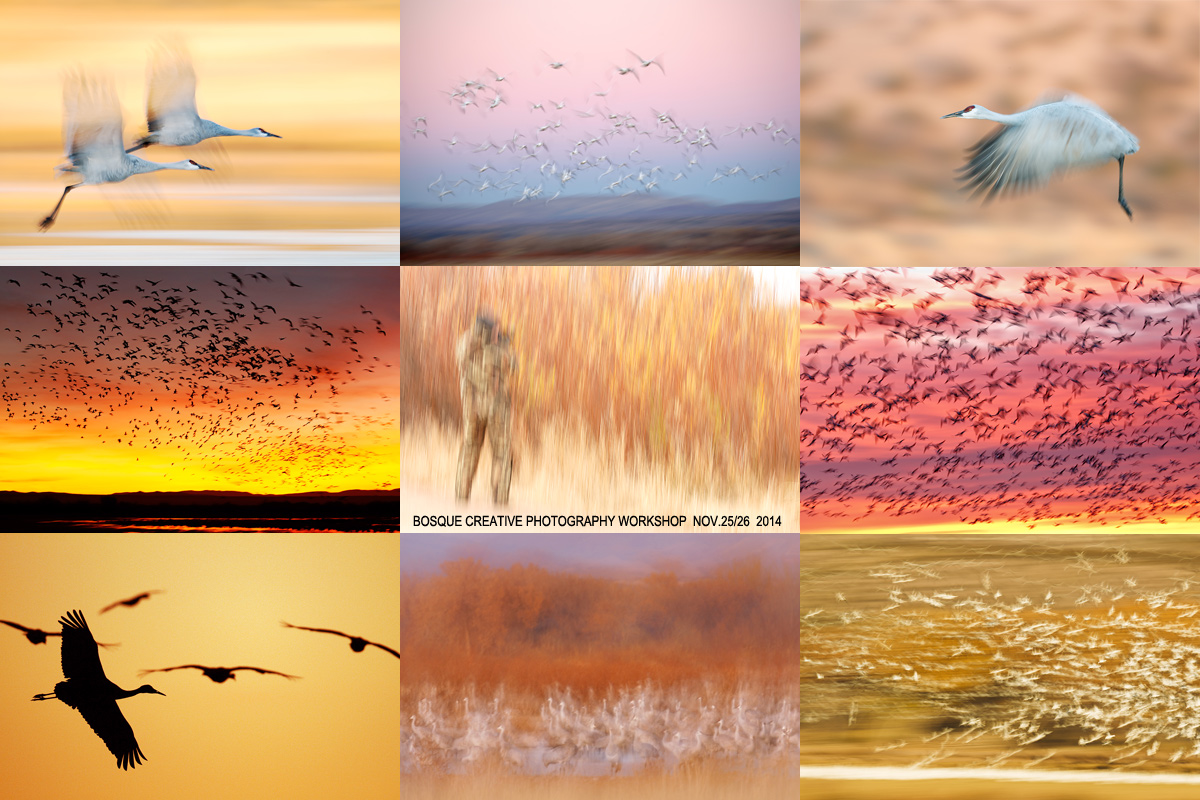
|
|
Join Denise Ippolito and Arthur Morris for two great days of photography, fun, and learning at one of our favorite soul places. We will surely be taking you out of the box on this workshop. Please click on the card to enjoy a larger version.
|
Bosque del Apache 2014 A Creative Adventure/BIRDS AS ART “Creative Photography Instructional Photo-Tour.” (IPT). NOV 24-25, 2014. 2-FULL DAYS: $729. Leaders: Denise Ippolito & Arthur Morris. Introductory Slide program: 7:00pm on Sunday 11/23.
Get Out of Your Box!
The Creative Bosque IPT is perfect for folks who want to learn to think outside the box, to create new and different images. This workshop is the perfect add-on for folks who are planning on attending the Festival of the Cranes. Learn to unleash your creative juices at the wondrous Bosque del Apache National Wildlife Refuge in San Antonio, New Mexico with two great leaders including the amazingly talented and creative Denise Ippolito. In-the-field instruction will include tips on gear set-up, on creating a variety of pleasing blurs, on getting the right exposure, and on designing pleasing images. And lots more. From vertical pan blurs to subject motion blurs to zoom blurs to multiple exposures we will cover it all. If conditions are perfect, we will not hesitate to take advantage of them to do some traditional bird photography. This workshop will include an inspirational introductory slide program on Sunday evening, 11/23, after dinner on your own, two morning and two afternoon photography sessions, all lunches, a digital workflow and Photoshop session after lunch on Monday, and an image critiquing session after lunch on Tuesday.
A $329 non-refundable deposit is required to hold your slot for this IPT. Your balance, payable only by check, will be due on 7/25/2014. If the trip fills, we will be glad to apply a credit applicable to a future IPT for the full amount less a $100 processing fee. If we do not receive your check for the balance on or before the due date we will try to fill your spot from the waiting list. If your spot is filled, you will lose your deposit. If not, you can secure your spot by paying your balance.
Please print, complete, and sign the form that is linked to here and shoot it to us along with your deposit check (made out to “Arthur Morris.”) You can also leave your deposit with a credit card by calling the office at 863-692-0906. If you register by phone, please print, complete and sign the form as noted above and either mail it to us or e-mail the scan. If you have any questions, please feel free to contact me via e-mail.
|
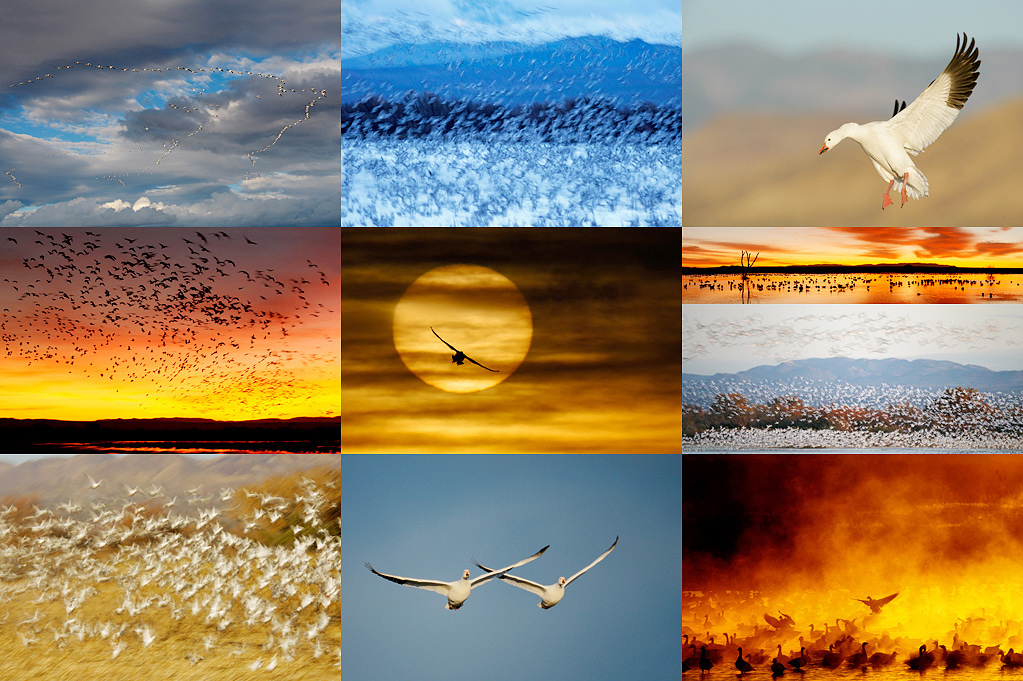
|
|
It’s been a 20+ year love affair….
|
“Love Affair with Bosque.” Sponsored by Canon. Friday, NOV 21, 2014; 1:00 to 2:40pm. Free, at the Bodega Restaurant, Socorro.
A slide program by Arthur Morris/BIRDS AS ART. Limit 200. Please see the important registration information below.
Arthur Morris first visited Bosque del Apache Refuge in December, 1992 while on sabbatical with his late-wife Elaine. While leading his first Bosque del Apache photographic workshop in December, 1994, quite soon after Elaine’s death, he created two iconic Bosque images. His “Blizzard in Blue” was honored in the prestigious 1998 BBC Wildlife Photographer of the Year Competition. “Fire in the Mist” was similarly honored in the 2001 BBC competition and soon thereafter was featured as wrap-around cover art on the coffee table book, Life on the Earth, a celebration of 30 years of the best images from the Wildlife Photographer of the Year Competitions. Those two images laid the foundation for his more than two decade love affair with the refuge. He has returned every year since then at the Thanksgiving season while leading BIRDS AS ART Instructional Photo-Tours. In addition, he has two February visits along with two September visits, the latter visits in conjunction with the Bosque del Apache Open Windows Volunteer Program that he founded. Join us for Artie’s photographic celebration of his “Love Affair with Bosque.”
Finally, the Important Registration Information 🙂
Warning: if you do not read this information carefully you will likely screw up and experience some degree of disappointment. Forewarned is forearmed (praemonitus, praemunitus in Latin).
The best way to register for one or more of the Festival of the Cranes Early Morning Photography In-the-Field Workshops, the Bosque del Apache Photography Two-Part Seminar, and/or the free “Love Affair with Bosque” program is to use the registration button at http://www.festivalofthecranes.com.
Here’s the rub: Online early registration for Friends of the Bosque members only will begin on Tuesday September 2, 2014 at 9:00 AM (MDT). Non-member online registration will begin a day later on Wednesday September 3, 2014 at 9:00 AM (MDT). E-mail confirmation of your registration, your receipt and your schedule will be sent automatically when you register online. Your schedule will be your ticket.
What to do?
If you wish to be assured of registering for the events that you wish to attend I recommend strongly that you click here right now and become a member of The Friends of the Bosque. Friends of the Bosque is a non-profit group that was organized in 1993 to support the Bosque del Apache National Wildlife Refuge and to promote appreciation and conservation of wildlife and habitat through environmental education and natural history experiences. I have been a member for many years. Joining the Friends group now will ensure that you can take advantage of the priority registration process that is reserved that is for their valued members on September 2 at 9:00am Mountain Daylight Time. Learn more about Friends of the Bosque here.
After you join, set your alarm to ring at 8:55am Mountain Daylight Time on September 2, 2014. As you might surmise, we expect that all three festival events will sell out quickly.
Facebook
Be sure to like and follow BAA on Facebook by clicking on the logo link upper right. Tanks a stack!
Support the BAA Blog. Support the BAA Bulletins: Shop B&H here!
We want and need to keep providing you with the latest free information, photography and Photoshop lessons, and all manner of related information. Show your appreciation by making your purchases immediately after clicking on any of our B&H or Amazon Affiliate links in this blog post. Remember, B&H ain’t just photography!
…..
Amazon.com
Those who prefer to support BAA by shopping with Amazon may use this link:
Amazon Canada
Many kind folks from north of the border, ay, have e-mailed stating that they would love to help us out by using one of our affiliate links but that living in Canada and doing so presents numerous problems. Now, they can help us out by using our Amazon Canada affiliate link by starting their searches by clicking here. Many thanks to those who have written.
Typos
In all blog posts and Bulletins, feel free to e-mail or to leave a comment regarding any typos, wrong words, misspellings, omissions, or grammatical errors. Just be right. 🙂
August 31st, 2014 The Streak Continues: 274
This blog was published just after 8:00am from my home in Indian Lake Estates, FL after a great night’s sleep. I will be here for the better part of the next ten weeks with no plane flights on the horizon until I fly to ABQ for a long stretch at Bosque. Then home for four days before heading to the Southern Ocean for a month on another great Cheeseman’s Expedition. Click here for info on this great trip and learn about joining the BAA group. This post, which took me more than 2 1/2 hours to prepare, makes 274 in a row.
As always, I would appreciate your using the BIRDS AS ART B&H affiliate links for all of your major gear, video, and electronic purchases, using our Amazon logo-link for all of your household purchases, and visiting the BAA Online Store for your tripod, tripod head, LensCoat, miscellaneous, accessories, and eGuide purchases as well.
Your Help Is Needed
Sales for the August, 2014 via our BIRDS AS ART B&H affiliate links have been microscopically abysmal at best. If you need to purchase some new camera gear, please remember to use either our B&H logo link below or one of the product-specific links in the blog or the Bulletins. All should feel free to write me via e-mail for gear advice.
|
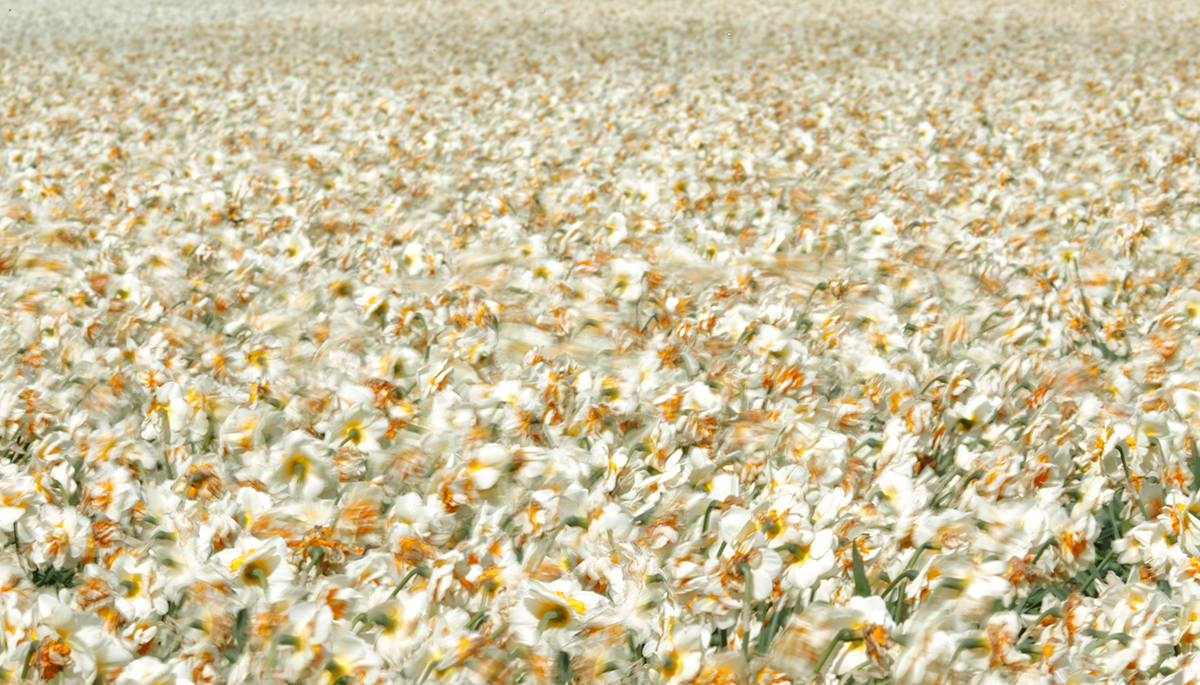
|
|
This image was created on a mostly sunny morning on last spring’s Tulips and a Touch of Holland IPT near the famed Keukenhof Gardens, Lisse, Holland (The Netherlands) with the Gitzo GT1542T Tripod, the Mongoose M3.6 head, the Canon EF 300mm f/2.8L IS II USM lens, the Canon Extender EF 1.4X III, and the Canon EOS 5D Mark III. ISO 50. Evaluative metering +1 1/3 stops as framed: 1/8 sec. at f/45 in Tv Mode. Color temperature: 5000K.
Central sensor/AI Servo/Surround Rear Focus AF 1/3 of the way into the frame before the pano crop and re-compose. Click here to see the latest version of the Rear Focus Tutorial. Click on the image to see a larger version.
Image #1: Daffodil Field Wind Blur
|
What to Do When the Wind Blows Hard?
When it is really blowing hard make soup from a stone by thinking slow shutter speeds and wind blurs. With daffodils being far less substantial structurally than tulips they were an obvious choice for blowin’ in the wind images. In addition to the wind blur I added a bit of Denise Ippolito’s shiver technique to create the image above.
On Learning to Be More Creative
If you missed the guest blog post by Mike Gotthelf, be sure to click here.
|
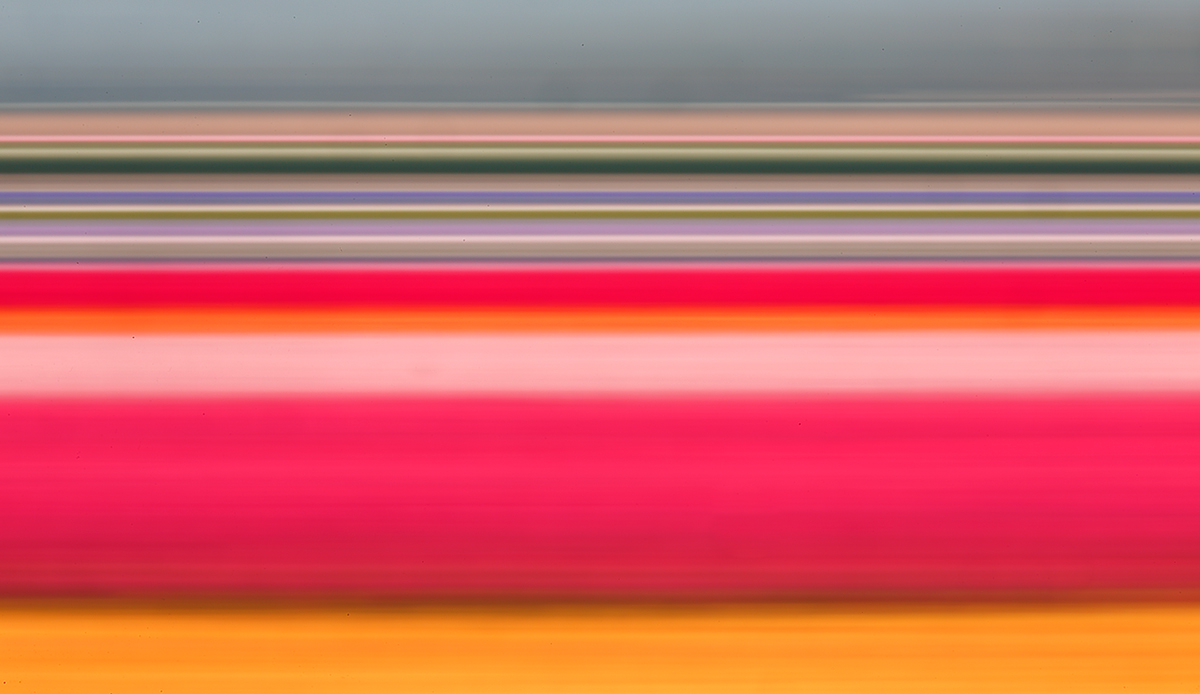
|
|
This image was created on the cloudy bright morning of April 20, 2014 on last spring’s Tulips and a Touch of Holland IPT in tulip fields near the famed Keukenhof Gardens, Lisse, Holland (The Netherlands) with the Gitzo GT1542T Tripod, the Mongoose M3.6 head, the Canon EF 300mm f/2.8L IS II USM lens, the Canon Extender EF 2X III, and the Canon EOS 5D Mark III. ISO 50. Evaluative metering +1 stop as framed: .6 sec. at f/64 in Tv Mode. Color temperature: AWB.
Central sensor/AI Servo/Surround Rear Focus AF 1/3 of the way into the frame before the small crop from the top, re-compose left, and then panned horizontally. Click here to see the latest version of the Rear Focus Tutorial. Click on the image to see a larger version.
Image #2: Tulip Field Horizontal Pan Blur
|
Eye Candy
With access to so many multi-colored tulip fields each featuring row upon row of tulips in full bloom in an astounding variety of bright colors, creative folks immediately think of creating horizontal pan blurs with intermediate and long focal length lenses. Set your lowest ISO and a small aperture so that you come up with a slow shutter speed, check the exposure by via the RGB histogram, set the focus, and then pan the lens horizontally. Make lots of images while varying both your panning speeds and your framing.
|
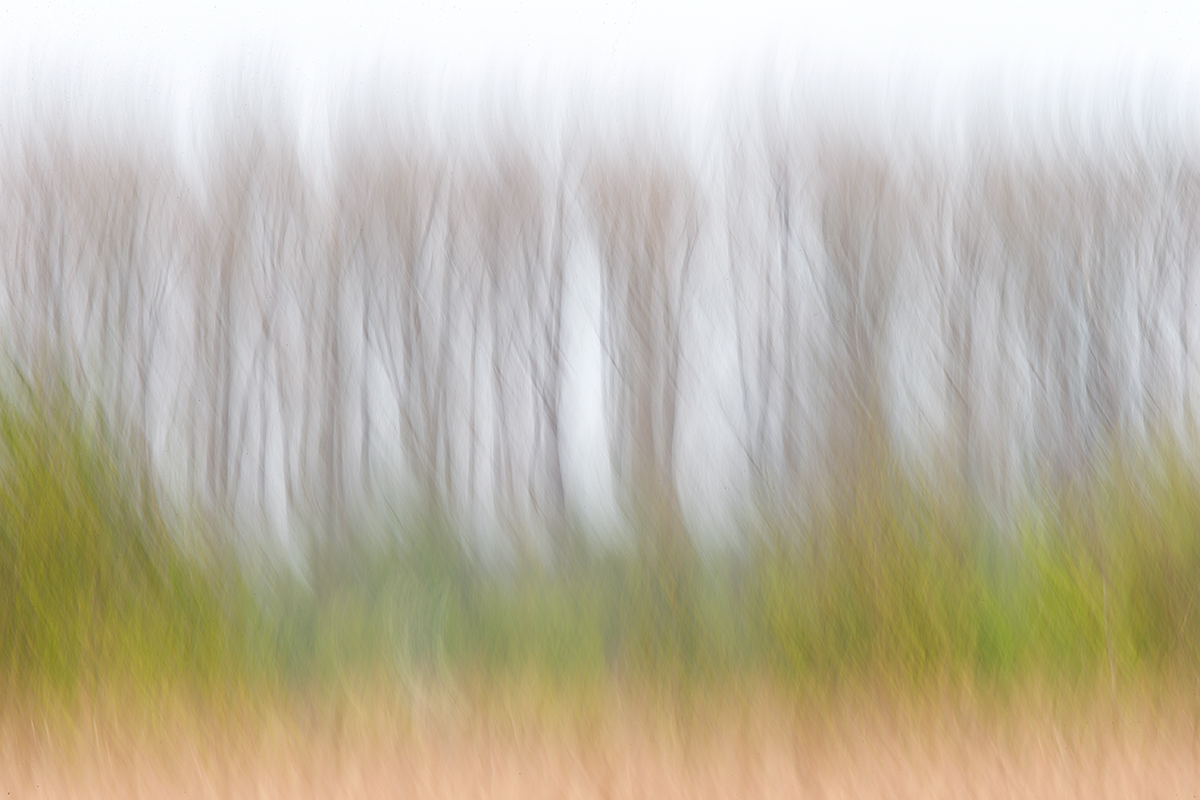
|
|
This image was created a cloudy afternoon on a failed scouting trip for Purple Heron before the start of last spring’s Tulips and a Touch of Holland IPT with the Gitzo GT1542T Tripod, the Mongoose M3.6 head, the Canon EF 300mm f/2.8L IS II USM lens, the Canon Extender EF 2X III, and the Canon EOS 5D Mark III. ISO 50. Evaluative metering +1 stop as framed: .6 sec. at f/64 in Tv Mode. Color temperature: AWB.
Central sensor/AI Servo/Surround Rear Focus AF on the base of the trees, recomposed up, and then panned down vertically. Click here to see the latest version of the Rear Focus Tutorial. Click on the image to see a larger version.
Image #3: Marsh and Distant Trees/Vertical Pan Blur
|
The Trick to Creating Successful Vertical Pan Blurs
In most instances, creating successful vertical pan blurs is a lot more difficult and requires a lot more practice than creating horizontal pan blurs. Why the difference? With vertical pan blurs the panning rate and the timing of the shutter release have a much greater influence on the framing of the vertical elements in the image. You are looking for a clean strip above the vertical elements and a clean strip below. Horizontal pan blurs are usually pure pattern blurs; the panning rate determines only the degree of blurring and usually has nothing to do with the framing and image design. Likewise when you are dealing with pure patterns the shutter release has little to do with the framing and image design.
For a spectacular example of a vertical pan blur with a clean lower edge, click here.
|
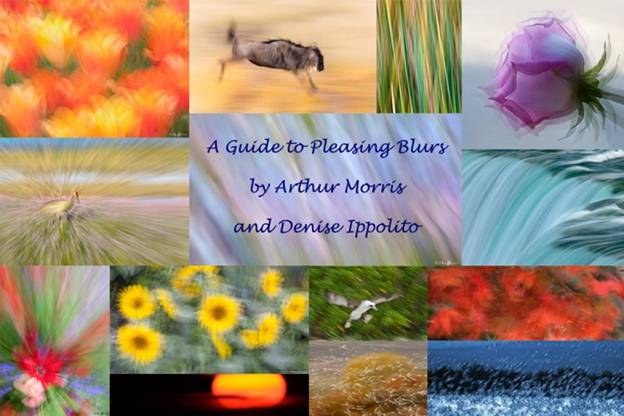
|
|
Learn the secrets of creating contest winning images in our “A Gulide to Pleasing Blurs.”
|
A Guide to Pleasing Blurs
Pleasing Blurs are not accidents. Learn pretty much everything that there is about creating them in our A Guide to Pleasing Blurs by Denise Ippolito and yours truly.
The Art of Flower Photography
Click here if you missed the recent eBook announcement.
Ken Kovak: I have been working my way through the “Art of Flower Photography” and it is both a feast for the eyes and quite informative.
Art Buesing: Artie and Denise have outdone themselves with “The Art of Flower Photography.” Gorgeous photos with careful explanations of the production techniques for camera and computer. A valuable addition to my photography library!
|

|
|
Denise and artie hope that you can join them next spring in Holland and learn to improve both the technical and creative aspects of your flower (and street) photography.
|
7 1/2-Day/8-Night: A Creative Adventure/BIRDS AS ART/Tulips & A Touch of Holland Instructional Photo-Tour (IPT)
Keukenhof—Delft—Amsterdam–Flower Fields—Kinderdijk
April 9 -April 16, 2015: $4995. Limit: 12 photographers/Openings 10. Four more to make the trip a go.
This trip needs 6 registrants to run so please do not purchase your plane tickets until you hear from us that the trip is a go.
Join Denise Ippolito, the author of “Bloomin’ Ideas,” and Arthur Morris, Canon Explorer of Light Emeritus, for a great trip to Holland in mid-April 2015. Day 1 of the IPT will be April 9, 2015. We will have a short afternoon get-together and then our first photographic session at the justly-famed Keukenhof. Our last day, Day 8, April 16 will be a full day of photography.
The primary subjects will be tulips and orchids at Keukenhof and the spectacularly amazing tulip, hyacinth, and daffodil bulb fields around Lisse and points north. We will spend one full day in Amsterdam. There will be optional visits to the Van Gogh Museum, the Anne Frank House and/or the Rijk’s Museum. Street photography and sightseeing will be other options. We will spend a half day at Kinderdijk where we will be photographing the windmills and doing some creative photography. We will spend an afternoon in the lovely Dutch town of Delft where we will do some street photography and shopping. There is an optional church tower tour/climb. We will also enjoy a superb fine dining experience in a traditional restaurant.
Other than the arrival date: April 9, Day 1, and the date of our last day of photography on April 16, Day 8, there is no set itinerary. We will check the weather and play everything by ear to maximize the photographic opportunities. We will try to do Amsterdam, Delft, and especially Kinderdijik, on cloudy days.
There are several huge pluses to this trip. First off, denise is an amazingly skilled and caring instructor. Both her creativity and her willingness to share and to help beginning and intermediate photographers are unmatched. And though artie has learned a ton about flower photography from denise, their styles and techniques do vary considerably. You will have a chance to be counseled by and to learn from both of them. While denise will hunt you down to help you, artie’s teaching style is more “the closer you stay to me, the more you will learn.” Both leaders consistently inspire the participants. And each other. The sky, of course, is the limit.
You will learn to create tight abstracts, how best to use depth-of-field (or the lack thereof) to improve your flower photography, how to get the right exposure and make sharp images every time, how to see the best shot, and how to choose the best perspective for a given situation. And you will of course learn to create a variety of pleasingly blurred flower images. If you bring a long lens, you will learn to use it effectively for flower photography. Denise’s two favorite flower lenses are the Canon EF 100mm f/2.8L Macro IS USM lens and the Canon EF 24-105mm f/4L IS USM lens. Mine are the Canon 100mm f/2.8L IS macro , the Canon EF 180mm f/3.5L Macro USM lens ,and the Canon EF 300mm f/2.8L IS II USM lens, all almost always on a tripod. Often with extension tubes and/or either the 1.4X or the 2X (with the 300 II) teleconverters. Denise hand holds a great deal of the time. For flower field blurs denise uses the same lenses mentioned above along with her new 70-200mm f/2.8L IS III lens. Artie’s favorite is that same 70-200 often with a 1.4X TC but he uses both the new Canon EF 24-70mm f/2.8L II USM lens and the 300 II as well. Both of us use and love the Canon EOS 5D Mark III for all of our flower photography. The in-camera HDR and Multiple Exposure features are a blast.
One of the great advantages of our trip is that we will be staying in a single, strategically located hotel that is quite excellent. Do note that all ground transfers to and from Schipol Airport will be via the free hotel shuttle bus.
What’s included: Eight hotel nights. All ground transportation except for airport transfers as noted above. In-the-field instruction and small group image review and Photoshop sessions. All meals from dinner on Day 1 through dinner on Day 8. There is good food at the hotel and we will be dining there on occasion; whenever you order off the menu be it at the hotel or at another restaurant only the cost of your main course is included. On these occasions the cost of soups, appetizers, salads, sodas and other beverages, alcoholic drinks and wine, bottled water, and desserts are not included. Snacks, personal items, phone calls, etc. are also not included. The cost of bus or train transportation to and from Amsterdam (about $20 US), museum entry, and tower and church entry fees (optional) are likewise not included.
Beware of seemingly longer, slightly less expensive tours that include travel days and days sitting in the hotel doing nothing as part of the tour. In addition, other similar trips have you changing hotels often and needlessly. One final note on other similar trips: the instructors on this trip actually instruct. On other similar trips the instructors, though usually imminently qualified, serve for the most part as van drivers and van door openers.
A non-refundable deposit of $1,000 per person is required to hold your spot. The second payment of $2,000 due by October 30, 2014. The balance is due on January 15, 2015. Payments in full are of course welcome at any time. All payments including the deposit must be by check made out to “Arthur Morris.” As life has a way of throwing an occasional curve ball our way, you are urged to purchase travel insurance within 15 days of our cashing your check. Artie uses and recommends Travel Insurance Services. All payments are non-refundable unless the trip fills to capacity. In that case, all payments but your deposit will be refunded. If the trip does not run every penny will of course be refunded. Again, please do not purchase your air tickets until you hear from us that the trip is a go. We are very confident that it will.
All checks should be made out to “Arthur Morris” and sent to: Arthur Morris, PO Box 7245, Indian Lake Estates, FL 33855. Call Jim or Jen in the BAA office with any additional registration questions: 863-692-0906.
For couples or friends signing up at the same time for the tulip trip, a $200/duo discount will be applied to the final payment.
When you send your deposit check, please print, sign, and include the paperwork here.
If you have any questions on the trip please contact artie by e-mail or denise by e-mail.
Facebook
Be sure to like and follow BAA on Facebook by clicking on the logo link upper right. Tanks a stack!
Support the BAA Blog. Support the BAA Bulletins: Shop B&H here!
We want and need to keep providing you with the latest free information, photography and Photoshop lessons, and all manner of related information. Show your appreciation by making your purchases immediately after clicking on any of our B&H or Amazon Affiliate links in this blog post. Remember, B&H ain’t just photography!
…..
Amazon.com
Those who prefer to support BAA by shopping with Amazon may use this link:
Amazon Canada
Many kind folks from north of the border, ay, have e-mailed stating that they would love to help us out by using one of our affiliate links but that living in Canada and doing so presents numerous problems. Now, they can help us out by using our Amazon Canada affiliate link by starting their searches by clicking here. Many thanks to those who have written.
Typos
In all blog posts and Bulletins, feel free to e-mail or to leave a comment regarding any typos, wrong words, misspellings, omissions, or grammatical errors. Just be right. 🙂
August 30th, 2014 The Streak Continues: 273
This blog was published just before 6:45am from my home in Indian Lake Estates, FL. I will be here for the better part of the next ten weeks with no plane flights on the horizon until I fly to ABQ for a long stretch at Bosque. Then home for four days before heading to the Southern Ocean for a month on another great Cheeseman’s Expedition. See here for more info on that trip. Photographically, my New York week was phenomenal. This post, which took me more than 2 3/4 hours to prepare, makes 273 in a row.
As always, I would appreciate your using the BIRDS AS ART B&H affiliate links for all of your major gear, video, and electronic purchases, using our Amazon logo-link for all of your household purchases, and visiting the BAA Online Store for your tripod, tripod head, LensCoat, miscellaneous, accessories, and eGuide purchases as well.
Your Help Is Needed
Sales for the August, 2014 via our BIRDS AS ART B&H affiliate links have been microscopically abysmal at best. If you need to purchase some new camera gear, please remember to use either our B&H logo link below or one of the product-specific links in the blog or the Bulletins. All should feel free to write me via e-mail for gear advice.
/Nickerson Beach/JBWR IPT
I will be announcing the dates and details for a Nickerson Beach/JBWR IPT in the next week or two. If you would like your name to be put on the Interested List so that you receive advance notice please shoot me an e-mail.
|

|
|
This image was created at Nickerson Beach at 6:33am on the clear morning of 25 August, 2014 with the Gitzo 3532 LS carbon fiber tripod, the Mongoose M3.6 head, the Canon EF 600mm f/4L IS II USM lens, the Canon Extender EF 2X III, and the Canon EOS-1D X. ISO 1600. Evaluative metering +1 2/3 stops as framed: 1/160 sec. at f/9 in Manual mode.
Central Sensor (by necessity)/AI Servo-Expand/Rear Focus AF on the base of the bird’s face and release. When you add the 2X TC to an f/4 lens with the 1DX or the 5D III hit the MFn button once to toggle to AF Expand and enjoy 4 extra AF sensors. Learn everything there is to know about the 1D X and 5D III AF systems including how to manage the various AF Area Selection Modes, when to use which one, and several ways to move the AF sensor around in the 1D X AF Guide and the 5D Mark III User’s Guide. Click here to see the latest version of the Rear Focus Tutorial. Click on the image to see a larger version.
Black Skimmer chick with twig at dawn
|
The Importance of Being Early III
Why part III? Had I not gotten up and on the road ridiculously early (it is 44 minutes from my Mom’s to the parking lot at Nickerson with zero traffic and it takes me 15 minutes to get my gear together) I would not have been in position to create the images in the blog posts of August 27th (You Will Need to Put Your Thinking Cap on for This One…) and August 28th (You Need a Clear Head at Sunrise on the Beach at Nickerson).
The single images in each of those posts and the two images presented in today’s post are quite special to me, each because of the color, the quality, and the direction of the light. On each of my five mornings at Nickerson I was the first one on the beach. Most days a photographer or two would showeup at about 9:00am; they always left me shaking my head. But even those folks who showed up at 7:00am–and there were many of them each day, had missed the very best hour of light and photography….
The coral light in the image above is lovely, delicious, and priceless. And it is never available to those who need their beauty rest.
The funny thing with me is that though I had the alarm set for 4:00am each morning I was up every day before the rooster crowed (yes, cock-a-doodle-doo is my alarm sound). I guess that I was dreaming about the gorgeous light that would be my reward and that my subconscious did not want to miss out on it.
Image Question
What other elements of composition–though quite small and seemingly insignificant to many, add to the success of this image?
AF Question
With the active and the eight surrounding sensors squarely on the chick’s face why did I take my thumb off the rear focus button before creating the image? Note: I did not re-compose….
The DPP RAW Conversion Guide
To learn why I use Canon’s Digital Photo Professional (DPP) to convert every image that I work on, click here. Coming soon: the DPP 4.0 RAW Conversion Guide by Arash Hazeghi with Arthur Morris. DPP 4.0 rocked the conversion of the image above. As DPP 4.0 is a completely new animal that requires a steep learning curve for those who want to take full advantage of its capabilities. Arash and I will be spending several hours on the phone working on the guide today.
Exposure Screw-up
I have no clue as to why I was in Av mode at zero…. IAC, the result was a close to two stop under-exposure. I dealt with that easily during the conversion in DPP 4.0 by moving the Brightness slider to 2.00. As I was creating a quasi-silhouette I did not have to worry about noise. Obviously I should have been at +2 stops exposure compensation.
Exposure Questions
1-Why would +2 stops as framed have been very close to +3 stops off the sky?
All photographers need to be familiar with the relationships that deal with ISO, shutter speed, aperture, and exposure compensation. In other words, you need to be able to do the math.
2-Assuming that I went to Manual mode what would the correct shutter speed have been at f/5.6?
Those who have trouble doing the math are referred to “Measuring Light in Stop”s section on page 54 of the original The Art of Bird Photography (160 pages in soft cover).
The Moral of the Story
If the forecast is for a clear morning, or, if like me, you never trust the weatherman, set the alarm early enough to get you out to the beach with all your gear about 45 minutes before the sun hits the horizon. Learn to see and utilize the special light that you will encounter. Look for potential backlit situations, especially those that might be spectacular during the first 15 minutes after sunrise. You might need to get wet to take advantage of richly colored sunrise reflections so be sure to dress appropriately. In short, if you snooze, you will lose.
If this blog post inspires you to become an early riser feel free to send me a JPEG of your best image via e-mailSelling Your Used Photo Gear Through BIRDS AS ART
Selling your used (or like-new) photo gear through the BAA Blog or via a BAA Online Bulletin is a great idea. We charge only a 5% commission. One of the more popular used gear for sale sites charges a minimum of 20% plus assorted fees! Yikes. The minimum item price here is $500 (or less for a $25 fee). If you are interested please e-mail with the words Items for Sale Info Request cut and pasted into the Subject line :). Stuff that is priced fairly–I offer free pricing advice, usually sells in no time flat. In the past few months, we have sold just about everything in sight.
I will do my very best to keep the listings below current.
Used Gear Caution
Though I am not in a position to post images of gear for sale here or elsewhere, prospective buyers are encouraged to request for photos of the gear that they are interested in purchasing via e-mail. Doing so will help to avoid any misunderstandings as to the condition of the gear.
Used Canon EOS-1D Mark IV
Walt Anderson is offering a used Canon EOS-1D Mark IV professional digital camera body in near-mint condition for $2899.00. The sale includes an extra battery the original box, and all cables and manuals. The seller will pay insured shipping via UPS Ground to US addresses only. Your new gear will be shipped after your check clears. Payment may also be made via credit card plus a 2% fee.
Please contact Walt via e-mail or by phone at 847-438-3587 (office) or 847-721-8319 (cell) (Central Daylight Time). Walt, a long time friend, is the inventor of the Better Beamer Flash Extender, the very first BAA mail order item. When it comes to taking care of his gear, Walt is fastidious.
The 1D IV is a 1.3 crop factor camera body that was my workhorse camera body for about 4 years not so long ago. I owned four of them in total. It is Denise Ippolito’s camera body of choice for birds and wildlife. They were selling used just a few months ago for more than $4,000 so Walt’s 1D IV is priced to sell quickly.
Used Canon EF 100-400 f 4.5-5.6 L IS Lens
Bruce Boswell is offering a used Canon EF 100-400 f 4.5-5.6 L IS lens in very good condition for $999 plus insured shipping via UPS Ground to US Continental addresses only. The tripod and zoom rings have a few minor blemishes. The sale includes: the original case, the front and rear caps, the lens hood, and the lens manual. Your gear will be shipped only after your check clears.
Please contact Bruce via e-mail or by phone at (309) 451-1506 or (309) 530-8493 (cell) (Central).
The 100-400 is a versatile intermediate telephoto zoom lens with 1,000+ uses. It makes a great starter lens especially for folks who do general nature and wildlife in addition to birds. I’ve sold 100s of images made with a 1-4 and denise loved hers for many years forsaking it only recently for the Canon EF 70-200mm f/2.8L IS II USM lens. Bruce’s 100-400 is priced to sell.
Used Canon 800mm f/56L IS USM Lens
Multiple IPT veteran and good friend Mike Gotthelf, is offering a used Canon EF 800mm f/5.6L IS USM lens in excellent + condition for $8850. The lens is like new except for some very minor wear on the finish. The sale includes the leather hood, the original hard case and key, a low foot, a LensCoat, and insured shipping via UPS Ground to US addresses only. Personal checks only; your new lens will be shipped only after your check clears.
This great lens, my favorite for 3 years, sells new at B&H for $13,999.00. B&H is asking $11,399.95 for a used one here in the same condition as Mike’s. They recently dropped their price for this lens from $11,999.90…. Buy Mike’s lens and save $2456.95 right now! It will save you a ton of dough and you will have a super-sharp lens with lots of reach. And it works great with a 1.4X TC too with all pro bodies and with the 5D Mark III.
Interested folks can contact Mike via e-mail or by phone at (978)-407-0679 (eastern time).
Used Canon 300mm f/4L IS USM Lens
Chris Callahan is offering a used Canon 300mm f/4L IS USM Lens in good to very good condition for $900. There is some wear on the finish. The sale includes the heavy duty fabric carrying case that is moderately worn, the tripod ring (tripod collar), and the rear cap. The seller will pay insured UPS shipping within continental US. The lens will ship after the check clears.
Please contact Chris via e-mail or by phone at 1-850-516-7155 (eastern time).
The Canon EF 300mm f/4L IS USM lens is still in production; it sells for $1449 new from B&H; buy Chris’s lens today and save $549! I have long recommended this lens as the best Canon bird photography starter lens, a clear choice over my old “toy lens,” the Canon EF 400mm f/5.6L. Why? It is faster at f/4. It has IS. And it autofocuses with a 7D (or other pro-sumer body) and a 1.4X teleconverter. The 300 f/4 L IS offers a minimum focusing distance of only 1.5 meters (less than 5 feet). This makes it a great lens for for frogs, butterflies, medium-sized and large flowers, and large insects like dragonflies. It is a great flight lens either alone or with the 1.4X TC. It is deadly sharp and great on a tripod with the Mongoose M3.6.
Used Canon EOS-1D Mark III
Michael Zajac is offering a Canon EOS-1D Mark III professional digital camera body in Excellent condition for $1250. The sale includes the battery charger, one battery, the original paperwork, the camera strap, the original box, and shipping to the continental US.
Please contact Michael via e-mail or by phone at 732-979 -6644. Photos are available upon request.
Some EOS-1D Mark III bodies originally had AF problems. Michael’s did not. I have seen his great flight images made with this camera. This body features a 1.3X crop factor sensor and is a great step-up for someone who wants to take a big step up from a 7D. It’s powerful battery drives AF much faster than the pro-sumer bodies especially with either a 1.4X or 2X teleconverter in place.
Facebook
Be sure to like and follow BAA on Facebook by clicking on the logo link upper right. Tanks a stack!
Support the BAA Blog. Support the BAA Bulletins: Shop B&H here!
We want and need to keep providing you with the latest free information, photography and Photoshop lessons, and all manner of related information. Show your appreciation by making your purchases immediately after clicking on any of our B&H or Amazon Affiliate links in this blog post. Remember, B&H ain’t just photography!
…..
Amazon.com
Those who prefer to support BAA by shopping with Amazon may use this link:
Amazon Canada
Many kind folks from north of the border, ay, have e-mailed stating that they would love to help us out by using one of our affiliate links but that living in Canada and doing so presents numerous problems. Now, they can help us out by using our Amazon Canada affiliate link by starting their searches by clicking here. Many thanks to those who have written.
Typos
In all blog posts and Bulletins, feel free to e-mail or to leave a comment regarding any typos, wrong words, misspellings, omissions, or grammatical errors. Just be right. 🙂
August 29th, 2014 The Streak Continues: 272
This blog was published at 6:30am from my home in Indian Lake Estates, FL. My flight yesterday from Islip to Orlando was uneventful. Right now it is looking like an unprecedented ten weeks with no plane flights on the horizon until I fly to ABQ for a long stretch at Bosque. Then home for four days before heading to the Southern Ocean for a month on another great Cheeseman’s Expedition. See yesterday’s blog post for more info on that trip. Photographically, my New York week was phenomenal. This post makes 272 in a row.
As always, I would appreciate your using the BIRDS AS ART B&H affiliate links for all of your major gear, video, and electronic purchases, using our Amazon logo-link for all of your household purchases, and visiting the BAA Online Store for your tripod, tripod head, LensCoat, miscellaneous, accessories, and eGuide purchases as well.
The Leader’s Favorites
Paul McKenzie’s great love is for the Whooper Swans. Like me, Denise’s favorites are the Red-crowned Cranes and the sea eagles–there are two species, the huge Steller’s and the smaller white-tailed. And all three of us love the adorable Snow Monkeys. It is not too soon for you to join this trip of a lifetime and choose your favorite. If you want to hone your flight photography skills, this is the trip for you Everything flies but the Snow Monkeys. But come to think of it we did photograph them jumping across the stream on our last trip…. And do know that images from Hokkaido have been honored in most every BBC Wildlife Photographer of the Year Competition for several decades. Three great leaders, the best lodge, the best guide, great food, superb organization, and a wealth of incredible subjects in awe-inspiring settings. What more could you ask for?
|
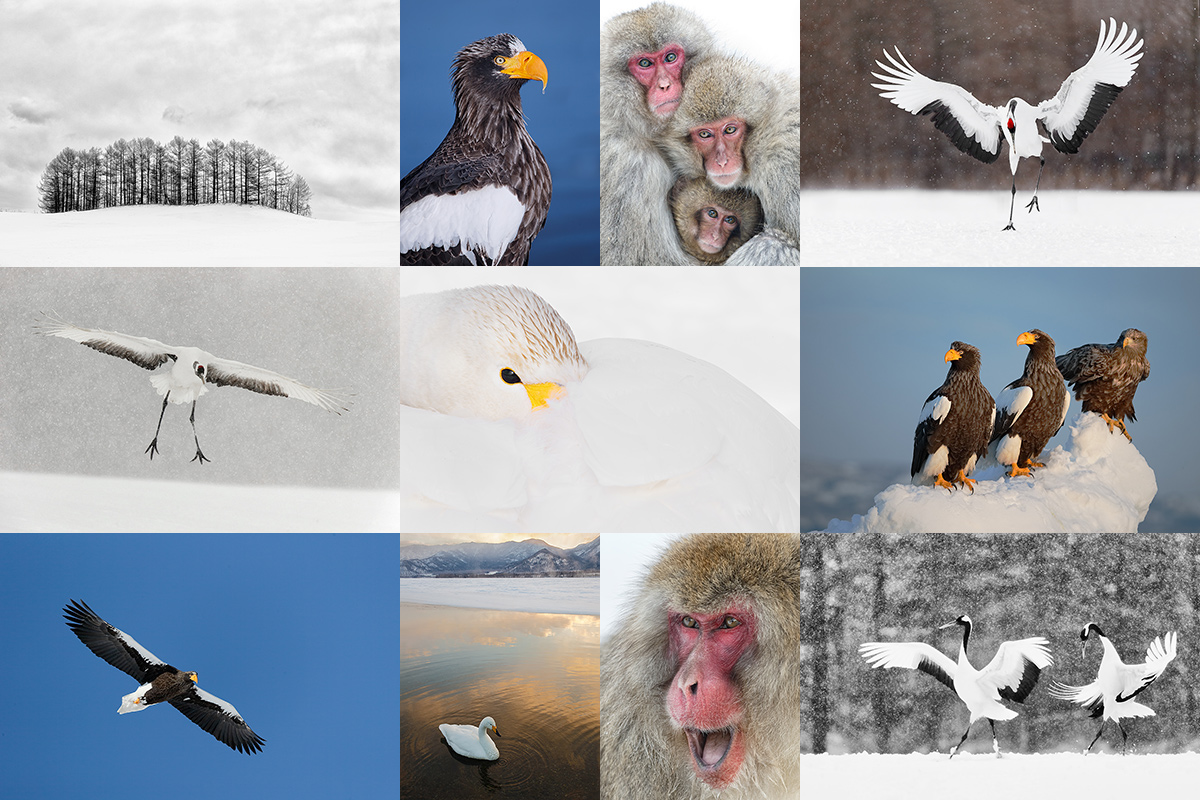
|
|
Consider joining us in Japan in February, 2016; the world’s best Japan in Winter workshop. Click on the card to enjoy the spectacular larger version.
|
Japan In Winter IPT. February 9-24, 2016: $13,999/double occupancy. Limit 7: Openings: 3.
Needs five to run; just 1 more to go. All lodging including Tokyo hotel on 9 FEB, all breakfasts & dinners, ground transport and transfers including bus to the monkey park hotel, and all entrance fees and in-country flights are included. Not included: international flights, all lunches–most are on the run, and alcoholic beverages.
This trip is one day longer than the 2014 trip to allow for more flexibility, more time with the cranes, and most importantly, more time for landscape photography. Hokkaido is gorgeous. Three great leaders plus the world’s best Japan in winter Japanese photography guide: the amazingly creative Denise Ippolito, multiple award winning photographer Paul McKenzie and yours truly. Tons of trip planning and gear advice, in-the-field instruction and guidance, at-the-lodge Photoshop and image review sessions in addition to short introductory slide programs for each of the amazing locations.
|
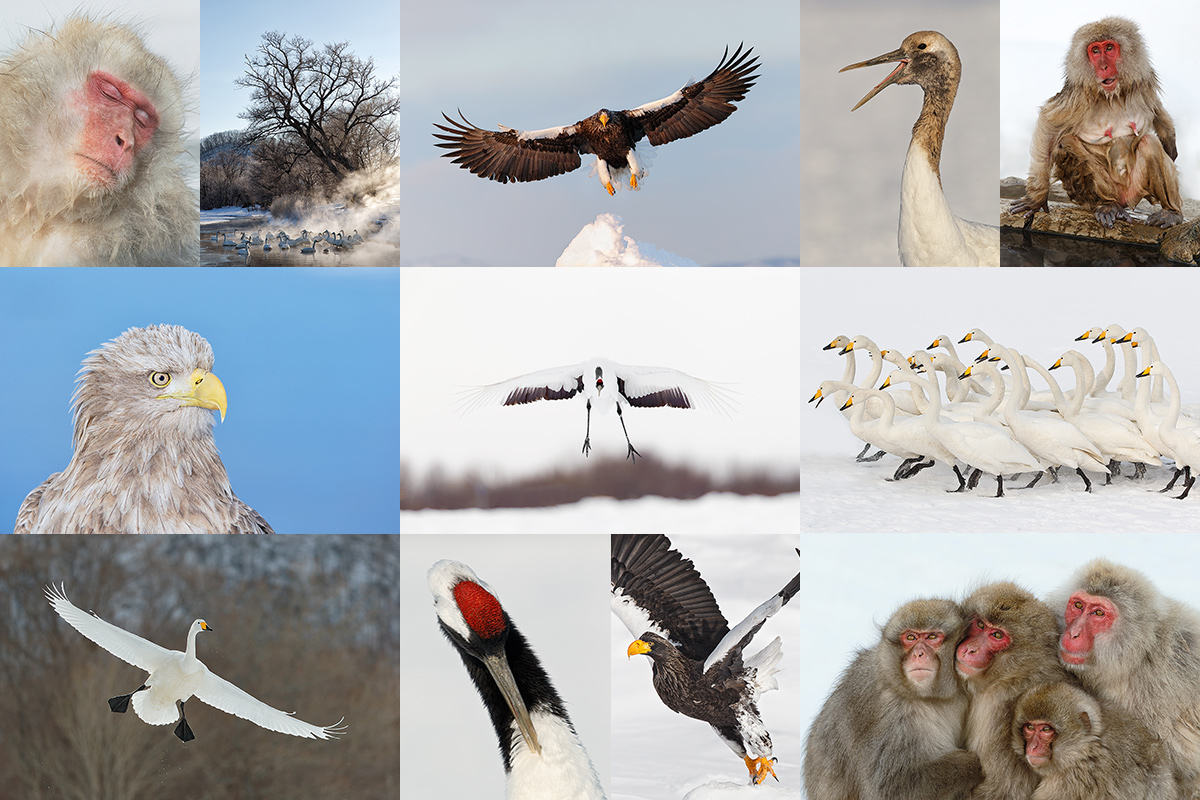
|
|
Amazing subjects. Beautiful settings. Nonstop action and unlimited opportunities. Join us.
|
Arrive Tokyo: 9 FEB 2016 the latest. 8 FEB is safer and gives you a day to get acclimated to the time change. Your hotel room for the night of the 9th is covered.
Travel to Monkey Park Hotel: 10 FEB: Short 1/2 DAY of Monkey photography possible depending on our travel time….
Full Day snow monkeys: FEB 11.
Full Day snow monkeys: FEB 12.
13 FEB: Full travel day to Hokkaido/arrive at our lodge in the late afternoon. The lodge is wonderful. All the rooms at the lodge have beds. Bring your warm pajamas. Local onsen (hot springs bath and tubs) is available for $5 each day before dinner–when you are cold, it is the best thing since sliced bread. Smile emoticon The home cooked meals at the lodge are to die for.
FEB 14-23: Red-crowned Crane, raptors in flight, Whooper Swans, and scenic photography. Ural Owl possible. One 2-night trip to Rausu for Steller’s and White Tailed Sea Eagles on the tourists boats dependent on sea ice conditions. Only our trip offers complete flexibility in this area. It saved us this year. One afternoon of duck photography in the harbor is a strong possibility in Rausu. 2-3 boat trips. In addition, few if any tours offer at least one afternoon boat trip….
Lodging notes: bring your long johns for sleeping in the lodge. In Rausu and the snow monkey park, the hotel the rooms are Japanese-style. You sleep on comfortable mats on the floor. Wi-fi is available every day of the trip.
FEB 24. Fly back to Tokyo for transfer to your airport if you are flying home that night, or, to your hotel if you are overnighting. If you need that room it is on you.
To save your spot, please send your $5,000 non-refundable deposit check made out to “Arthur Morris to Arthur Morris/BIRDS AS ART, PO Box 7245, Indian Lake Estates, FL 33855. We do hope that you can join us for this trip of a lifetime. Do e-mail
|
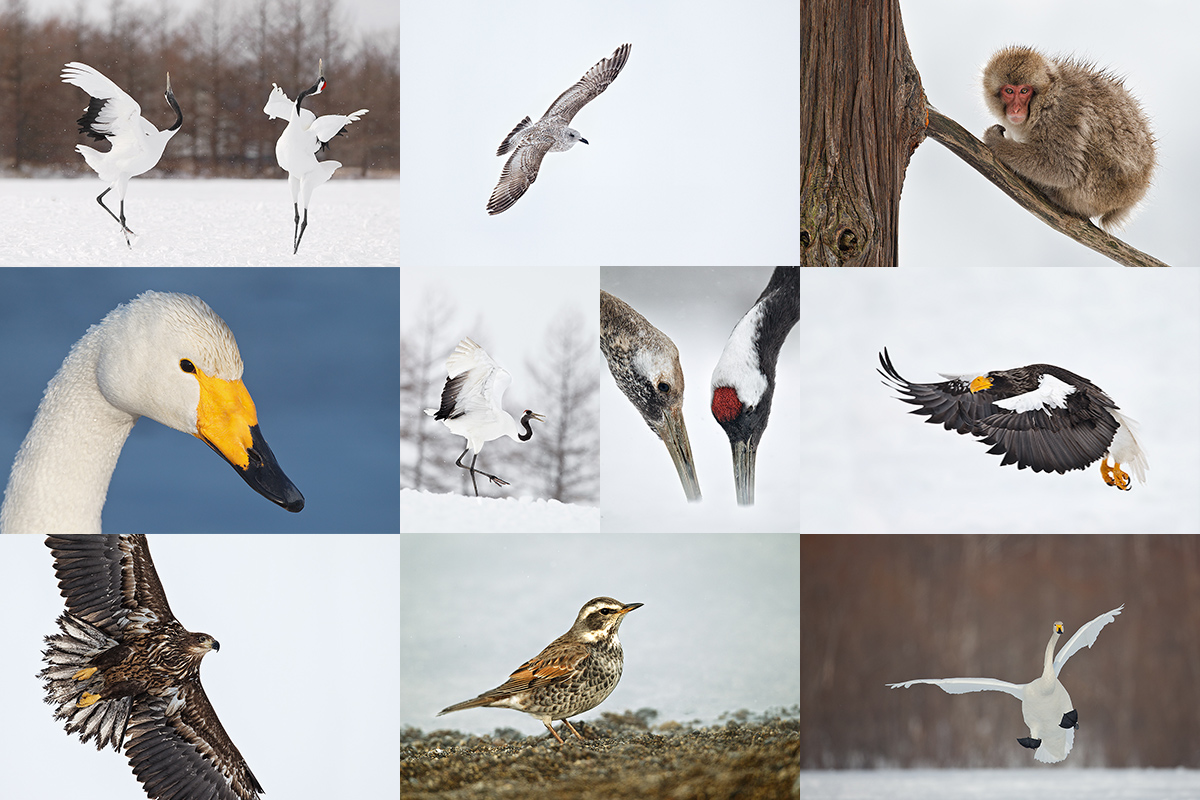
|
|
Life is short. Hop on the merry-go-round.
|
|





